On July 18, Polish paddlesports athlete Sebastian Szubski completed a solo kayak circumnavigation of Great Britain. He covered the 3,000km route in 37 days, finishing three days faster than Dougal Glashier, the previous record holder from 2023.
Szubski began his journey in Western Scotland on June 12 and initially faced challenging waves, fatigue, and changeable weather conditions that are typical of the British coastline. His route led him around Scotland’s rugged coast, down the coasts of England and Wales, across the Bristol Channel, through the Irish Sea, past both Ireland and Northern Ireland, and ultimately back to Scotland.
For much of the route, Szubski was neck-and-neck with Glashier's time, paddling an average of 80km to sustain his target of 40 days.
Key moments
“Scotland welcomed me as if it were paradise on Earth. Beautiful, with seals, views, and no waves because I was hidden among the islands. I decided to start higher than I had planned. It turned out I'd chosen the most beautiful spot in all of Great Britain,” Szubski told Red Bull Poland.
However, on day two, this short-lived idyllic start was replaced by rudder issues, a leak, and rough seas that left him unable to control his boat properly. He narrowly avoided crashing into the cliffs at the famous sea stack of the Old Man of Stoer.

From the seventh day, Szubski’s journey settled into its routine of paddling, eating, and sleeping. He often spent up to 16 hours a day in his kayak. The timing of his efforts was frequently dictated by tidal currents, sometimes requiring pre-dawn starts in gnarly weather. These early rises became essential for staying on schedule.
By the eighteenth day, he reached the halfway point. Navigating past Dover under the cover of night helped him avoid the world's busiest shipping traffic, though technical issues left him without lights or radio communication.
A support team followed Szubski the entire way. On land, recovery was the top priority, although each landing also required recording footage for Guinness record documentation, changing into dry clothes, and eating high-calorie meals. He received massages from his support team and slept, at least at times, in a rooftop tent.
Olympic pedigree
When Szubski announced his intention to circumnavigate Britain by Kayak, some in the British paddling community were skeptical. He had reportedly never kayaked at sea, let alone the rugged British coast, which can be technically challenging and dangerous.
In preparation, in July 2024, Szubski and Sebastian Cuattrin paddled a 200km section of the River Thames in England in just under 22 hours. A few months later, that fall, the Pole visited and trained with Mike Lambert, a former British canoe sprinter who completed a 58-day kayak circumnavigation earlier in the year.

Although born in Poland, Szubski represented Brazil in the 2004 Summer Olympics in the sprint canoe event and the 500m doubles kayak. He also holds the record for the farthest distance by canoe or kayak on flat water in 24 hours -- an impressive 252km.
Fastest known time
Szubski has claimed his circumnavigation as the fastest kayak journey around Great Britain, and a number of news sources have suggested he has broken a Guinness World Record. How Guinness will ratify this record is unclear, as they do not currently appear to have published a comparable record on their website. Also, for some in the adventure community, they are not a credible record-keeping organization.
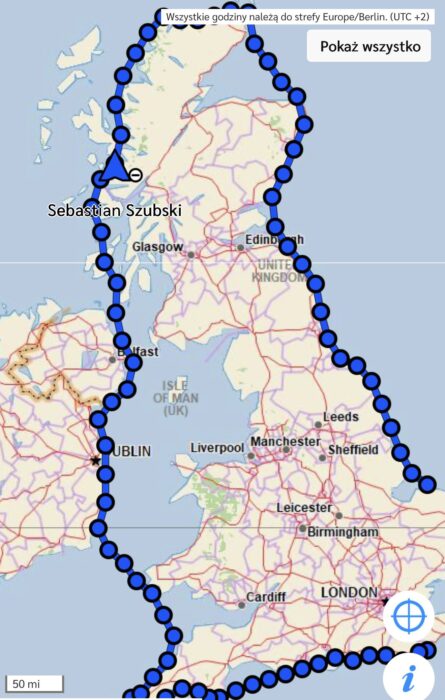
Dougal Glashier previously held the fastest known time, although his route was reportedly 3,120km -- slightly longer than the 3,000km initially reported by Szubski. Both Glashier and Szubski had support crews, but details remain unclear regarding how much they relied on them, whether they camped wild or stayed in accommodations, and how similar their routes were.
In 2012, Joe Leach, the previous record holder, completed the journey in 67 days, a benchmark Glashier surpassed by an impressive 27 days.
Last month, Canadian adventurers Dave Greene and Gaia Aish completed a 1,725km bike and canoe journey from the British Columbia border to the shores of the Arctic Ocean over 30 days.
The pair started on May 22 from the border of British Columbia and the vast Yukon Territory. To begin, they pedalled around 100km to a small settlement by the Yukon River, where they picked up their pre-stashed Canoes. "It was a good little break into the trip. A little gear shake down, if you will," Greene explained.
From here, Greene and Aish set out on a 746km canoe leg along the river, where they faced no major rapids or portages, but low water levels and snow melt made the journey challenging. As a result, they spent long hours in the boat, with paddling sessions stretching to 12 hours a day.
"We managed to cover significant distance by doing that; we were paddling 60, 70, sometimes 80km in a day," Greene reflected.
Yukon delights
Despite the long days, Greene enjoyed the Yukon River: "It was an incredible part of the trip, maybe the most memorable part for us."
This may have partly been because the two Canadians were treated to a host of wildlife sightings, including both moose and bears with babies, lynx, sheep, wolves, and even a wolverine.

Greene and Aish carried their bikes in the canoe down the Yukon. When they eventually reached the end of the canoe leg in the historic gold rush town of Dawson City, they left their rented canoes with a company that returned them to the south.
At Dawson, the duo got back on their bikes. On June 12, they headed out onto the Dempster Highway, Canada’s only road north to the Arctic Ocean. The cycle north took twelve days, and the 940km they covered was hard earned.
Greene and Aish pedalled through a summer heatwave, prompting night rides to avoid the intense heat. The gravel road and dry climate made finding drinkable water difficult, as well as turning the ride into a dusty affair.
"The Dempster is a gravel road. So, being as hot as it was, it was also extremely dusty. We had dirt kicked into our faces, in our ears at all times," Greene said.
The Midnight Pedal Paddle Party
A benefit of riding this far north is the extended daylight hours, hence Greene dreaming up the expedition moniker, the "Midnight Pedal Paddle Party."
"We were north of the Arctic Circle for the majority of this bicycle ride, which means that the sun was not setting. So we had 24 hours of daylight, which, after a certain amount of time, one just gets used to. You get tired enough that you can just lie down and sleep, but it also allowed us to ride our bikes whenever we wanted," Greene explained.

To ease some of the weight burden while cycling, Greene and Aish turned to the Dawson City Visitors Center, which allows cyclists to leave food boxes for pickup by drivers heading to Eagle Plains Hotel, a pit-stop 500km into their route. Additionally, they had a friend in the Northwest Territories, so they met with them to collect another box of food. At most, they had to carry seven days of food at a time.
To the ocean
The final 150km from Inuvik to Tuktoyaktuk were the most demanding of the expedition, thanks to the freshly gravelled road.
"It was four to six inches of fresh gravel and we had to push our bikes up all of the hills, because it was simply unrideable," Greene recalls.

Their spirits picked up when they reached the Arctic Ocean and the community of Tuktoyaktuk on June 23, marking the end of their trip.
"Getting to the Arctic Ocean was quite the thrill. The community of Tuktoyaktuk is an Inuit community in Canada, and we happened to arrive the same day they were having their indigenous day, a territorial holiday," Greene said.
Naturally, the weary -- and no doubt sweat-encrusted -- cyclists celebrated by jumping into the Arctic Ocean.
A group of young people from several Native American groups has completed a month-long journey down the Klamath River. The journey commemorates the removal of four dams, leaving much of the river to flow freely for the first time in a century.
Years in the making
Indigenous activists had been fighting for decades by the time the Klamath Basin Restoration Agreement was signed in 2010. The agreement promised to remove the four hydroelectric dams on the Klamath River. In November of 2022, federal approval finally came through for the dam removals.
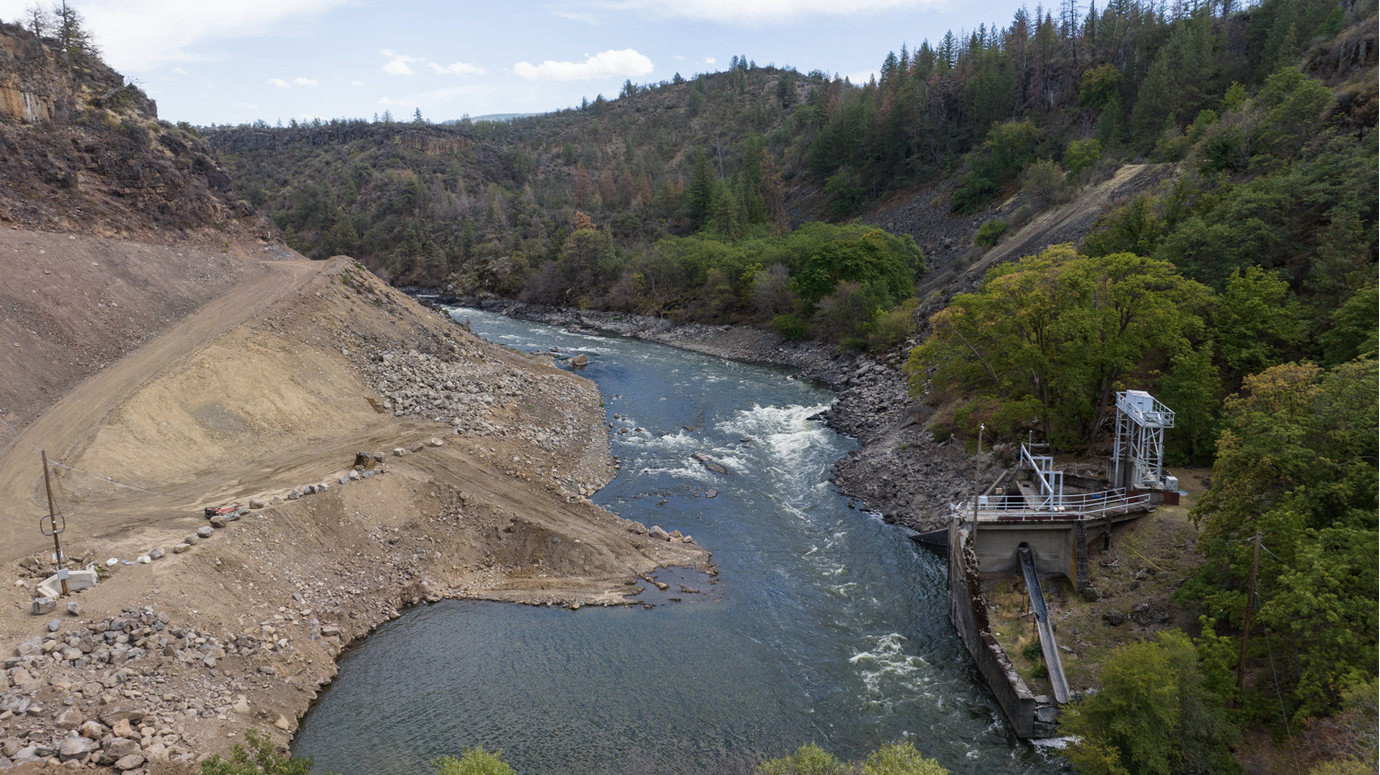
The first and smallest, Copco No. 2 Dam, was removed in 2023, 98 years after it was built. In 2024, the other three dams -- Iron Gate Dam, Copco No.1 Dam, and JC Boyle -- were removed as well.
Paddle Tribal Waters, a nonprofit program teaching kayak and river advocacy to Indigenous youth from all along the Klamath basin, launched in July 2022. After years of training, 43 young kayakers ranging from 13 to 20 set out on June 12 from the Southern Oregon headwaters. There are still two dams remaining, near the headwaters, which they had to portage around.
The journey took them through canyons with rapids as well as across the choppy Agency Lake and through the dam removal sites. Those who had clearance tackled class 3, 4, and 5 rapids, while others chose to take those sections by raft.
In the last few days, even more young people joined. Youth from indigenous communities in the United States, Chile, Bolivia, and New Zealand took to the water. By July 11, a veritable flotilla, 110 strong, approached the mouth of the river. There, friends, family, and community members waited to welcome them.

A historic return
Now that the river flows freely, the ecosystem is beginning to repair itself. Important species like salmon, steelhead, and lamprey can now access over 600km of historic spawning habitat. The drained reservoirs no longer cause massive algae blooms, so the water quality is increasing and the temperature is decreasing. The speed of the river's recovery is a heartening surprise, even to its staunchest advocates.
"We were hopeful that within a couple of years, we would see salmon return to Southern Oregon. It took the salmon two weeks," said Dave Coffman, in a conversation with CNN. Coffman is the director of northern California and southern Oregon for Resource Environmental Solutions, which is working to restore the Klamath.
Klamath fish populations are a vital resource for Indigenous people along the basin, primarily the Klamath, Shasta, Karuk, Hoopa Valley, and Yurok peoples. But though salmon can now return, they return to a very different habitat. Industrial farming has reshaped and polluted the Klamath, and the federal government has frozen much of the funding for restoration.
The trip wasn't just a celebration, but a commitment to continue the fight. "It’s not just a river trip and it’s not just a descent to us," said Hupa tribal member and Yurok descendant Danielle Frank, a participant who gave a speech at the celebration. "We promise that we will do whatever is necessary to protect our free-flowing river."
An all-female team known as the "Hudson Bay Girls" is more than a month into a self-supported 1,900km canoeing expedition from Grand Portage on Lake Superior to York Factory on Hudson Bay.
Their route follows traditional waterways first traveled by the Anishinaabe people, and later used by French fur traders in the 18th and 19th centuries to connect remote trading posts across the Canadian wilderness.
The journey, expected to take 85 days, began at the end of May with a challenging 13km portage, known locally as "Grand Portage." From there, the team paddled 400km through the pristine Boundary Waters wilderness area, which is threatened by proposed mining projects.

Building on experience
The team has plenty of paddling and wilderness experience, having collectively paddled over 6,400km. The foursome of Olivia Bledsoe, Emma Brackett, Abby Cichocki, and Helena Karlstrom has varied backgrounds, including roles as wilderness canoe guides, wilderness medical technicians, and trail maintenance foremen in the Boundary Waters and Quetico Provincial Park.

The Route Ahead
Recently, the expedition passed through Voyageurs National Park. They stopped to resupply at the city of International Falls, Minnesota, which straddles the U.S and Canada border. The next leg of their journey involves paddling north across Lake of the Woods, a vast body of water notable for its thousands of islands and indigenous heritage.
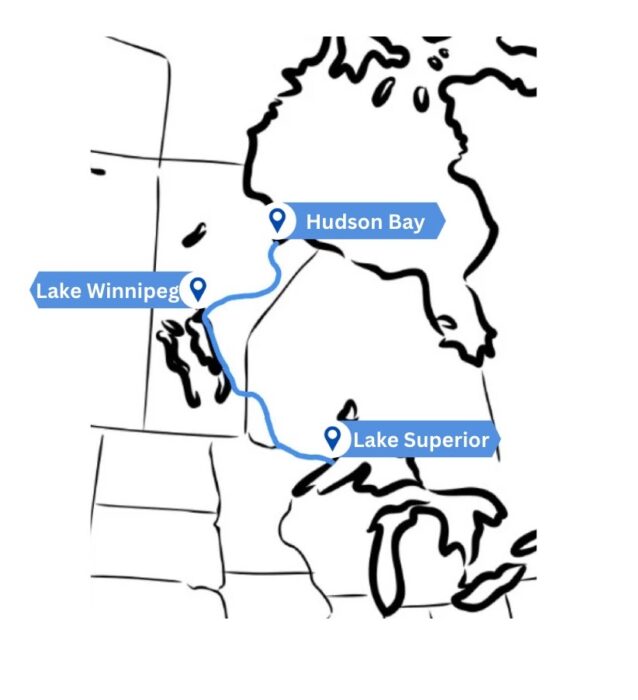
Following Lake of the Woods, the team will navigate the 240km Winnipeg River. From there, they'll paddle along the eastern shores of Lake Winnipeg for three to four weeks, likely contending with shallow waters and large swells.
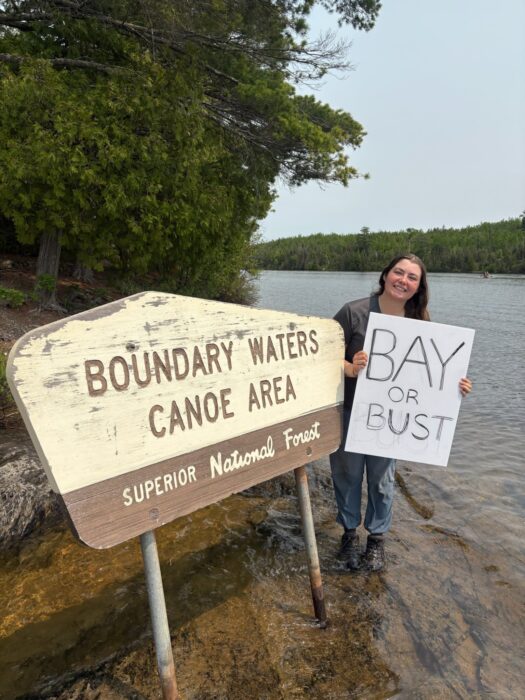
The expedition's final stretch is the 480km Hayes River, a Canadian Heritage River historically used by the Hudson Bay Company as a key trading route. The river transitions dramatically from boreal forest to sub-arctic tundra and is home to several Cree communities.
All being well, the Hudson Bay Girls' journey will culminate at York Factory -- a historically significant trading post pivotal to Canada's fur trade era -- in Hudson Bay.
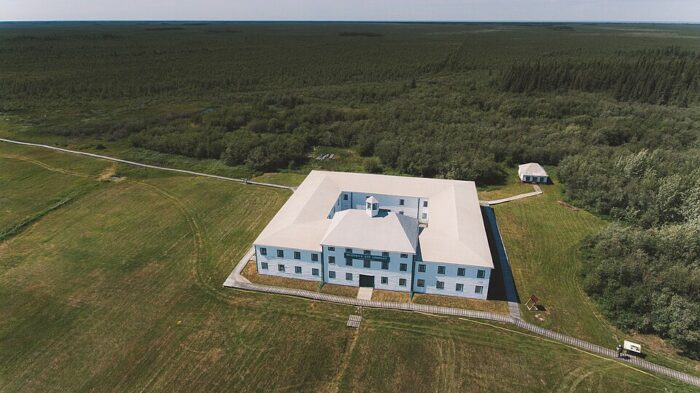
About 30,000 years ago, humans arrived in Japan's southern Ryukyu Islands, 110km from Taiwan.
The archaeological record hasn't preserved any clues as to how these Paleolithic people made the crossing to this new land. But the obstacles to doing so seem, at first glance, insurmountable without modern technology and knowledge. So in 2013, a group of Japanese archaeologists set out to recreate the trip using only Paleolithic tools.
This week, they published the results of their experiments in the journal Science.
A challenging crossing
Archaeologists find evidence of humans in the Japanese archipelago as early as 35,000 BCE. Judging from the dates at different archaeological sites, the earliest inhabitants of Japan seem to have migrated both northward from Taiwan and southward from Korea.
But from the Taiwanese coast, the low-lying islands of Ryukyu sit below the horizon. One of the strongest currents in the world, called Kuroshio ("Black Tide"), runs northward from Taiwan. It carries any lackadaisical drifters west of the Ryukyu Islands at a velocity of one meter per second. And a distance of 110km from Taiwan to the nearest Ryukyu island, Yonaguni, was no joke for people without metalworking or sails.
Yet they made it.
When the Japanese archaeologists set out to recreate this trip, they didn't have an easy time. They tried reed-bundle rafts and bamboo rafts, both of which floundered in the strong current. The bamboo also began to crack and fill with seawater, further weighing it down.

The beginning of the voyage
In July of 2019, the team attempted one final trip. They launched Sugime, a hand-made dugout canoe, from the coast of Taiwan in typical calm summer weather.
Construction of the dugout started in 2017. The team used replicas of stone axes found in Japanese Paleolithic sites to fell a one-meter-thick Japanese cedar tree. They peeled off the bark and carved a seating area in the center of the trunk. While dugout canoes from the Paleolithic haven't survived in Japanese archaeological sites, dugouts from the later Jōmon period (starting around 14,000 BCE) boast burn marks on the inside. In turn, the team polished the inside of their craft with fire.
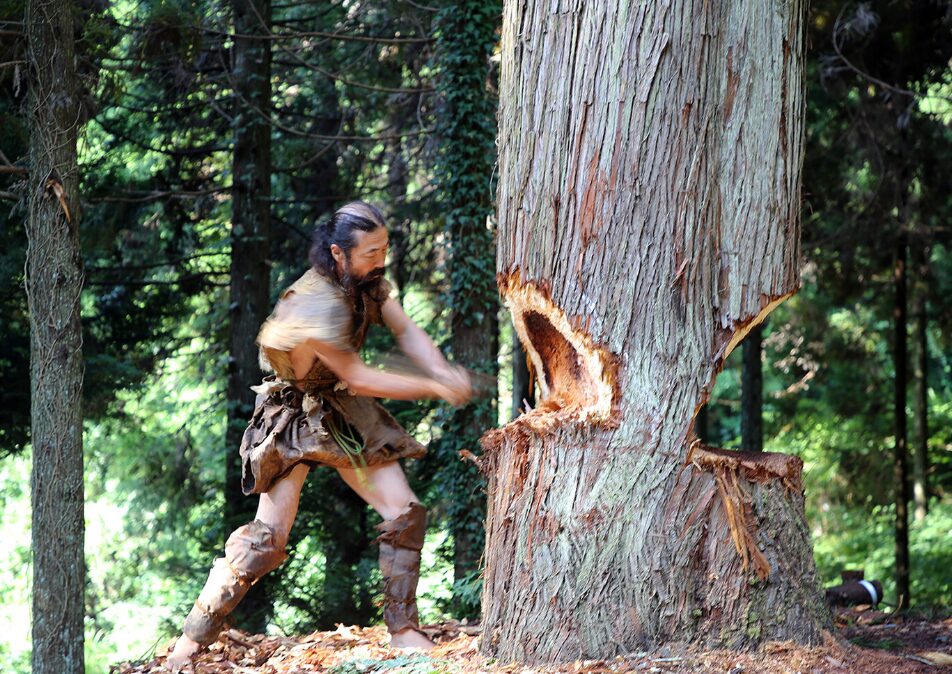
The plan was simple: to row from Wushibi, on the eastern coast of Taiwan, across the strait to the small Ryukyu island of Yonaguni. A motorized ship with safety supplies would escort the Paleolithic reenactors.
Sugime's crew consisted of five paddlers, four men and one woman. For the first hour and a half of their journey, they skidded over a calm sea, with only wispy clouds on the horizon. Then the water depth dropped, and they hit the edge of the Kuroshio. The wind slammed into the current, giving rise to choppy water and an ever-present swell as high as the side of their boat. One of the crew had to pause paddling to bail out the dugout over and over again.
They kept rowing into the night. The wind dropped slightly, but the dugout kept threatening to capsize in the strong swell. There was no rest that night, and it was a constant fight to keep the nose of the dugout pointing northeastward. As the water approached a flow of 1 m/s, the dugout pivoted northward along with the current.
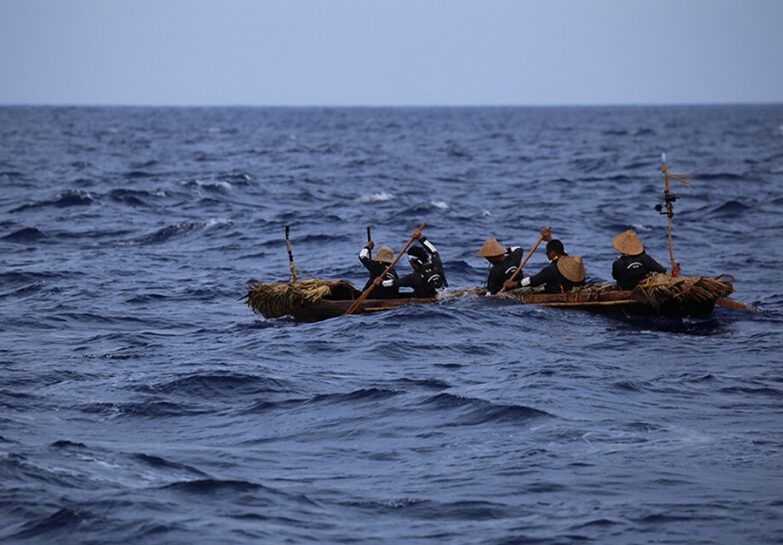
Just as steering the boat was a challenge, so too was figuring out where to steer it. Clouds obscured the stars, and GPS wasn't an option in the Paleolithic. Only the direction of the swell indicated which way was north.
As midnight approached, the wind dropped and stars appeared. The paddlers took turns resting. But in the early hours of the morning, clouds once again obstructed the stars. At 3:40 am, while the captain was taking his rest, one crew member thought she saw dawn on the horizon. The crew pointed the dugout accordingly.
Then the captain woke up. The dugout was traveling due north, dragging them off course from their destination. He realized that far from being dawn, the light on the horizon was from the northern cities of Japan and was reflecting off the clouds. Sugime turned eastward once more.
Exhaustion and triumph
The next day dawned bright. Still unable to see their destination, Yonaguni Island, the crew kept paddling east-southeast to combat the current of the Kuroshio. Unbeknownst to them, however, they had left the Kuroshio behind them. They were now heading due east, away from Yonaguni.
They had already exhausted all the water they had packed for the voyage. Tired and thirsty, they called in a resupply. At noon, finding themselves in calmer waters and realizing they had left the Kuroshio, the whole crew slept for half an hour.
As they paddled into the afternoon, Yonaguni still failed to appear. They steered the dugout this way and that, hoping it would peek above the horizon. It didn't. Moreover, the crew was exhausted. Some of them jumped into the ocean to rest in the cool water. But nothing prevented the onset of excruciating muscle cramps and, as evening drew close, hallucinations.
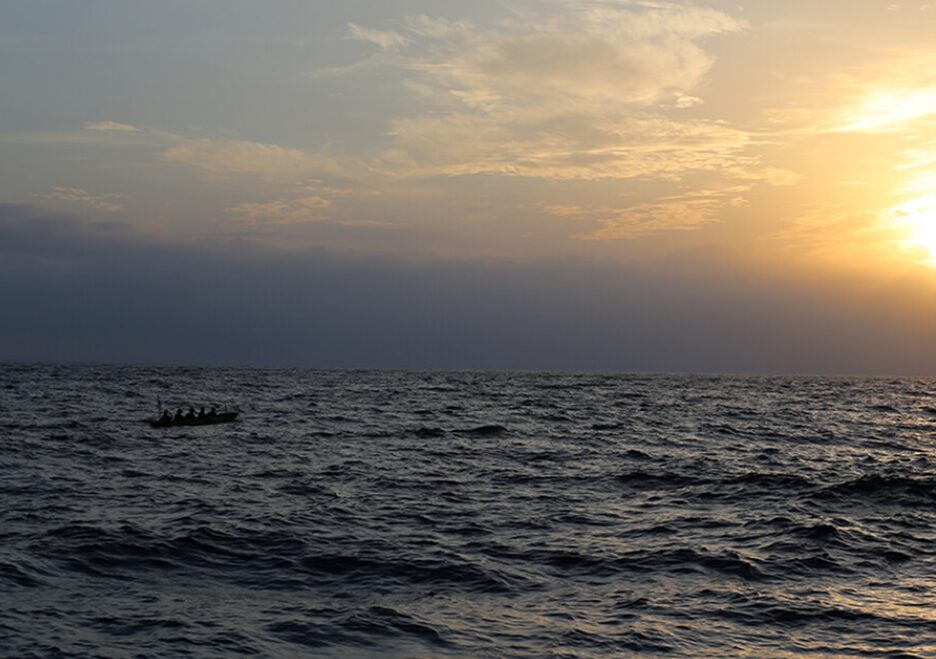
Then, just before the sun set, a bird flew overhead. Before this, the sea had been lifeless and isolated. Now, land was near, even if they couldn't see it.
The sun was so intense that the food they had brought with them began to rot. They obtained replacements from the escort ship and ate a dinner of rice balls and noodles. As night slid in, the crew rested while the boat drifted loose on the water.
The captain kept watch. He thought he saw the glint of a lighthouse on the horizon that he hoped was from Yonaguni. As it turned out, it was an optical illusion, but the swell carried the dugout gently northeastward. In the early hours of the morning, the actual light from Yonaguni's lighthouse appeared on the horizon.
When the crew awoke in the dark hours before dawn, they began the final stretch of their journey toward it.
It was not until just after dawn on the third day that the crew finally saw Yonaguni Island. They were 20km from shore and had been rowing for over 40 hours.
Five hours later, they reached land. Since their crew included Taiwanese paddlers, they had to follow immigration protocol and land Sugime at a predetermined beach. Paleolithic explorers, presumably, did not have this restriction.
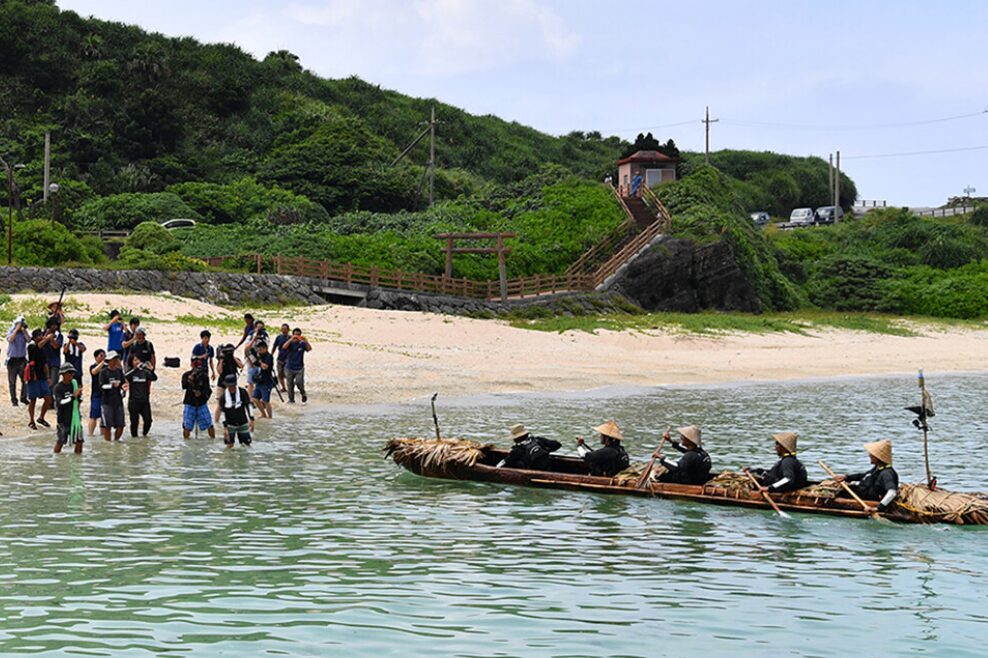
Piecing together a Paleolithic voyage
The crew had made it. Dugout canoes, unlike reed and bamboo rafts, can cross the Kuroshio. But at various points during the trip, the crew's mistakes had worked in their favor. When they rested, the swell naturally carried them in the right direction. And the first hint they saw of Yonaguni was from a lighthouse, which does not feature in Stone Age archaeological sites. Was their success a fluke?
To test this, the team used the data from their paddling to simulate hundreds of dugout voyages starting from different points in Taiwan. They used both modern and Paleolithic oceanographic models to approximate the flow of the Kuroshio, varying the strength of the current between ebbs and peaks. As long as the virtual boats paddled in the right direction, they made the crossing, even when the Kuroshio was at its strongest.
But the voyage could not be completed by accident. The Kuroshio does not carry mariners from Taiwan comfortably to the shores of Yonaguni. Paleolithic humans had to identify the direction and strength of the Kuroshio and plan their voyage accordingly.
They also had to know Yonaguni was there. From the coast of Taiwan, it is not visible. Only when one climbs the mountains in the north does the little speck of island appear over the horizon. The summit of the highest of these mountains sits at nearly 4,000m.
This research in experimental archaeology shows that inhabitants of Taiwan 30,000 years ago did not drift aimlessly towards the Ryukyu Islands. They climbed mountains, they built sturdy boats, and they knew how to chart a course against one of the strongest currents in the world.
Canadian adventurer Frank Wolf and teammate David Berrisford have finished a 720km sea kayaking expedition through southeastern Alaska. Originally planned as a 900km circumnavigation of Prince of Wales Island, the pair had to change their route due to heavy spring storms.
"We had to sit out two of the first six days due to heavy southeast storms," Wolf reported. "We adjusted to our Plan B route...that would give us more cover for the 25 days we'd budgeted."
The trip marked the first Alaskan kayak expedition for both paddlers. Wolf has extensive experience along the British Columbia coastline, but Alaska was an entirely new challenge.
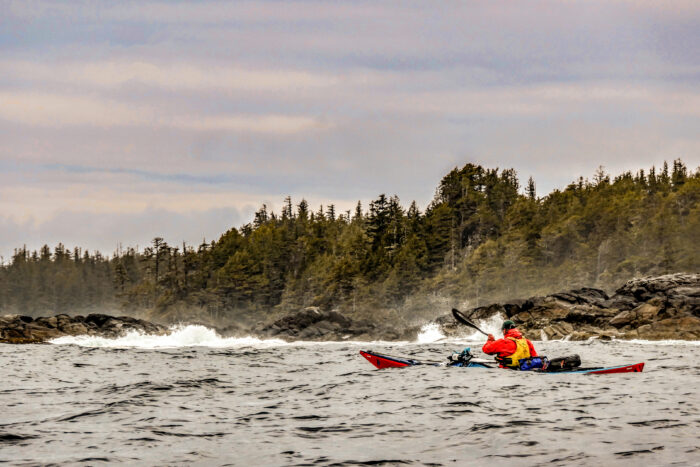
Their adapted route involved several open water crossings ranging from 8 to 14km, with strong currents and waves.
While the route changed, the rewards remained. The team paddled through temperate rainforest coastlines, camped in old-growth forests, and saw brown bears, orcas, humpback whales, porpoises, sea otters, and elk.
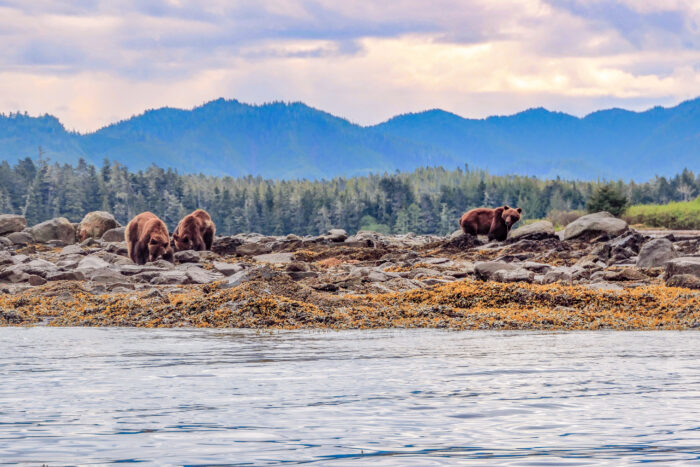
A nine-day storm
As the team neared the end of their journey, a series of powerful storms hit them just 90km from their final destination of Prince Rupert, British Columbia.
“We were pinned in just above Cape Fox in Alaska, where the entire fury of the notorious Hecate Strait slams,” Wolf reported. The strait is known for producing some of the largest waves in the world.
With time running out and no transport options available across the Canada and U.S. maritime border, the pair eventually asked members of the Nisga'a First Nation to pick them up during a brief break in the weather.

“There is no ferry or other transport service over the border, so in the end only the Nisga'a...could get us,” said Wolf. The Indigenous group has special status, allowing them to move freely over the borders.

Earlier this month, three kayakers completed a 32-day expedition through remote southern Patagonia. They covered nearly 900km of isolated fiords and rugged coastline.
Mathew Schweizer and Brody Duncan of New Zealand, along with Andy Gill of Scotland, began in Puerto Edén, a remote fishing village in the Magellanes region of Chile.
Before setting out, the group underwent an official gear inspection from the Chilean Navy.
“We had a naval inspection to check all our gear and get signed off… We needed to get permits from the Navy,” said Schweizer.
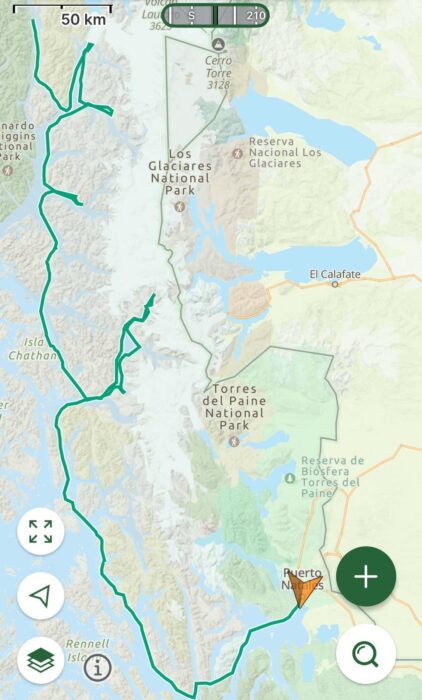
South America's largest glacier
Before heading south, the team paddled north from Puerto Edén to the Pio Xi, the largest glacier in South America.
“Absolutely huge, about five kilometers wide,” Schweizer noted.
They explored nearby fiords but had to turn back because of dense ice.
“The amount of ice that was coming out was just too much for us to paddle up into. Just big big ice pack.”
Their journey included an overland portage through a lake system.
“It was pretty hard work, unloading all the gear and hiking through some hard terrain, and then carrying kayaks up and over hills and into these lake systems,” Schweizer said.
Later, they entered Peel Fiord, a vast network of channels stretching roughly 70km. At its northern end lies Seno Andrew Fiord, which Schweizer described as a standout moment. “Just amazing. Four or five glaciers running straight down into Seno Andrew [Fiord].”

The coastal fiords of Patagonia, located in the Magallanes region of southern Chile, are among the most remote and least inhabited areas of South America. Known for challenging weather and dramatic glacial landscapes, the region is accessible only by boat or on foot.
Rough paddling weather
Adverse weather was a challenge throughout the 32-day trip.
“Probably four-and-a-half-foot waves,” Schweizer recalled of one particularly rough stretch.
The team also faced equipment failures. “Broken holes and tents, broken sleeping mats, well, my broken sleeping mat had fifteen or so puncture repairs on it. It just failed on me.” Strong winds also shredded their tarp.
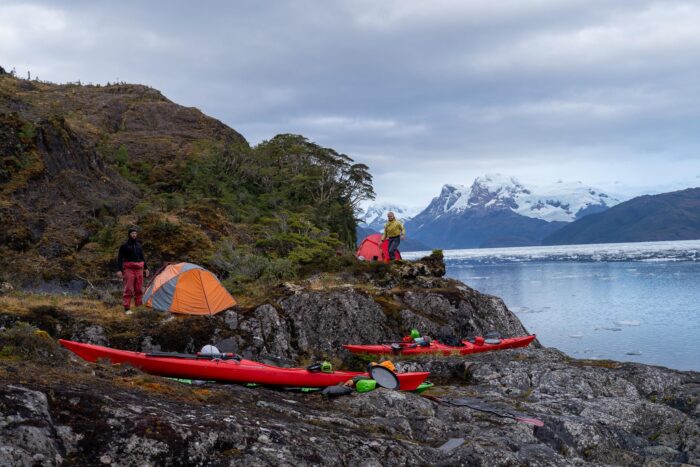
In total, they covered 850 to 900km, and ended in Puerto Natales, a port city a few hours of Punta Arenas, the jumping off point for flights to Antarctica.
The isolation of the route demanded complete self-reliance.
“Once you start paddling from Puerto, you have no other villages, no other civilization to come across…There's no help. There are no people out there,” said Schweizer.
In two weeks, Dave Greene and Gaia Aish will set out on a 1,700km canoe and bike journey through northwestern Canada to the shores of the Arctic Ocean.
The pair, who are life partners as well as teammates, will start biking from the Yukon-British Columbia border. After 100km, they will retrieve their canoe at Johnsons Crossing, a small settlement at the head of the Teslin River.
They then swap pedal power for paddle power, stowing their bikes in the canoe. Over 12 days, they will canoe 750km down the Teslin and Yukon Rivers to Dawson City. From this famed Gold Rush town, the pair will reassemble their bikes and ride 940km north over the Dempster Highway to Tuktoyaktuk in the Northwest Territories.
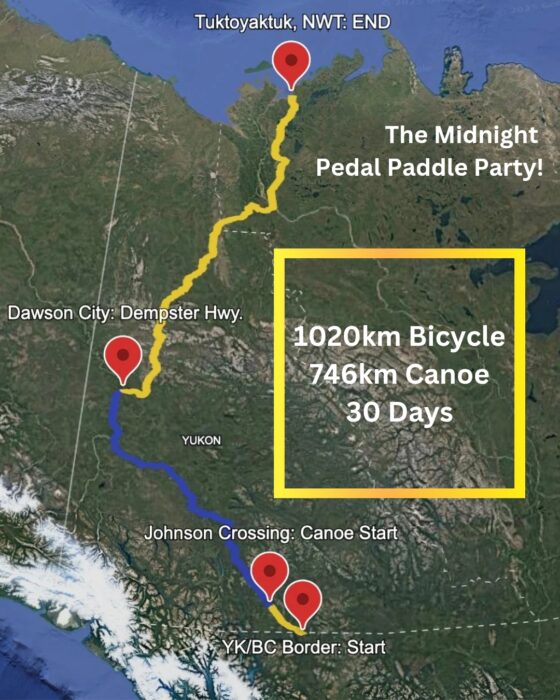
The Dempster Highway is Canada’s only road north to the Arctic Ocean. As they cycle north on this gravel road, Greene and Gaia will cross two mountain ranges -- the Ogilvie and the Richardson -- before descending to the Mackenzie River delta at Inuvik and ending in Tuktoyaktuk. On the first section of the Dempster, the pair will hike in the striking Tombstones range.
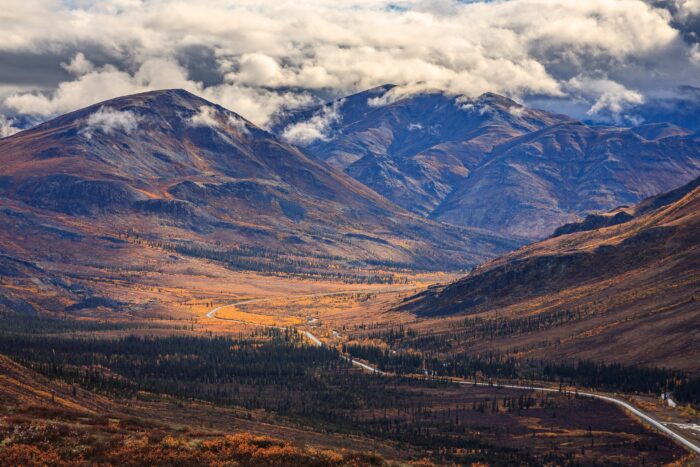
Greene and Gaia are based in Nova Scotia and are currently on sabbatical from their jobs in education. Last month, Greene completed a 400km ski crossing from Akulivik to Kangiqsujuaq in northern Quebec. Before that, he had undertaken nine canoe, ski, or bike journeys. Aish has previously canoed in Labrador. They estimate their trip will take 30 days.
This weekend, Canadian adventurer Frank Wolf and teammate David Berrisford will start a 900km sea kayak journey in the waters between Alaska and British Columbia. Starting and ending at Prince Rupert, B.C., the duo will paddle around Prince of Wales Island, off the Alaskan Panhandle. It is the fourth-largest island in the United States.
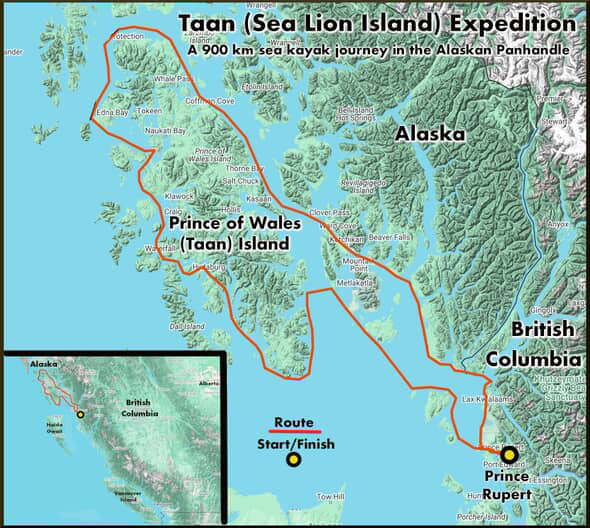
“I’m not too sure what we’ll find up there - it’s a new zone to us,” said Wolf, who has made many human-powered journeys around North America. “I’ve pretty much paddled the entire British Columbia coastline, so pushing up to explore the Alaska coast is the natural next step. There will be a few big crossings along the way, and outer coast spring conditions to contend with.”
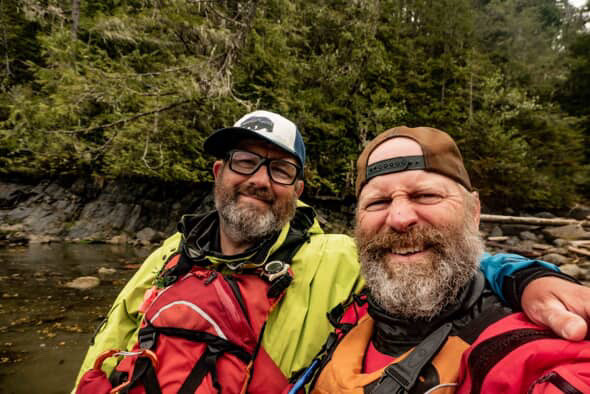
Prince of Wales Island is the home of the indigenous Tlingit peoples and is known locally as Taan, the local Tlingit word for sea lion. In Tlingit culture, sea lions symbolize endurance.
The journey is expected to take Wolf and Berrisford around 25 days.
Johnny Coyne has become the first person to kayak from Ireland to Asia. The Irish adventurer set out in September 2024 with Liam Cotter. Countryman Ryan Fallow joined the duo later. But only Coyne did the entire distance.
At first, he and Cotter crossed the Irish Sea and the English Channel without support vessels. Then they navigated through numerous European rivers and canals. It wasn't easy -- and not just because of the physical effort.
In France, they didn't have the right permits, so they were banned from the canals. By the time they sorted that out, the waterways were frozen. Determined to keep their journey human-powered, they dragged their kayaks 350km cross-country through France and then Germany’s Black Forest to the source of the Danube.
This lengthy portage was one of the hardest parts of the expedition. At one point, the wheels of their kayak cart broke, and they were forced to stop for weeks. Winter took hold, and the temperatures plummeted.
Onto the Danube
In Germany, Ryan Fallow joined the expedition, and the trio took to the Danube. The three paddlers were used to rapids, but anticipating the right lines on an unknown river was nerve-wracking. In Austria, disaster struck. Cotter’s boat smashed into rocks in some rapids, opening a significant hole. But chance smiled on the young travelers: They stumbled across two good Samaritans -- one who repaired the boat and another who replaced Fallow’s old, unsuitable vessel with a newer one.
Back on the Danube, Cotter dislocated his shoulder during a portage and could not continue. Coyne and Fallow soldiered on through Slovakia and Hungary, where more border crossing problems ensued. On their first night in Croatia, police surrounded their kayaks, convinced they were illegal immigrants.
Yet the pair persisted with unwavering positivity. From Croatia, they paddled through Serbia, Romania, and Bulgaria, resupplying at various towns. Most of the time, they camped along the riverbank but occasionally accepted hospitality from locals.
As the months passed, their equipment began to fail. Their tent leaked, and some of its poles had been lost. By the end of their eight-month crossing, it was held together with tape and sticks.
The Black Sea at last
At the start of April, 210 days after setting off, they reached the Black Sea, their last major milestone before Istanbul. The next big goal was to reunite with Cotter so that he could join them at the finish. After the shoulder injury, Cotter couldn't paddle but he had remained in the wings, helping with logistics. Now the trio wanted to finish together.
Cotter wanted to stick to their human-powered plan, so as soon as his shoulder mended enough, he started cycling to catch up with his pals in Bulgaria. On day 225, he rejoined them after three months apart, ready to kayak with them for the last week.
The final week started with paddling from Bulgaria into Turkey. Once again, the border crossing was anything but simple. Coyne tried to arrange their entry with the Coast Guard, and a customs boat met them as they approached the border.
However, it informed them that they were not allowed to land. They had to wait on the Bulgarian side in their boats for three hours. The temperature dropped, the water became choppy, and it was dark before they were allowed to get off the water. But still not in Turkey.
Another troublesome border
On the beach, police questioned them and searched their kayaks. As they slept that night, the police refused to leave, to ensure they would not cross the border overnight. The next morning, they were finally allowed to cross into Turkey.
With four days left, their excitement was palpable and only increased when a pod of dolphins swam next to them as they paddled along the Turkish coast. On April 25, they landed in Istanbul to cheers from the friends and family who had come to meet them.
“This has been the greatest moment of my life so far,” Coyne commented as he exited his kayak.
Kitturiaq chronicles a 620km canoe expedition across the Labrador plateau down the George River in Canada's northern Quebec. Professional adventurer Frank Wolf undertook the journey with partner Todd McGowan.
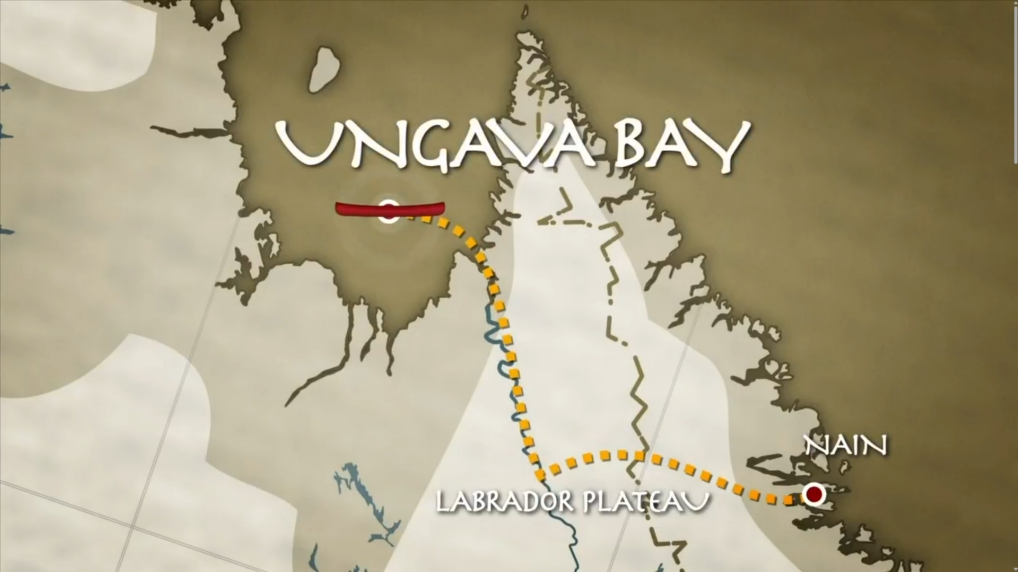
Wolf is bold in adventure planning and is perfectly willing to be bold in filmmaking, too. The film's narration is delivered by a fictional mosquito who chooses to tag along as an unofficial third party member. In fact, the Inuktitut word for mosquito gives the project its title.
Meanwhile, the Kitturiaq, named Malina, shares the story of explorer Hesketh Hesketh Prichard. (Evidently, his parents felt that one "Hesketh" wasn't enough.) Through Malina's narration, the story of the Briton's failed 1910 attempt to complete the route unfolds simultaneously to the main action.

The journey begins in Nain, now the northernmost town on the Labrador coast and the administrative capital of the Inuit region of Nunatsiavut. There, Wolf interviews local community leaders about the land his upcoming journey will take him through.
A 600m climb, with canoe
The first stage takes them a little north to the giant Fraser Canyon, which they must scramble up to the Labrador plateau. Malina's blackfly relatives are thick in the air, just as locals warned they would be.
But it's the portage they have to make that is the real killer. With no waterway to follow, they have to unload their gear, then drag it and the canoe 600m up a crack in the cliffs called Poungassé to the top of the plateau. Sweat and blood cover them both by the time they reach camp, and McGowan suffers sunstroke. The long subarctic summer day can be blisteringly hot.
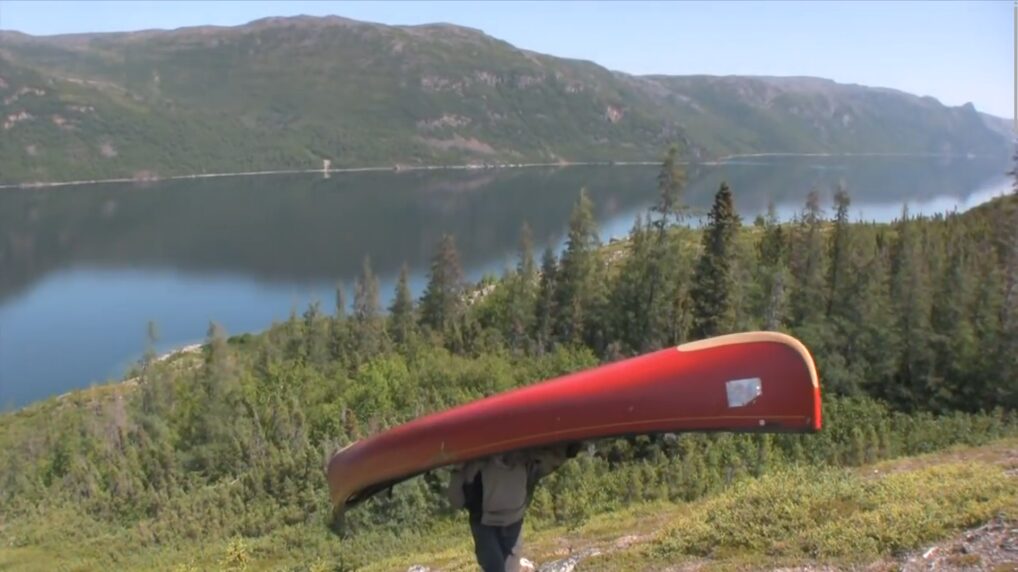
They're still doing better than Prichard, who took a steeper route and ended up abandoning one of his canoes. Atop the plateau, Prichard saw no waterways -- the plateau is mostly swamps and shallow ponds in this area -- and abandoned his last canoe, continuing on foot. Wolf and McGowan elect to drag theirs. After a brief descent into fly-induced madness, they're back on the water.
"People have been here, a long, long time before us," Wolf reflects, examining a piece of wood. No trees grow on the tundra, so an Inuit hunter must have brought the discarded log on his sled, or komatik, years before. This small moment is a quiet reflection on a core theme of the film.
The paddling and portaging continue. "They're beginning to act a little strange," Malina notes. A headnet makes a reappearance.
When they make it to Nunavik, they go fishing, while Nain politician Johannes Lampe reflects through a previous interview about how prohibitively expensive food is this far North. Caribou is much more cost-effective than groceries, and fishing is cheaper than buying fish. The land takes care of you, Lampe explains, when you take care of it.
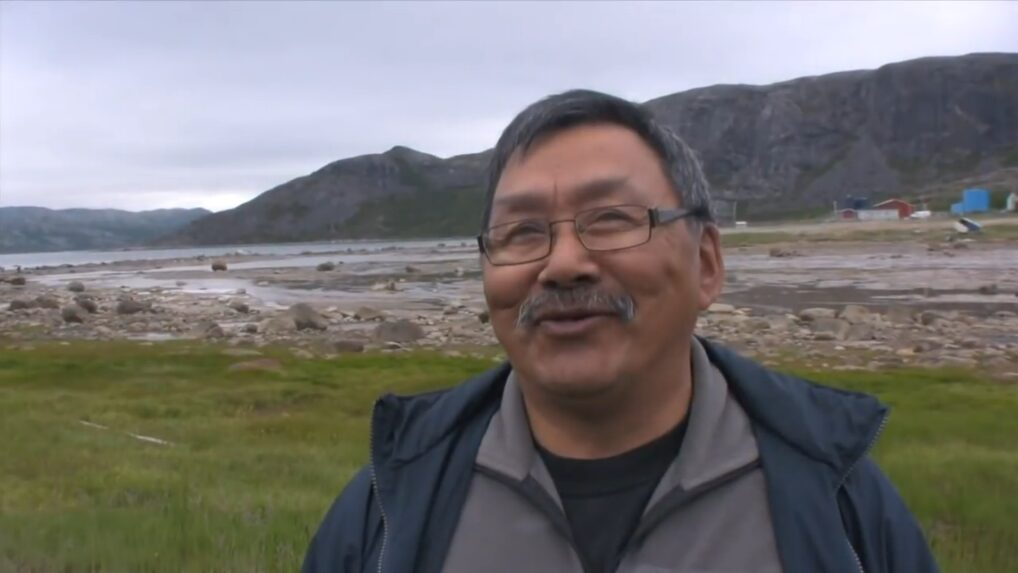
The George River
When Prichard and his team reached the George River, they hoped to meet the local Innu people. But these elusive people had already passed on to different hunting grounds. Without any canoes to handle the George River, Prichard had to turn back.
But Wolf and McGowan's portage drudgery paid off, and they still have theirs. Once they reach the George River on day 17, the kilometers begin to fly by. Speaking of flies, they remain innumerable. Soon, the canoeists reach the end of the river at Ungava Bay.
At 23, Kyle Parker paddled all 682km of the Wisconsin River in a blur of muscle fatigue and no sleep. Coming in at 5 days, 19 hours, and 22 minutes, he set the fastest known time for the route in a solo canoe.
Parker wants to take his time for his new project, which will begin in just under a month.
"Today, we travel by all sorts of modes, often opting for the easiest and fastest we can find," he writes on his blog. "I am looking forward to slowing down to just a few miles an hour and really getting under the skin of the country."

The U.S. from 'tip to tip'
Parker's big dream is to traverse the country from northwestern Washington to southeastern Florida. He expects the trip to take six to eight months.
The route encompasses the frigid, deep waters of Puget Sound, hundreds of kilometers of rivers across the continental United States, the warm waves of the Gulf of Mexico, and even a few days on the western seaboard of the Atlantic Ocean.
He will have to contend with more than just choppy water and fierce currents. Usual canoe routes feature regular portages over dams when the interruption of the river requires carrying the canoe. But Parker will have to portage hundreds of miles over highways and, on one occasion, the continental divide.
"But it’s not just about the scenery or the wildlife, or even the excitement of being absolutely miserable," Parker writes. "It’s also about the people I’ll meet and the stories I’ll uncover. I want to connect with locals...and experience the culture of each place I visit."
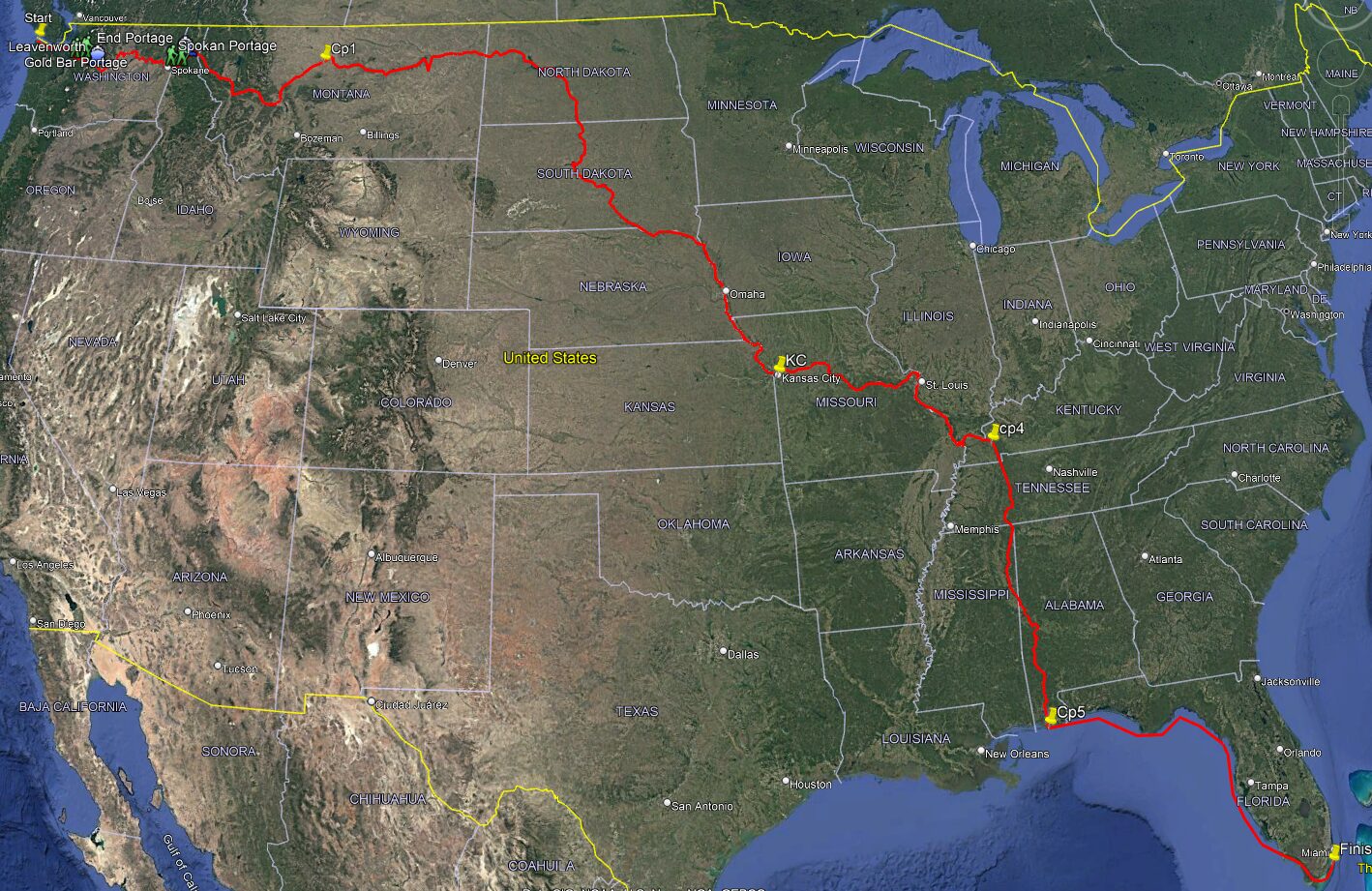
Carrying on Stachovak's legacy
This kind of expedition is unusual but not unheard of. In 2009, Parker's fellow Great Lakes native Jake Stachovak completed the 9,237km Great Loop by kayak. The Great Loop starts in Portage, Wisconsin, and ends in Portage, Wisconsin, with a brief detour to the Gulf of Mexico. In 2022, Stachovak passed away to cancer at the age of 46.
Now his widow has supplied 24-year-old Kyle Parker with a portage cart, water bag, radio, and a pink cup holder that all belonged to Stachovak.
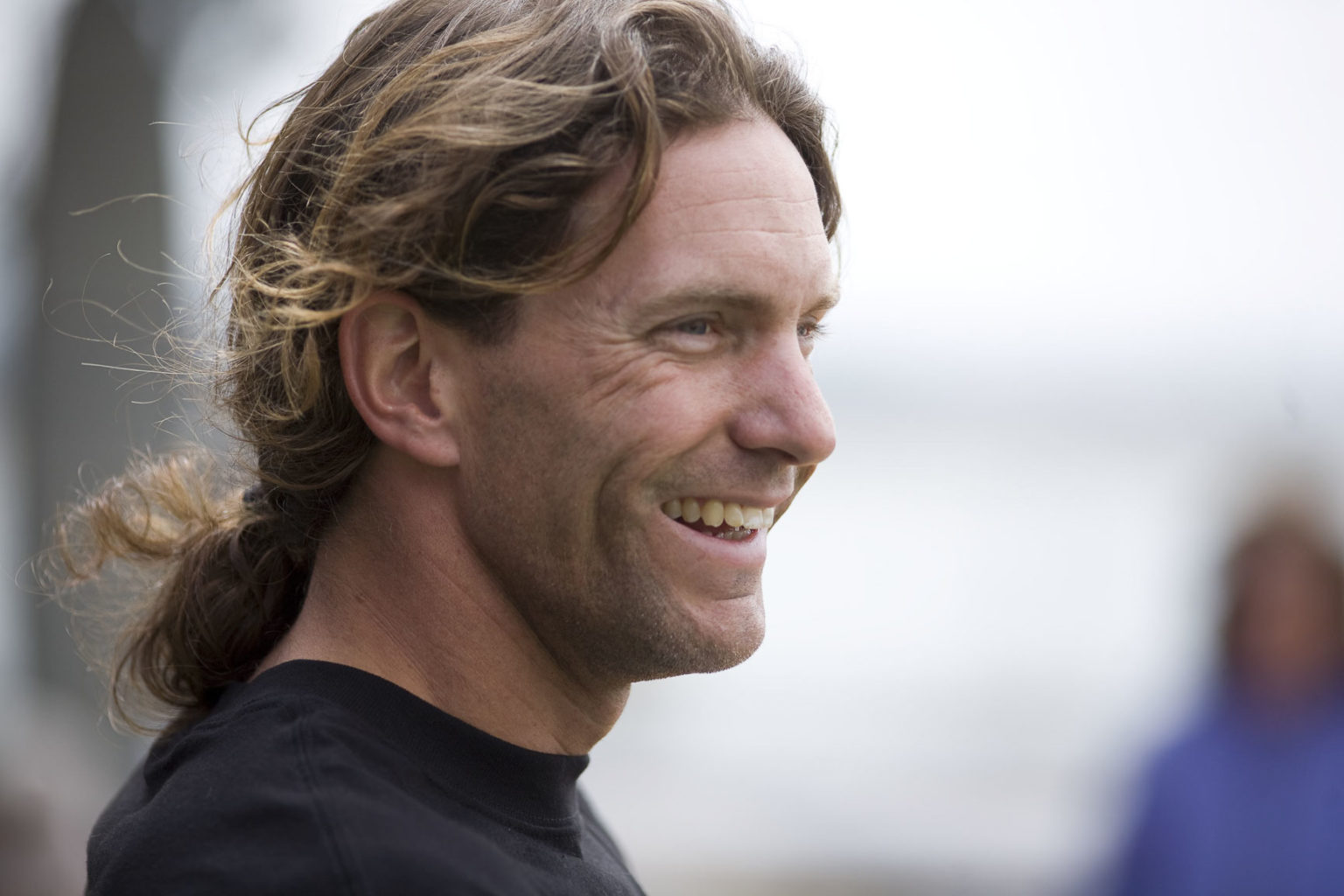
Parker has support from local paddling stores, too. Ethan Scheiwe, the manager of Madison's Rutabaga Paddlesports and one of Parker's sponsors, told the Wisconsin State Journal, "It’s a very daunting trip, but Kyle is the right person for it. If he does this, it will be the National Geographic adventure of the year. It’s that kind of trip.”
Parker sets out on May 1. You can follow the adventure on his blog.
In September 2024, Johnny Coyne and Liam Cotter of Ireland, both 24, began an ambitious 5,000km kayaking journey from Dublin to Istanbul. Their route has taken them across the Irish Sea and the English Channel without support vessels, followed by tricky navigation through European rivers and canals. With 4,000km behind them, their finish line is now almost in sight.
Among the many challenges over the past seven months, their support vessel pulled out just hours before crossing the heavily trafficked English Channel, so they had to go it alone. They tried paddling the French canals but didn't have a permit, so they were banned from the water. By the time their paperwork was in order and they could restart, the waterways were frozen.
Undeterred, they put their kayaks on wheels and dragged them for 350km cross-country. Then, more bureaucratic issues on Germany's canals forced them to trek, kayaks and all, through the Black Forest to the source of the Danube.
Throughout it all, the Irish duo has shown relentless optimism, dismissing the many obstacles as just part of the experience. Coyne said the hardest parts have been the long sea crossings, particularly the 12-hour crossing of the Channel.
“We always say the hardest part is over, and then it just gets harder,” he told one interviewer.
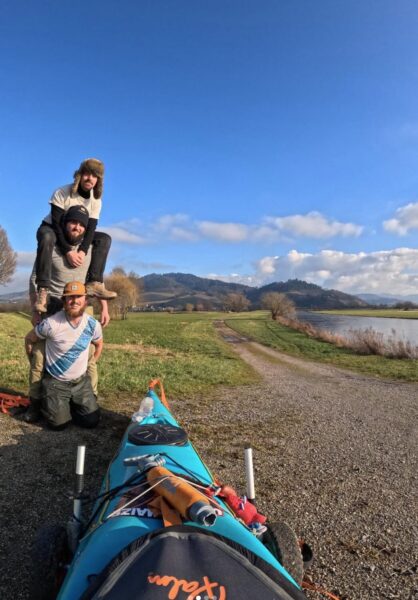
Two become three, briefly
In Germany, the duo morphed into a trio. Fellow Irishman Ryan Fallow, 24, has joined the ranks and is sticking with them all the way to Istanbul.
By February, they had covered over 1,900km, reached the Danube River, and followed it into Austria. The first few days on the Danube were great fun, and with the current and occasional rapids, they covered around 50km a day. Then in some whitewater, a rock hit Cotter’s boat and put a hole in it.
Improbably, they found someone nearby who could fix it for them. When another man arrived to help with the repair, he offered Fallow another kayak to replace his old one with little storage. They took to the Danube again. Days later, during a long portage, Cotter fell and hurt his shoulder. He tried kayaking with his arm in a sling but it didn't work so well and he had to drop out. Three were two again.
More bureaucratic mishaps
They followed the Danube through Austria, then kayaked through Slovakia and Hungary. Six months after setting off, they entered Croatia. More drama ensued almost as soon as they arrived in their ninth country.
During their first night in Croatia, they woke up to police around their kayaks. They had to convince them that they were not illegal immigrants. The boys were allowed to continue, but they were told that they had to get a Serbian passport stamp. This is because they were paddling past Liberland, a patch of disputed land between the two countries.
A police boat followed them the entire way. After coming back into Croatia, they went into town for lunch but were arrested. They had not stamped back into Croatia. After a few hours and a 130 euro fine each, they were released.
They kayak every day but also explore the towns and villages they pass. Often, local people offer them a place to stay. Sometimes, they crash in fire stations. Most of the time, they simply camp on the riverbank. With the coming of spring, this has become far more enjoyable, although the winds on the water have picked up.
Continuing down the Danube through Serbia, they woke up one morning to find the water level had risen far more than they expected, washing their kayaks away overnight. Luckily, they found them slightly further downriver. Someone had spotted the boats on the water and pulled them ashore.
Arrested again
Strong winds then forced them to pull up on the Romanian side of the river. Once again, they had not had their passports stamped and were arrested. After a night in jail, they were released.
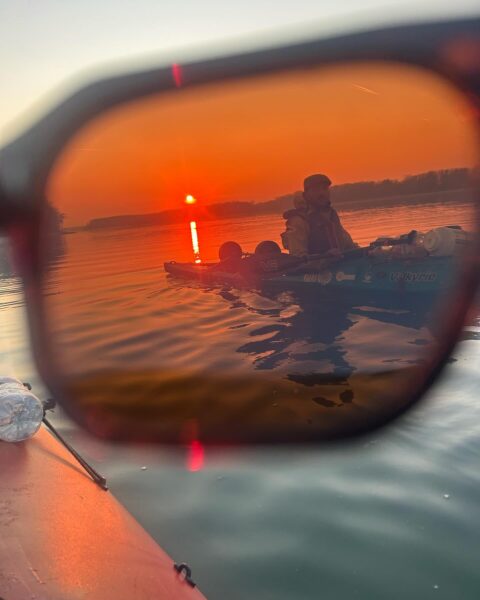
They will now paddle down the remainder of the river and then to the Black Sea, where they will follow the coast to Istanbul.
It doesn't affect the magnitude of kayaking alone across the Atlantic but it does put an asterisk on the achievement.
Two weeks ago, when Cyril Derreumaux approached the harbor of Le Marin in Martinique after kayaking 4,630km alone from the Canary Islands over the past two and a half months, he encountered strong winds and an unexpected northward current of almost two knots that he couldn't fight against. At the time, he was 45km from finishing.
He had two options. Either continue drifting and attempt to land days later in Guadeloupe, near the Dominican Republic, or accept assistance. Since his entire support crew was already in Le Marin, and even his Airbnb accommodations were set up, he decided to accept a tow from a support vessel.
There's no question that he had just kayaked alone across the Atlantic, but the short bit of assistance means that the journey no longer qualifies as unsupported. It also disqualified him from some of the Guinness records he might have wanted to claim.
"It doesn't negate the scale of what was achieved," he told ExplorersWeb after explaining what had happened.
First to kayak Atlantic and Pacific
Indeed, Derreumaux completed a human-powered east-to-west crossing of the Atlantic Ocean and was the first person to kayak alone across both the Pacific and Atlantic Oceans. The Atlantic crossing took him 71 days, 14 hours, and 57 minutes.
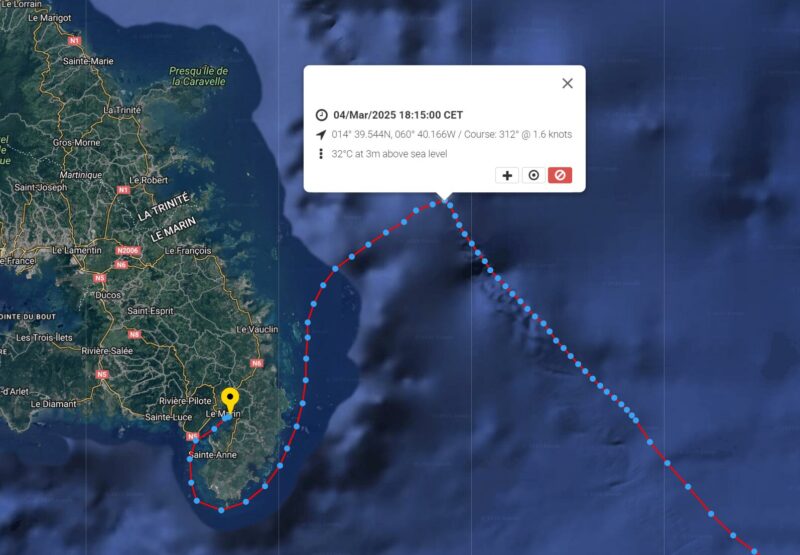
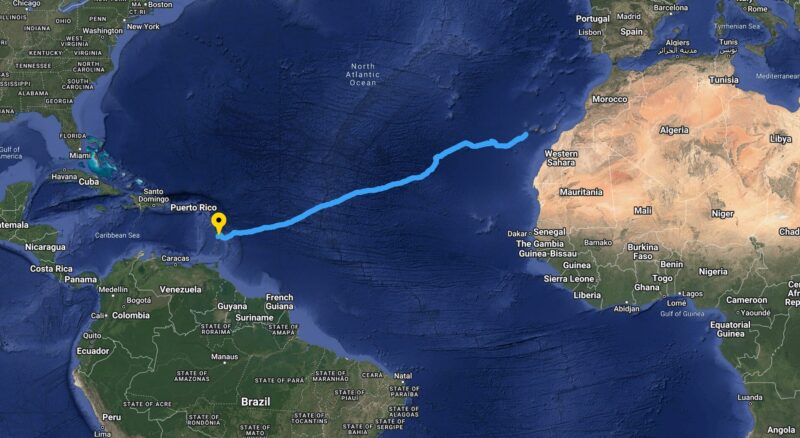
The crossing tested Derreumaux’s resilience to the extreme. In the first few days, he faced seasickness and sleep deprivation. Then there was the relentless toll of paddling for more than 10 hours a day.
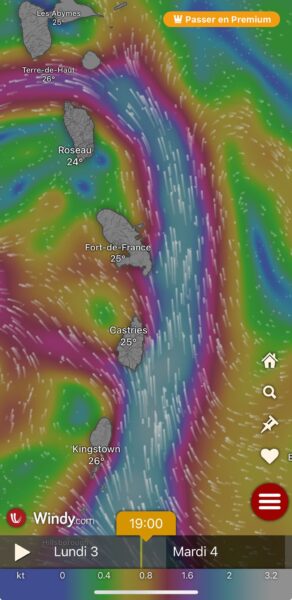
Strong winds and huge waves buffeted his small craft, and he spent several days on his para-anchor. Vast patches of seaweed also slowed him down. His water maker failed on day 55, and he had to desalinate his water manually, a slow process. The lack of abundant fresh water meant he couldn't wash away the sea water, which left him with sores all over his body.
French alpinist Mathieu Maynadier and former Croatian alpine ski racer Ivica Kostelic did not expect to end their multi-sport adventure in a hospital bed. The pair had to be rescued after a storm swept their kayaks offshore in the Adriatic Sea.
The two athletes and filmmaker Bertrand Delapierre were attempting the first recorded ski traverse of the Albanian Alps, also known as the Accursed Mountains. The range lies in coastal southeastern Europe and spans the borders of Albania, Montenegro, and Kosovo.
The trio combined ski mountaineering, paragliding, cycling, and a final kayaking segment down the Bojana River to the Adriatic. The traverse was to showcase the region’s potential for extreme sports.
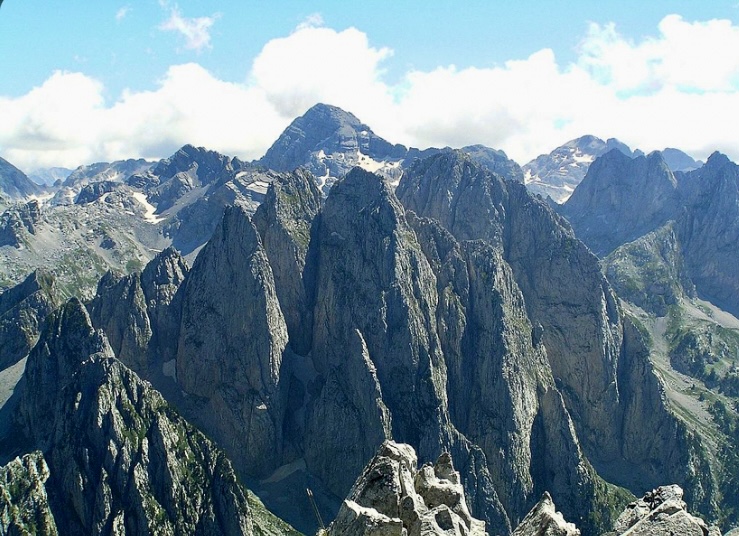
Swept out to sea
On March 10, after four days, they reached Lake Skadar. From there, they kayaked about 30km down the Bojana River to its outlet.
But as the river opened into the Adriatic, strong winds and waves of three to four meters swept Kostelic and Maynadier out to sea. Delapierre managed to reach the Albanian shore and alerted rescue services.
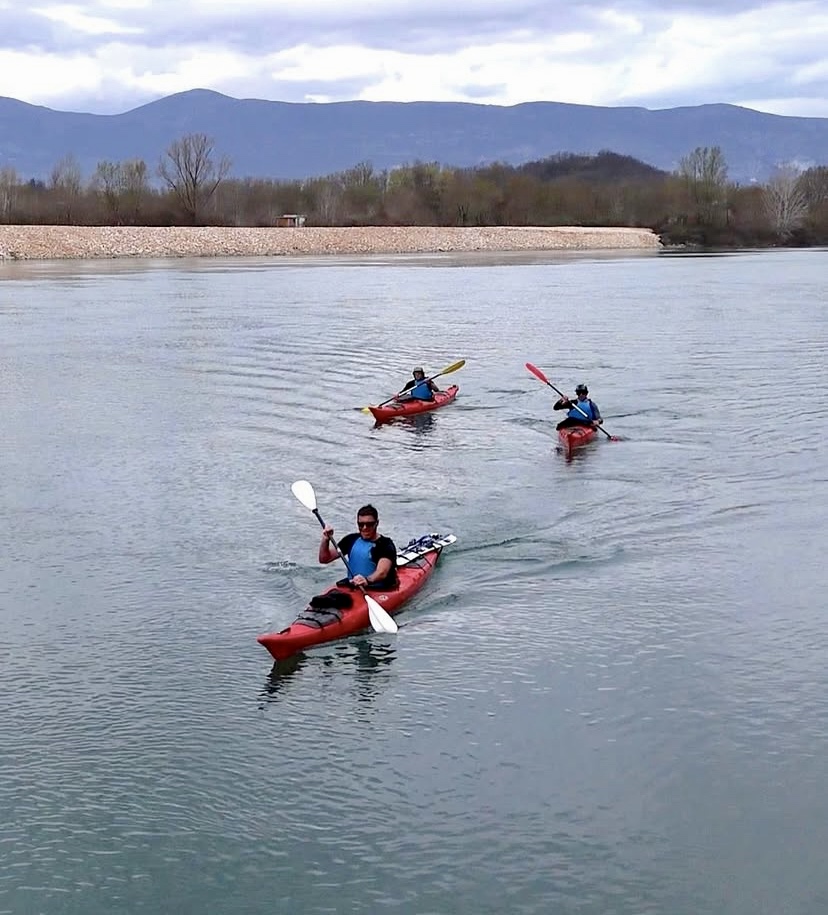
The Montenegro military responded. Five hours after the distress call, at around 10 pm, a naval vessel rescued Maynadier and Kostelic. A helicopter provided thermal imagery to locate the pair.
The extreme weather complicated the rescue, but finally, Kostelic and Maynadier were recovered and taken to a hospital in Montenegro. They were released the following day.
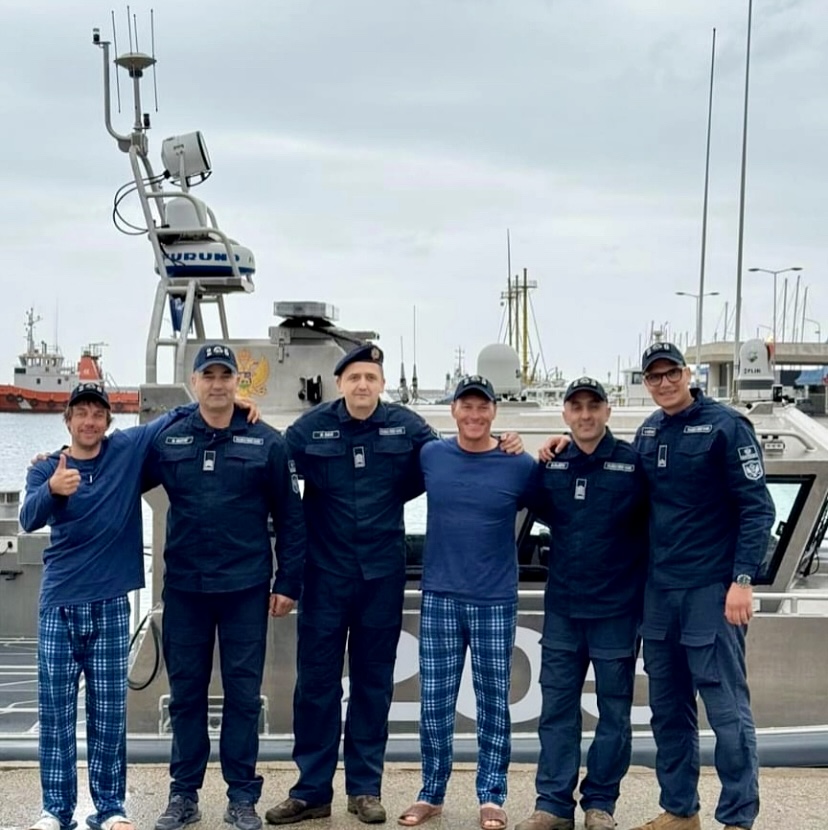
”We were tired and cold after four hours of fighting the waves, but...everything is now fine,” wrote Maynadier on social media.
He admits they made a mistake by entering the ocean in those conditions.
Yesterday, Cyril Derreumaux completed his solo kayak journey across the Atlantic Ocean in 71 days, 14 hours, and 57 minutes. He has thus become the first person to kayak alone across both the Pacific and Atlantic Oceans.
Derreumaux left from La Restinga in the Canary Islands on Dec. 23, 2024 and began paddling 4,630km to Martinique.
The early weeks were a struggle. The first few days featured seasickness, lack of sleep, and the aches of getting used to paddling at least 10 hours a day. Then he had to contend with constantly changing winds. Often, he made progress during the day only to drift back significantly at night. Several times, he had to take refuge in his cabin, put the kayak on its para-anchor, and wait out the strong winds and waves.
Valentine is no off-the-shelf kayak. It was custom-built for ocean crossings. Most significantly, it has an enclosed cabin for sleeping. It also has solar panels, an external antenna for making phone calls to his land team, and a pedal system. This means that besides paddling, Derreumaux was able to pedal to propel himself forward.
After the first few weeks, the weather became slightly more favorable. Once in a while, it even helped him go in the right direction
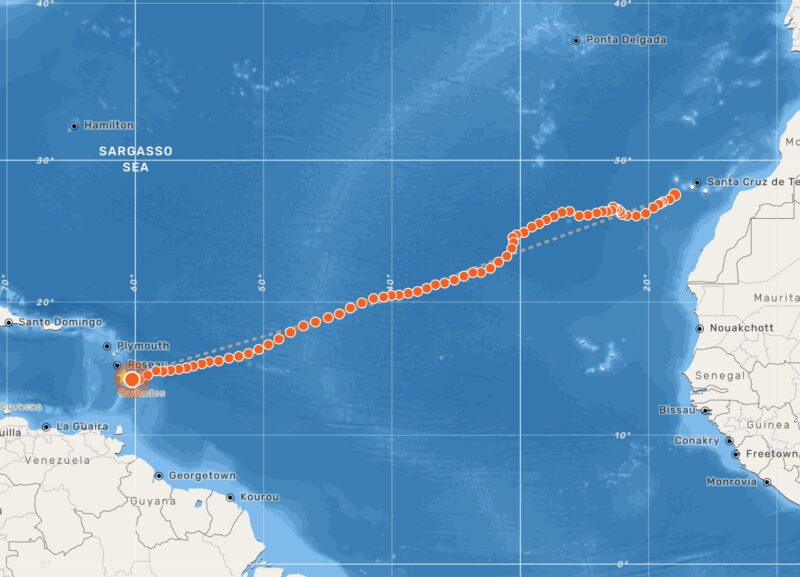
Blisters and sores
Nevertheless, the constant exposure to saltwater took a toll on his body. His hands, feet, and back have suffered the most. Blisters and sores couldn't heal due to the constant dampness. This situation worsened on day 55 when his electric water maker broke. Since then, washing properly was difficult, and he relied mainly on baby wipes. In his near-daily updates, he noted that mushrooms seemed to be growing under his fingernails, as they did on his Pacific crossing.
The failure of his water maker also meant that desalinating seawater into drinking water was slow and difficult. He had to filter manually, a time-consuming and physically demanding process that gave him two bottles of water at lunchtime and another at the end of the day.
Seaweed obstacle
As he neared the Caribbean islands, another unexpected challenge slowed him down — Sargassum seaweed. Vast patches of the floating algae forced him to alter his course to keep it from tangling in his rudder. At one point, he found himself trapped in a dense patch the size of two football fields, struggling to navigate through the thick mass.
Despite everything, Derreumaux has stayed remarkably upbeat. Listening to music every day and getting short updates from his brother about life at home have kept him feeling positive through the months of isolation.
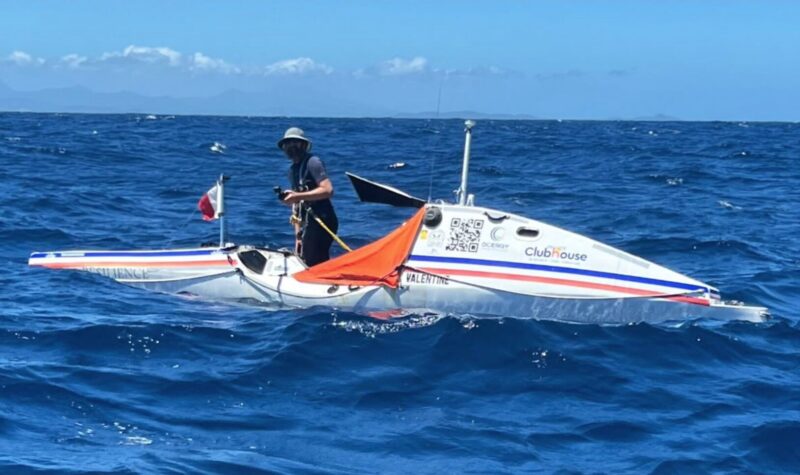
During the final two days of his paddle, the current pushed him northwest.
"I had to paddle at 240 degrees (which is southwest) to be able to keep going west," he wrote.
Last night, his family boated out to accompany him for the last few kilometers of his journey.
The canoe has always been part of Canada’s national mythology — but it’s a complicated history. For thousands of years, these watercraft provided essential transportation through the vast wilds of North America for the continent’s Indigenous peoples.
Then those same vessels became tools of colonial expansion during the Voyageurs’ fur trade era, displacing native communities and fueling the extraction of natural resources. Finally, it arrives in the modern era, where it’s mostly known for recreational activities “dominated by middle-class white people,” as sports and leisure historian Jessica Dunkin wrote in the 2019 book Symbols of Canada.
That’s quite the circuitous journey — even for a vessel designed specifically for navigating them.
But there’s likely no place on Earth better equipped to tell the canoe’s story than the upgraded Canadian Canoe Museum. Though the museum’s been around for 27 years, it finally raised enough money for a massive expansion last year. It now offers a generous space for paddle lovers, who can explore its collection of 600+ watercraft on a beautiful lakefront property in Ontario.
A uniquely Canadian museum
From the enormous exhibit hall to the hands-on workshops to paddle tours on the water, the museum aims to bring together the canoe’s rich and varied history.
“You can go in one door and paddle out the back. It’s like a family reunion for your boat to be able to go there and see what its parents and grandparents look like,” said James Raffan, a Canadian educator, author, and adventurer. “But it’s not just about celebrating canoes. It’s also about figuring out how to relate better to each other.”
While the U.S. has the soon-to-expand Minnesota Canoe Museum, and the Canoe Heritage Museum in Spooner, Wisc., both are relatively small operations. So the Canadian Canoe Museum provides a represents a unique draw for American tourists with its depth of history and canoe variety.
It also took years to raise $45 million for the museum’s new 65,000-square-foot building, said Megan McShane, communications coordinator for the museum. Donations came in from around the country, with about half the money coming from private foundations and individuals and the other half from various government funding.
Tears of happiness
A long lineage
Not merely a tradition
Paddle tours & workshops
Upcoming events
This article first appeared on GearJunkie.
A young Venezuelan packrafter briefly became a modern-day Jonah and Pinocchio when he found himself inside the mouth of a humpback whale. The whale released Adrian Simancas unharmed, and his father, Dall Simancas, caught the entire bizarre incident on video.
Adrian Simancas, 23, and his father Dall, 49, were packrafting through the Strait of Magellan between Tierra del Fuego and mainland South America. Dall, who’d been filming the waves, had his camera trained on his son when two massive jaws emerged from the water and closed around the little yellow inflatable and its lone passenger.
For a moment, the choppy waters are empty, with man, beast, and boat submerged beneath the waves. Then, Adrian reemerges, followed by the packraft, which he quickly swims for. A massive grey, finned back crests briefly beside him and then is gone.
Amazed at his lucky escape, Adrian later described his experience. The inside of the whale’s mouth, he said, was slimy against his face, and all he saw was dark blue and white. He thought he was going to die -- and then he was on the surface again, pulled up by his life vest.
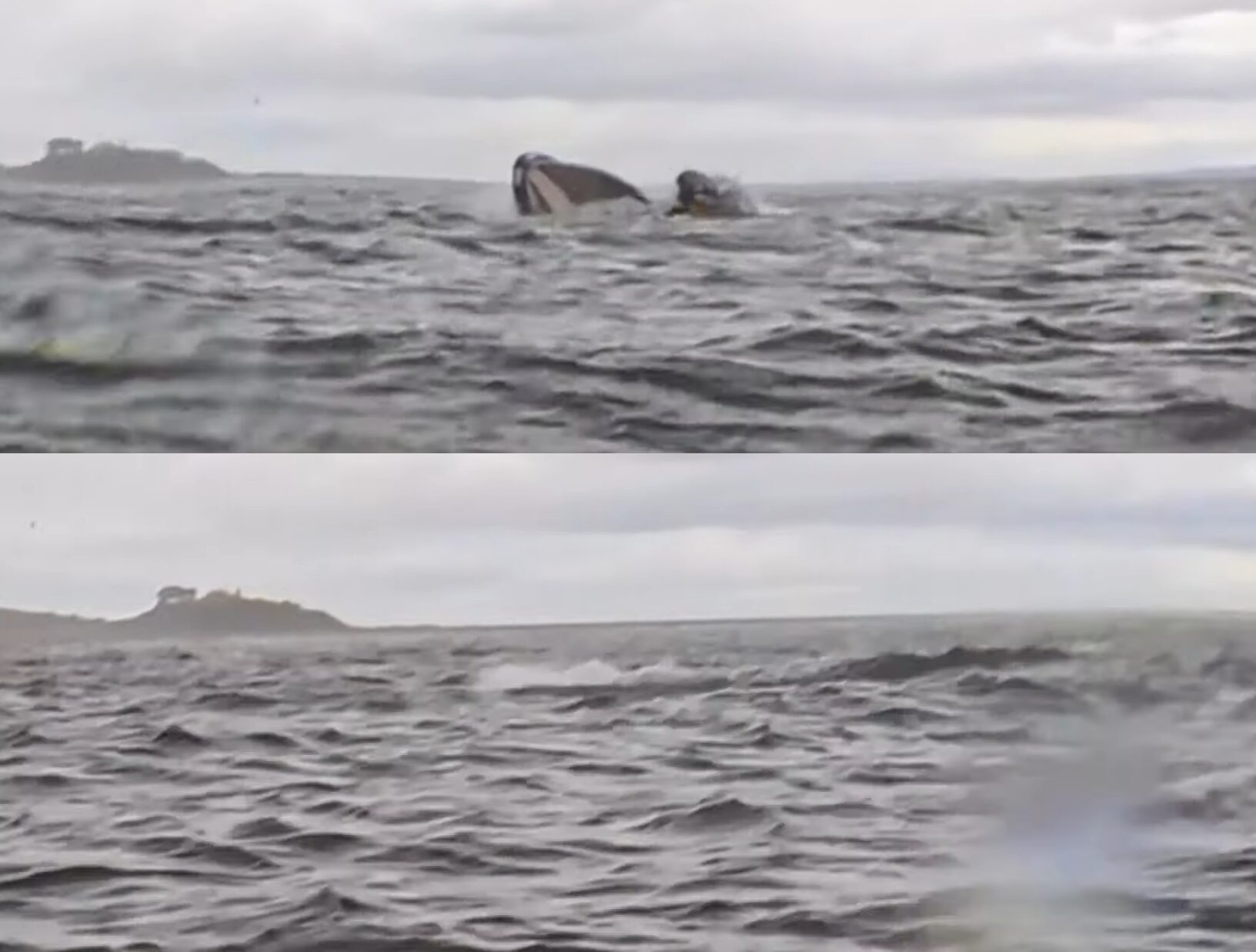
Not technically swallowed
Despite thousands of years of mythology, it is not actually possible for a person to find themselves in the stomach of a whale.
"Ultimately, the whale spit out the kayak because it was physically impossible to swallow," said Brazilian conservationist Roched Jacobson Seba.
Despite their massive size, whales have very narrow throats, about the width of a human fist. They can stretch to be a bit larger, up to about 38cm, but a boat and its passenger are quite beyond their capabilities.
Only one whale can theoretically swallow a human. The sperm whale has sharp teeth and feeds on large squids and fish. This means it has a large enough esophagus to gulp down a human. Encounters with them are much rarer, though, and sperm whales have not swallowed any humans except in fiction. The leviathan in Moby Dick that nipped off Captain Ahab's leg was a sperm whale.
Being engulfed in the massive mouth of a humpback, however, is not off the table, as Simancas learned. He isn’t the first person to spend time in the slimy maw of a whale. In 2021, a humpback 'swallowed' lobster diver Michael Packard off Cape Cod. Like Simancas, he was soon spat back out. Californian kayakers in 2020 and a tour operator off South Africa’s Port Elizabeth in 2019 reported similar incidents. This even once happened to a confused harbor seal.
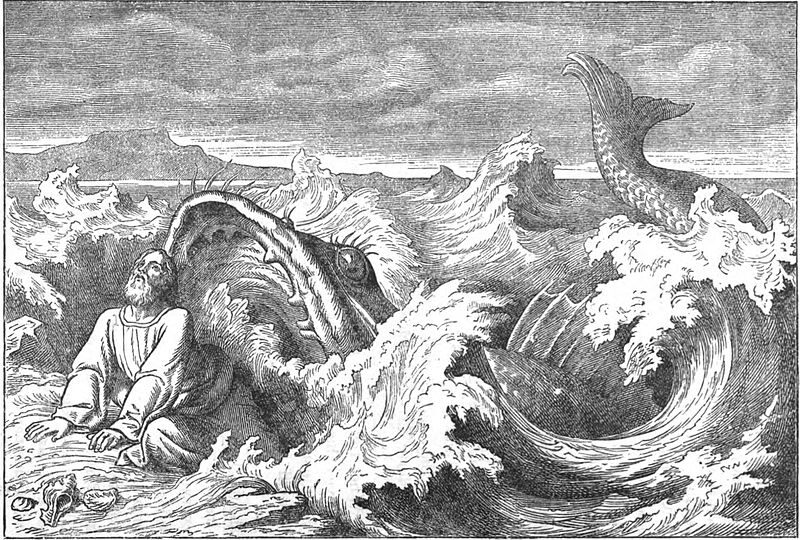
Probably unintentional
Researchers have weighed in on these engulfing incidents. They insist that the whales did not intend to have people in their mouths any more than the people intended to be there.
As baleen whales, humpbacks take in huge gulps of seawater. Then they use the bristles in their mouths to filter for plankton, shrimp, and small fish. This is what they are after, and the rest, like paddlers, they soundly reject. When you are as big as a whale and maybe not paying attention, you can accidentally gulp down Adrian Simancas and his packraft along with your seawater and shrimps.
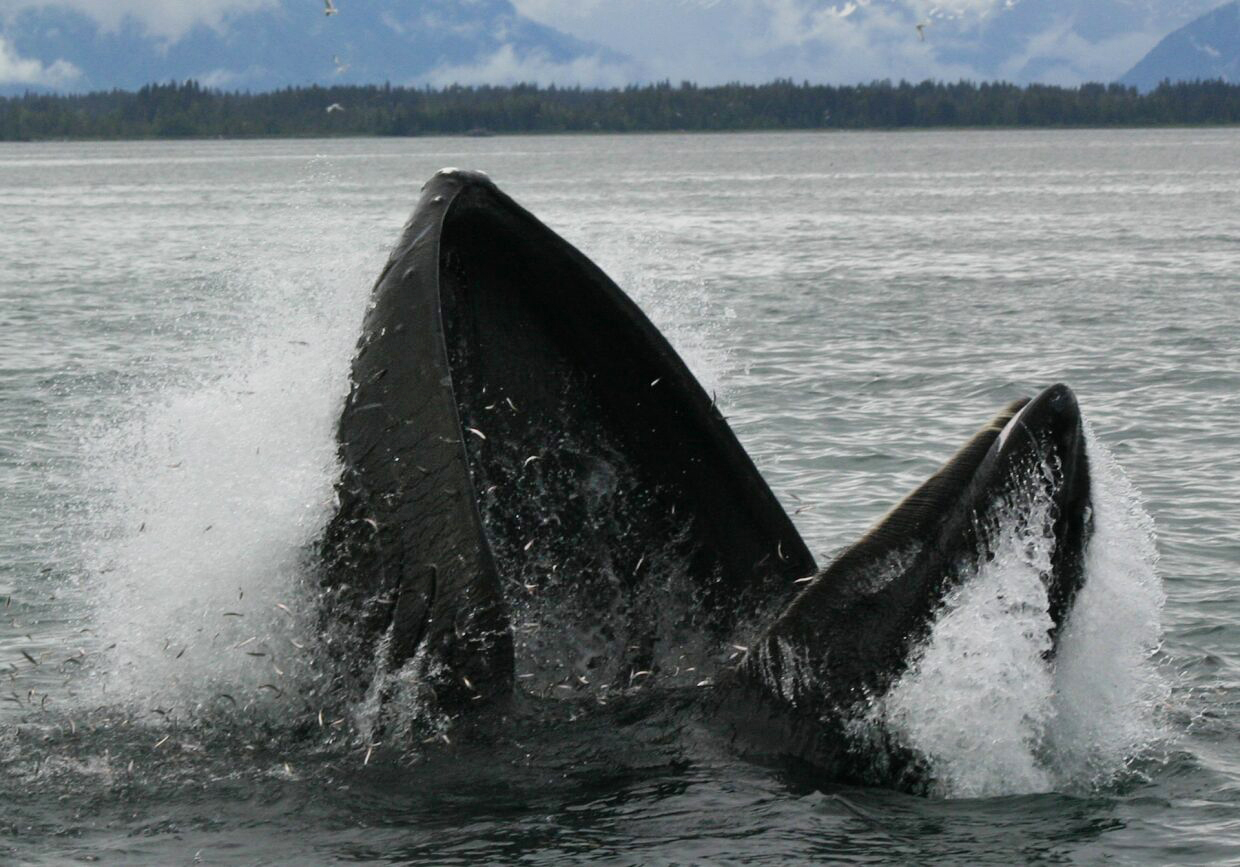
Accidents like these are why whale researchers warn people not to use silent craft, like kayaks and paddleboards, in waters where whales are active. Whale-watching boats keep their engines on at all times to alert the whales to their presence.
Adrian Simancas and his father don’t hold a grudge against the whale. At first, terrified, Adrian thought an orca was eating him. However, after he got free, he realized that the whale was probably “just curious.” Father and son said they plan to get back in the water soon, despite the engulfing.
If there’s one attitude that’s nearly universal among adventure athletes, it’s a pathological commitment to optimism. Johnny Coyne and Liam Cotter of Ireland possess this quality in spades. In the last five months, they’ve camped in freezing cold temperatures beneath the cliffs of Dover, hauled loaded kayaks uphill for 160km through Germany’s Black Forest, and when they knocked a hole through one of their boats in a French canal, they went door to door asking for help to repair it.
To these many obstacles, Coyne merely says, “It’s all part of the experience.”
The two 24-year-olds set out from Ireland in early September 2024 to pull off an improbable quest: kayaking across Europe from Dublin to Istanbul. That could make them the first people in the world to travel the continent by kayak. It hasn’t been easy, and several setbacks have added months to the planned itinerary.
Recently, Coyne and Cotter were happily setting up camp along the Danube River, near Germany’s border with Austria. Of the 5,000 total kilometers likely required to reach Istanbul, the pair have traveled more than 1,900. They’ll now follow the Danube through Eastern Europe until it empties into the Black Sea, where they’ll follow the coastline all the way to Istanbul.
“I know this is going to be one of the longest and most unique journeys I’ll ever do,” Coyne said. “Trying to stay in the present moment is key.”

Channels and canals
While Coyne’s kayaking quest has been more difficult than he expected, it’s far from his first grand adventure. The young Irishman has committed himself to daring outdoor journeys in the last few years, from cycling to Portugal and trekking across Nepal to a bike trip from Canada to Costa Rica.
Though neither consider themselves serious kayakers, Coyne and Cotter compensate for the lack of experience with an indefatigable attitude.
“I didn’t have too many expectations of the journey. I just knew it was gonna be hard,” Coyne said.
It’s possible that the most difficult parts of the trip are already behind them. For starters, it took them nine long hours of paddling to make an unsupported crossing of the Irish Sea to England. They arrived at 10 pm, slept for a few hours beneath the famous White Cliffs of Dover, and then woke up at 4 am to start their crossing of the English Channel.
Though they’d planned on having a support boat for some extra protection while crossing one of the business shipping lanes in the world, the operator canceled at the last minute. So Coyne and Cotter once again paddled unsupported, pulling off a 12-hour crossing while fighting the channel’s fierce winds and waves.
Riverbank serendipity
Portaging through Europe

The kindness of strangers
Halfway there
This article first appeared on GearJunkie.
Sea kayaker Cyril Derreumaux has started paddling across the Atlantic Ocean. He pushed off from La Restinga in the Canary Islands this morning and will travel 4,800km alone to Martinique.
Derreumaux, 46, had planned to leave on December 17, but a gale pushed that back twice. He finally left today.
While rowing the oceans has become popular, thanks to annual races across the Atlantic and Pacific, only a handful of people have successfully kayaked the Atlantic. Derreumaux wants to add his name to that very short list.
He hopes to finish in 75 days but estimates that the crossing will take between 70 and 90 days, depending on what the ocean throws at him.
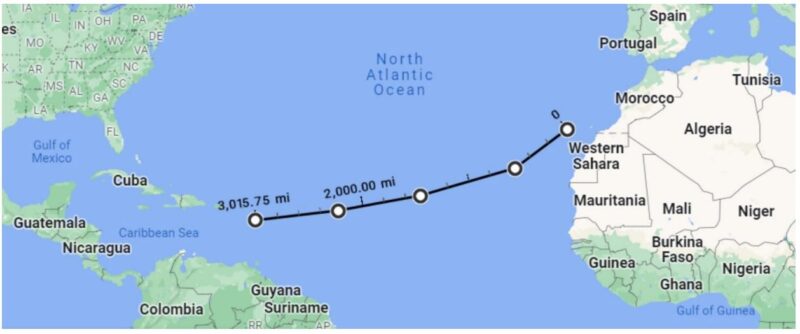
Pacific prelude
Two years ago, he kayaked across the Pacific from California to Hawaii. What he thought would be a 70-day journey took 91 days. This 2022 Pacific paddle, Derreumaux's first big journey, was inspired by Ed Gillet’s legendary 1987 crossing. The route Derreumaux took was identical, but the experience was quite different. Gillet used an off-the-shelf Tofino double kayak, an SOS transmitter, and a radio, while Derreumaux had a self-righting, state-of-the-art vessel that was built with an ocean crossing in mind.
Derreumaux doesn’t think anyone will ever recreate Gillet’s journey. He describes Gillet as a trailblazer and a maverick. Speaking to ExplorersWeb after his first ocean crossing, he said, “He inspired me, and I’ve been in touch with him many times. The way he did it, sleeping in the cockpit with a tarp over himself, navigating with a sextant and no communication whatsoever, he was truly solo. I was solo because I was alone in the boat, but I had land support. I could text back and forth and even make a phone call when I had issues. He’ll never be reproduced.”

Custom-built kayak
The French-born explorer will once again complete his journey in Valentine, the seven-meter vessel that carried him across the Pacific. Fully loaded, it weighs 370 kilograms. It does not resemble a traditional kayak. It has an enclosed cabin for sleeping, solar panels, an external antenna for making phone calls to his land team, and a pedal system. This means that besides paddling, Derreumaux can pedal to propel himself forward. This will allow him to use different muscle groups on the lengthy crossing.
He expects the first two weeks to be the most challenging. He will have to contend with seasickness, sleep deprivation, and adjusting to paddling for such extended periods.
Derreumaux plans to follow the routine that worked for him on the Pacific. Starting at sunrise, he will paddle for five hours, then stop to eat, and do another five-hour stint. He will try to get a few more hours in if conditions are good. Throughout the night, he will wake up every two hours to check on the boat and its position.
You can follow his progress here.
The missing kayaker who faked his own death and fled to Eastern Europe has returned to his home state and turned himself in.
On Tuesday, December 10, 45-year-old father Ryan Borgwardt returned to Wisconsin from the Eastern European nation of Georgia. There, he surrendered himself to the Green County Sheriff's Office. The next day in court, he was charged with obstructing an officer. He was then released on a $500 bond after entering a not guilty plea.
Now, with Ryan Borgwardt back in the States and in open communication with authorities, his strange journey can begin to be untangled.
The 'drowning'
Borgwardt had allegedly planned his "accident" for some time. On August 11, he went up to Green Lake, which he chose, he told authorities, because it was the deepest lake in the state.
Once there, he packed his vehicle, carefully pulling it all the way up to the doors of his shop to avoid security cameras. He loaded it with an e-bike and inflatable raft he had bought secretly, as well as his kayak. On the way up, he stopped and bought a hat and backpack from Walmart.
The complaint alleges that he stashed the bike and new backpack in a patch of trees and set out onto the lake in his kayak, making his way toward what he believed to be the deepest section. Borgwardt transferred to the inflatable raft and began throwing things into the lake: first his phone, then his wallet, keys, life jacket, fishing pole and tackle box. Finally he flipped the kayak so it would appear to have capsized and returned to shore in the inflatable.
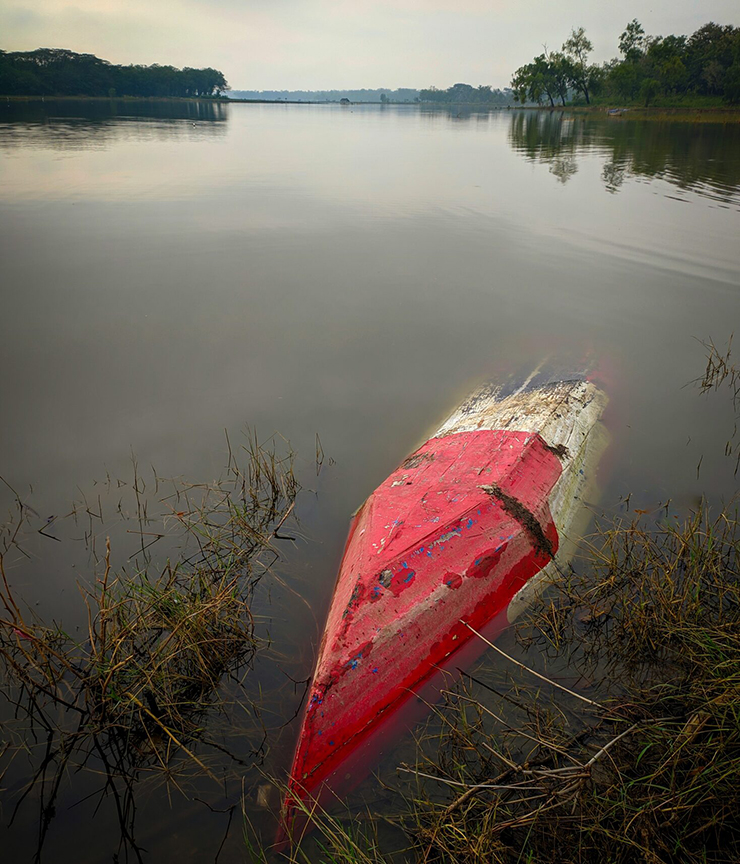
The escape
Having faked his death, he now had to flee the country. For this, Borgwardt retrieved the e-bike and rode through the night, covering the 110km of backroads to Madison, Wisconsin. Having packed a spare charged battery, he was able to go all night without stopping. In Madison, he hid the bike, raft, and some personal belongings in a local park and boarded a Greyhound bus to Chicago, Detroit, and finally the Canadian border.
Borgwardt had his passport, but all other identification sat at the bottom of Green Lake. After some back and forth, Canadian officials let him through.
Once in Canada, he made his way to the Toronto airport and used a Western Union card to get a ticket to Paris.
The long international flight gave him a chance to check for news of his own disappearance. He saw that there was, indeed, news of a missing kayaker. Feeling that his plan had worked, he got off that flight and hopped onto another bound for Georgia.
A former Soviet state, Georgia straddles Eastern Europe and Western Asia. There, Borgwardt met with a woman he’d been in communication with for months. The pair stayed together for several days in a hotel, though he eventually ended up in an apartment.

Putting the pieces together
Weeks passed, and Borgwardt kept checking the news, waiting for the local officials to give him up for dead and call off the search.
But officials were instead growing more suspicious. Everything pointed to drowning -- but why had sonar, drones, and cadaver dogs all failed to find any hint of a body? Their suspicions were further roused when, in early October, they found out that Canadian officials had searched the missing man's name only days after his apparent drowning. This led local police to reach out to Federal authorities.
The story started to come together when officials stopped searching the lake and started searching his laptop. They discovered that he’d been talking to a woman from Uzbekistan and had been researching how to move money into foreign bank accounts. He had even taken out a $375,000 life insurance policy less than a year before.
On November 8, the sheriff, Mark Podoll, announced that Borgwardt had likely faked his death and fled to somewhere in Eastern Europe. He personally urged the missing man to come home and return to his family.
Borgwardt, shocked, decided to provide authorities with evidence that he was, in fact, alive and well, likely hoping to reassure them and his family without revealing his location. He sent a 25-second video of himself in an apartment.
But authorities did not stop urging him to return, holding another press conference and personal address on November 21 and remaining in contact with the increasingly troubled Borgwardt.
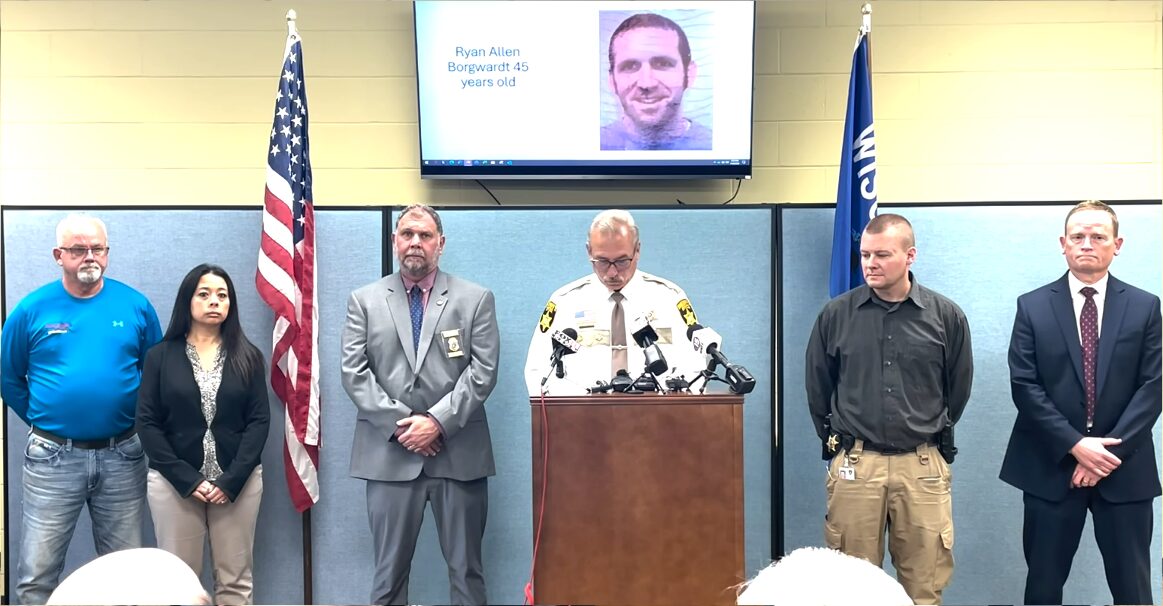
Return to Wisconsin
Finally, Borgwardt folded under the pressure and guilt being applied by authorities. He returned on his own accord, without extradition. Now that he has done so, however, the authorities who begged him to return are seeking restitution.
The Green Lake sheriff's office alone spent at least $35,000 on the search. Borgwardt, who could not afford a lawyer, may be compelled to repay part of this cost. The misdemeanor crime he was charged with carries a maximum penalty of nine months in jail and a $10,000 fine.
It remains to be seen how this bizarre case, which began as a wilderness search-and-rescue and is now a court drama, will ultimately end. Sheriff Podoll, however, is happy with what they’ve done.
“What better gift could he give his kids than to be there for Christmas?" Podoll said. “We brought a dad back.”
Erik Boomer and Ben Stooksberry are two of the best expedition kayakers in the world. But even they may have met their match when they travel to Chihuahua, in northern Mexico. The plan? First descents on the rivers that rampage through the region's famously beautiful (and dangerous) canyons.

¡Ay Chihuahua! is the 17-minute film the pair created about the expedition. The story unwinds as a good old-fashioned travel tale. After laying out the broad strokes of the expedition, we meet members of the Group of Speleology and Exploration Cuauhtémoc, a collective of Mexican canyon explorers. They chuckle ruefully when the kayakers ask them if the rivers they've targeted are runnable.

Dangerous and hard
"I think it's dangerous and hard," Ricardo Rios, one of the group's members, says.
But before the duo can get on the water, they have to wait out agonizing days of nonstop rain, which swells their initial objective — Rio Candameña — well past runnable levels. You can see Boomer and Stooksberry's frustration as they huddle under eaves and watch the water pour. Doubt starts to creep in.
"We are teeter-tottering between total stoke to drop into these rivers, and then when the rivers flash flood, we're scared and kind of wondering what the hell we're doing here," Boomer says.

But these are seasoned expedition kayakers, and they know that waiting — and the hesitation that accompanies it — is part of the job.
"In my experience, any worthy or difficult or challenging objective is just this mind game," Stookesberry says.
The kayaking starts in earnest about six minutes into the film. The kayakers change tacks while they wait for the Candameña's waters to recede, deciding to tackle a first descent of the nearby Río Concheño.

Boxed-out canyons
Kayaking awesomeness ensues. The boys scout when they can, but it's a long trip, and they have another river on their mind. Time is of the essence.
"Gnarly, boxed out barranca canyons that were just enough to make everything scary," Boomer notes of the river. "So you think to yourself you're going to go here, and here, and then go left. And then when you get into the canyon..." he finishes before trailing off ominously.

After several exciting kayaking sequences that will appeal to experts and neophytes alike, Boomer and Stookesberry finish their run in the small town of Moris. There, they party with locals before traveling back to the Candameña, whose waters are now at perfect levels.
Well. Perfect for the Candameña. There's a reason nobody else has notched a first descent on it. The pair probably spend more time portaging than they do kayaking. But when they do get to drop into whitewater, it's all adrenaline. The drops are steep, and the moves are must-makes.

"It's a marathon of Class V, a marathon of portaging, a marathon of intensity. And there just isn't one moment that you can pick out, except maybe the moment when things go bad." Stooksberry says.
The moment he's referencing occurs when Boomer puts a sizable dent in the bow of his kayak, then pokes a hole through it while attempting to repair it over an open fire.

In the end, the pair achieve their first descent and are all the better for it. "We didn't get held hostage. The people didn't threaten us. Nobody almost died. We don't hate each other. Maybe it's kind of a boring story," Stookesberry says.

Reader, trust me on this. It's anything but.
When you combine funding from Red Bull, a legendary exploratory kayaker, a world-class photographer, a tight group of the very best whitewater paddlers on the planet, one of the top storytellers in kayaking, and a remote, little-explored river in Africa, you get one epic adventure.
This adventure is showcased in the free online film Gabon Uncharted: Sending Ivindo Falls. And, you’re going to want to watch it!
Kayaking the Ivindo River
On the equator, along the west coast of Africa, lies the country of Gabon. Cutting across the country is the Ivindo River, a remote high-volume waterway deep in the jungle.
It was first explored by whitewater kayak by Olaf Obsommer and team in 2007. Obsommer returned in 2024 to help guide the SEND collective team down this mighty river.
The four-person SEND team consisted of Adrian Mattern, Dane Jackson, Bren Orton (R.I.P.), and Kalob Grady. These are some of the very best whitewater paddlers in the world today, likely ever, and also a group of very close friends.
Much of the Ivindo’s mighty rapids were portaged around during the 2007 expedition, as little was known about the area and the dense jungle made scouting difficult. Modern technology, in the form of satellite imagery and video drones, has opened up all-new ways to scout a river safely and quickly.
Mattern has been dreaming up a trip to tackle the Ivindo’s rapids since he saw pictures of Obsommer’s group on the river. He planned the 10-12-day and 150km river expedition, and led the group.
Gabon Uncharted: Sending Ivindo Falls
This article first appeared on GearJunkie.
BY JUAN HERNANDEZ
Ryan Borgwardt was reported missing on August 12 in Green Lake, Wisconsin. His wife was the last person to hear from him. The evening before, he texted her to say he was kayaking to shore.
When the 45-year-old father of three failed to return home by morning, she let local authorities know. A week later, police reported they had found his kayak capsized in the lake and a tackle box containing his wallet, keys, and driver’s license. They spent the next 54 days searching the lake with the help of the non-profit search organization, Bruce’s Legacy, without finding Borgwardt.
“Keith Cormican, [who leads] Bruce’s Legacy, sifted through hours and hours of sonar data and images,” Green Lake County Sheriff Mark Podoll said. “Keith’s expertise and equipment led us to believe either something very odd occurred and Ryan was outside the area that had been searched, or something else had occurred.”
Nearly three months since Borgwardt’s disappearance, the Green Lake sheriff’s department still hasn’t found a body after searching every corner of the lake. Instead, they believe Borgwardt staged the entire thing and fled the country.
Shocking news
Sheriff Podoll held a press conference last week to lay out the investigation's findings, including the shocking news that Borgwardt may have faked the entire thing. A turning point in the investigation came in early October when they learned that Canadian border authorities had actually checked Borgwardt’s name the day after he’d gone missing. More evidence started to pile up after that major discovery.
For example, he erased everything on his laptop’s hard drive just after syncing all of the contents to the cloud on August 11. He’d also taken out a $375,000 life insurance policy months before the disappearance and transferred funds into a foreign bank. Authorities also say they’ve traced communication between Borgwardt and a woman in Uzbekistan.
What was a major search-and-rescue operation for a missing kayaker has turned into a criminal investigation with several departments, including the FBI. A press release from the Green Lake County Sheriff’s Department didn’t lay out specific charges that could be applied, but they are looking into any people who could have knowingly helped the father of three plan his disappearance.
“At this time, we believe that Ryan is alive and likely in Eastern Europe,” Sheriff Podell said.
This article originally appeared on The Inertia.
Peter Frank is spending the next year canoeing what's called the Great Loop around the eastern United States and part of Canada. The 9,700km circuit, normally done by motorized craft, takes in the Great Lakes, the Mississippi River, the Gulf of Mexico, and the Atlantic coast, among other water bodies.
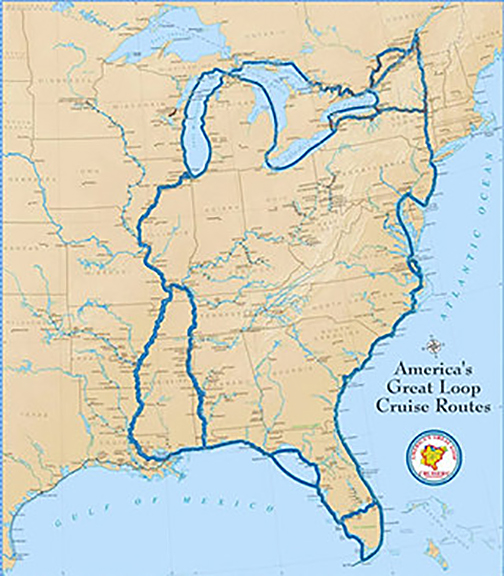
The 23-year-old began in June and is going solo and in a clockwise direction -- the opposite to almost everyone else. This forces him to paddle upstream for over a quarter of the journey.
He is following in the footsteps of the man who made his canoe in the 1970s -- Verlen Kruger. Kruger did two of the longest canoe journeys ever -- the 29,341km Two Continent Canoe Expedition from the Arctic Ocean to Cape Horn and the 45,130km Ultimate Canoe Challenge through interior and exterior North America.
Why clockwise?
Frank is attempting to replicate the Great Loop part of Kruger's route. Frank believes that Kruger and partner Steve Landick are the only canoeists to have paddled it clockwise. He wants to see if it can still be done.
Frank expects the journey to take him another six months. Starting on Lake Michigan, he paddled through the Great Lakes, the Erie Canal, and along the Hudson River. After 2,380km, he reached the Chesapeake and Delaware Canal and is now in Chesapeake Bay.
From here, he will head to the Intracoastal Waterway and along the country's East Coast to Florida, the Mississippi River, and back north.
He paddles six to 10 hours a day and carries his tent and supplies in his canoe, which looks a bit like a kayak but is propelled by a single-bladed paddle. For food, along with dehydrated meat and potatoes, he picks up fresh food whenever he can.
While he camps most of the time, occasionally someone will offer him a bed and warm shower.

Past adventures
This is not his first solo long-distance challenge. In 2021, after three years of planning, he unicycled 3,800km from Wisconsin to Arizona. In 2022, he spent five months paddling the Mississippi River. Then he biked through Louisiana, Mississippi, Alabama, and Florida, then circumnavigated Florida by canoe.
From a young age, Frank knew he did not want a traditional life. At the age of 14, he was hiding in a leaf pile, about to jump out and scare one of his friends, when a car ran over him. It shattered his spine and left him nearly paralyzed. His unicycle expedition raised funds for the organization that aided his recovery. That launched him into this world of adventure.
You can follow his journey here.
Adventurer Frank Wolf sure had an eventful year. The Canadian completed a 500km kayak expedition around the Darian Gap, notched a 325km ski trip on Baffin Island, and — most recently — traveled 1,350km by canoe from Yellowknife to Kugluktuk.
Wolf completed that last adventure earlier this year in a brisk 36 days, which is handy. With just 38 days of supplies, he and partner Arturo Simondetti had very little leeway.
The pair battled currents, winds, rapids, and long portages, especially during the first half of the expedition.
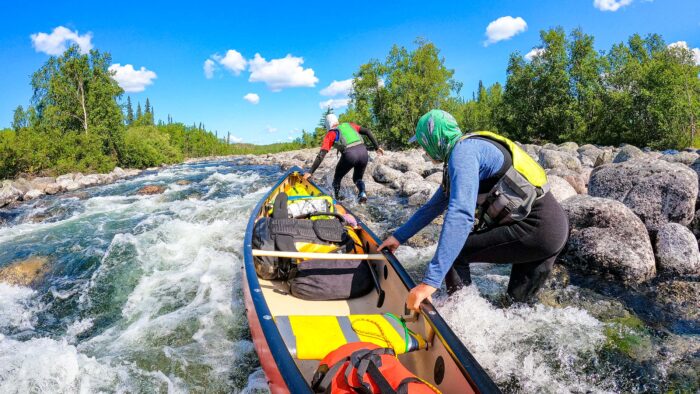
More rock than water
"A lot of places that looked like rivers on the map were just rock," Wolf told ExplorersWeb. "So we ended up doing a lot of two-kilometer portages where we thought we would be paddling."
Wolf's expedition style is to pick a destination and do his research but not get overly bogged down in minutia, like specific distance goals or pre-chosen campsites. He simply presses on, and if he gets behind schedule, as he did here, he presses harder.
Early in the trip, Wolf and Simondetti were so behind that they thought they might have to bail. But they buckled down and persevered through long days in rough conditions.
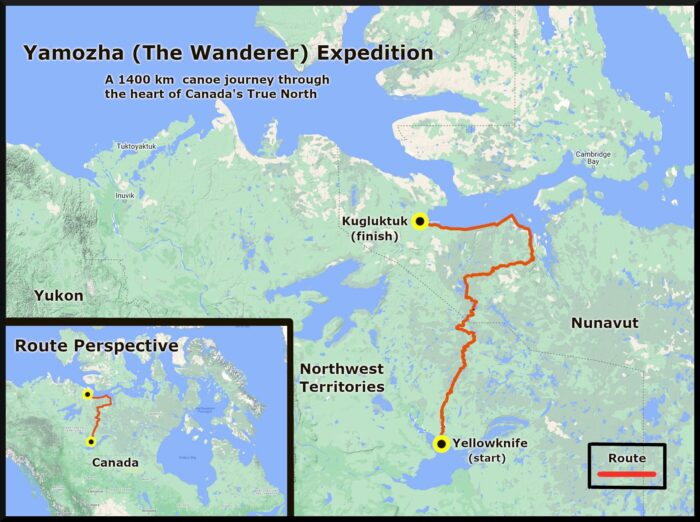
"[Once], we put in a 16-hour day, like 76km, on the ocean, in a canoe," Wolf said of the kind of effort it took to make up lost time. "So we ground and just kind of came in at the last."
As for Simondetti, he had little to no canoe experience before setting off with Wolf. When Wolf isn't adventuring, making films, or writing, he's demolishing derelict boats -- that's what he does for a living. Wolf met Simondetti during this work. Despite the differences in age and experience (Wolf is 54, Simondetti 24), Wolf recognized a fellow adventurer.
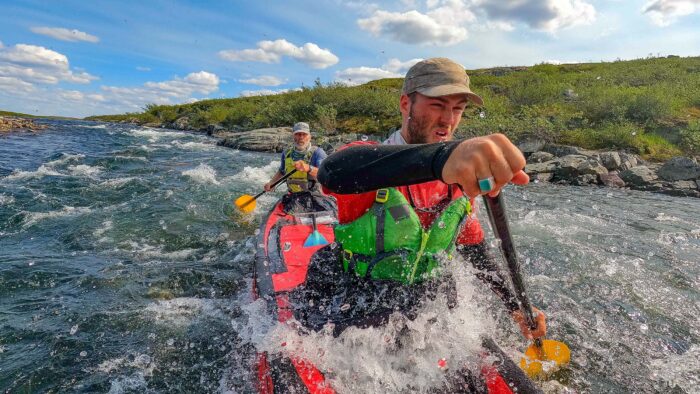
"He's a smart guy, and he's calm under pressure," Wolf said of his partner. "I had a few other people turn me down [for the trip] before a lightbulb went off, and I went, 'Oh yeah, what about Arturo?' He's a capable guy who I knew could pick it up quickly and grind when needed."
Animal encounters
And partner is the optimal word. According to Wolf, it wasn't a mentor/mentee relationship. But the younger man still had plenty of eye-opening experiences. In one notable vignette, a decidedly unshy grizzly wandered up on the two in the middle of a portage.
And their firearm, brought along expressly to ward off ursine guests, was packed up and out of reach. Some firm calls of "Hey bear!" and paddle clacking managed to drive the curious animal away, but it was a tense moment.
"That's when Arturo realized, 'Oh, we could really get eaten out here,'" Wolf said. "Before that, he was just kind of obliviously confident. After that, he was a little more cautious, and we kept the gun on hand just in case we needed it."
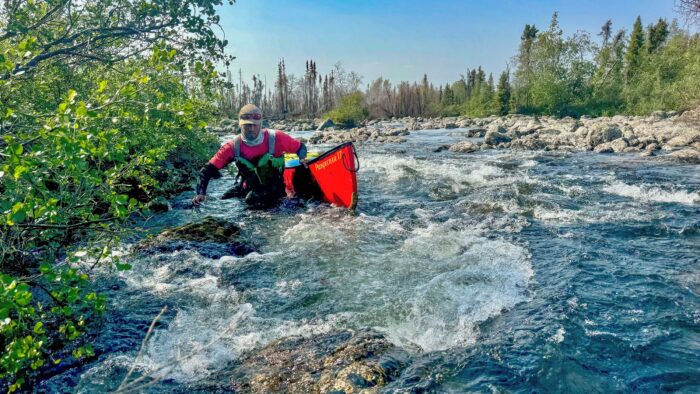
Potential bear problems aside, some of Wolf's favorite moments sprung from wildlife encounters. A huge herd of muskox and a dawn meeting with a wolf were particularly memorable. The human Wolf had just finished his morning business when the animal came sniffing around, eventually rolling in Wolf's excrement before trotting off, presumably to transmit whatever information that act gathered to his buddies elsewhere.
Mental and physical trials
As Wolf pointed out in his chat with ExWeb, the adventures he undertakes require both physical and mental fortitude. Injuries were minor, aside from a knee tweak incurred by Simondetti while hauling a heavy pack. Simondetti is a skateboarder and skier when he isn't adventuring, so he was able to self-diagnose the wound as non-trip-ending. After a few days of hobbling, he was good as new. Plus, he had a secret weapon on his side.
"He's a young fella," Wolf said with a laugh.
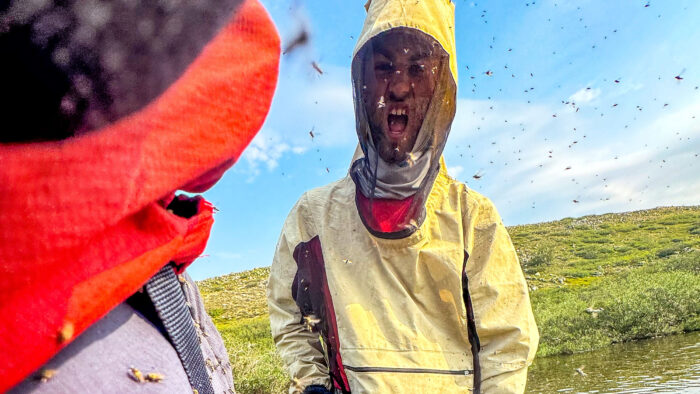
As for the mental side, sometimes a well-timed bit of serendipity can make all the difference. Fighting terrible headwinds toward the end of a long paddling day, the duo rounded a bend and saw a broken-down hut.
"It wouldn't look like much to anyone else. But it had four sides and a roof," Wolf said.
To these two weary paddlers, it was a palatial escape from the elements and a much-needed mental boon — especially as they waited out 100km winds for a day and a half there.
What's next?
If you're feeling a little jealous of Simondetti and wondering what it would be like if a random co-worker of yours invited you on a once-in-a-lifetime expedition, never fear. Simondetti occupied himself along the way by shooting hours of video footage. He recently turned his efforts into a two-part film available on YouTube.
Both men lost considerable weight during the trip, a condition Wolf likens to feeling "lean and hunted." But the pounds will come back on, and soon enough, the well-rested Wolf will start eyeballing maps and scoping out his next adventure. He likes to wait until January or February to plan his upcoming endeavors.
Besides, as he said, "I definitely got my fill this year."
Zach Fritz and Taylor Rau are experienced canoeists but had never tackled anything on this scale before. For 105 days, beginning in mid-May, the two Minnesotans paddled 4,400km from Fritz's family cabin in Minnesota's North Woods to Chantrey Inlet, Nunavut, on the shores of the Arctic Ocean.
Both had their introduction to canoeing through a local program called Les Voyageurs, which took high school students on 30 to 45-day canoe expeditions in northern Canada. The two returned to work as guides for the program. At a turning point in their lives, they decided to tackle a big journey.
Fritz mapped out the way, studying the accounts of fur traders and explorers. The northern part of their route included the classic Barren Ground rivers -- the Kazan, the Dubawnt, the Thelon, and the Back.
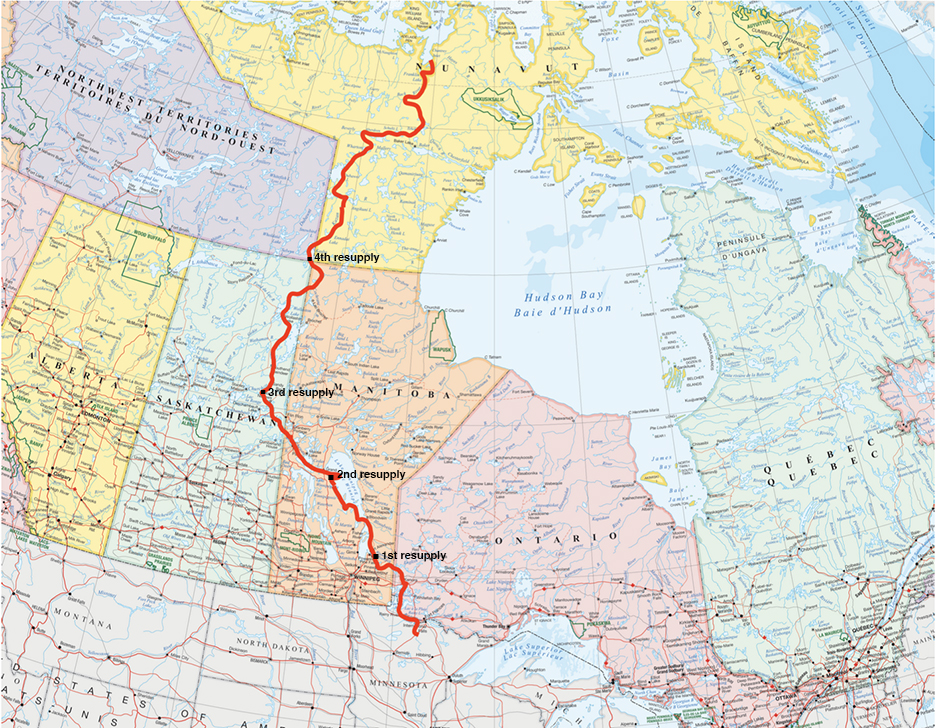
Excerpts
Excerpts from their blog give the flavor of an immense journey, well-planned and carefully executed:
We pushed off in Big Falls, Minnesota early on May 6 with a beautiful first day. The Big Fork River had a wonderful current and some amazing scenery to go with it.
We quickly jumped onto the Rainy River and headed west, where we were met with some rainy days, but a lovely tail wind. We used our sail to help us make some good distance on the river. Quickly, we were in a routine and able to get ourselves a day and a half ahead of our schedule.
Toward the end of the Rainy River, we officially crossed into Canada and moved onto Lake of the Woods, our first of several large lakes to cross.
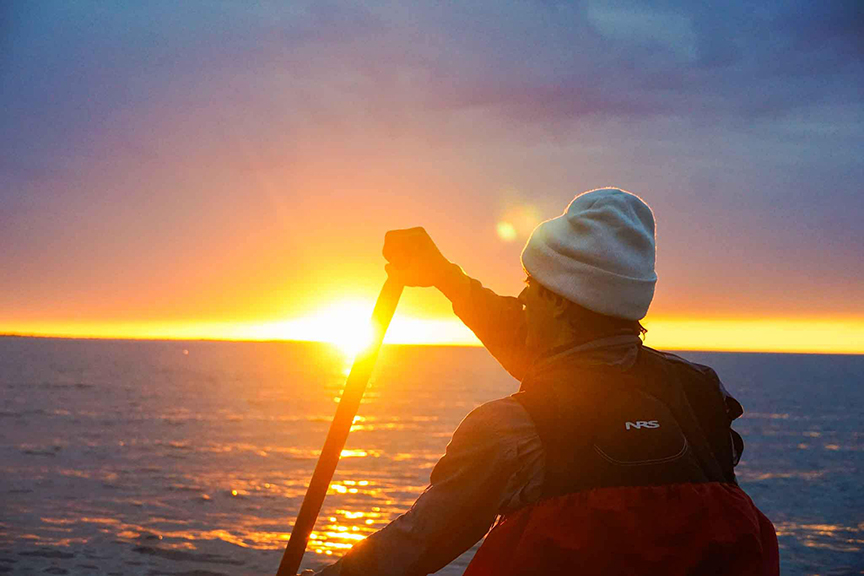
We are leaving the Winnipeg River system tomorrow and working our way north and across Lake Winnipeg -- the biggest lake of our trip. We are expecting to have a more irregular schedule, as we move when the wind will allow us.

Saskatchewan River
At the end of the lake, a large, expansive wetland, where the Saskatchewan River flows into the lake, was like a big maze...What we saw in front of us and what was on the maps were very often conflicting. There were many braided channels to take. A few attempts through reedy passages that either ended abruptly or fizzled into nothing finally brought us into the main lazy channel with tall grasses hemming the rivers shoreline.
For several days, the current of the river increased and so did the size of the river. Its long, winding bends forced us to stick close to shore and follow the inside bends of the river to paddle with the slowest current against us. Going upstream, our strokes felt heavier and sluggish and our muscles working much harder.
The Saskatchewan reminded us a lot of the Mississippi River back home, with similar width, current, and milky waters. The rivers edges were lined with grassy, willow shores and an abundance of poplar and box elder trees.

A long day
For our first full day on the [Sturgeon Weir] River, we waded, lined, and pulled our canoe up almost continuous sets of shallow rapids. Constantly getting in and out of the canoe, paddling against the current when we could, then either pushing or pulling the canoe when the current was too strong. It was a very long day.

Throughout our time on the Kazan, we only had one portage to do to avoid a nasty rapid early on. The rest of our time on the river was spent traveling down its large, fast flowing channels with easy whitewater here and there. Just about the best paddling anyone could ask for...
Day by day, we slowly saw the trees leave, patches here and there would appear on the hillside, but largely disappeared after we left Ennadai Lake. As we transitioned from the treeline to the tundra, we began to see new wildlife and plants along our route. The Kazan offered us our first of many caribou, muskox, and more varieties of birds than we could keep track of.
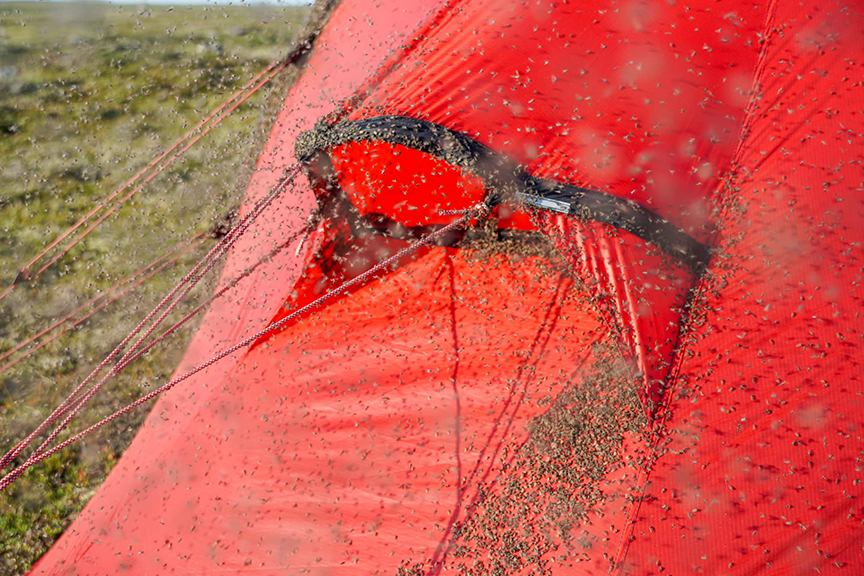
Windbound
We began following what seemed like a decent river. Very quickly, our hopefulness faded as the river practically dried up to rocks. We knew quickly we were in for a very long day...
We spent the next few days finishing up the big lakes of the Thelon. For the most part, the winds were tricky side winds from the north, and finally, on our last day on Aberdeen Lake, the north wind became too strong and we had to call it a windbound day shortly after lunch. The north winds brought cold temps off the Arctic Ocean. Bundled up, we fished from camp and caught some more beautiful lake trout...
Finally, about 5:30 am on day 105, we took our final paddle strokes across Cockburn Bay and onto Victoria Headland along Chantrey Inlet on the Arctic Ocean. Arriving at our final destination, we had been paddling for almost 24 hours straight and gone well over 100km during that time. Our canoe beached, we gave each other a hug of excitement...

In an interview with MRPNews, the canoeists admitted they aren't planning any further adventures in the immediate future. Fritz has just relocated to Wisconsin, where his girlfriend lives, and Rau has begun a new job.
After 140 days split between cycling, canoeing, sailing, and hiking, the Canada west-to-east team has finished their 6,900km crossing of Canada's north.
Nicolas Roulx and Catherine Chagnon set out from Beaver Creek on the Alaska-Yukon border on April 21. They started on bicycles for a 16-day "warm up" as they pedaled east on the Alaska Highway. After a nasty climbing accident shortly after his 2021 Canada north-to-south expedition, Roulx hoped that the relatively relaxed start would help ease him into a long, physical journey.
The ride went smoothly, with "some knee pain, but nothing serious or abnormal," before the real test began on the wild rivers of the Northwest Territories and Nunavut.

A battle against the clock
Roulx and Chagnon traded their bicycles for canoes near the entrance to the Little Nahanni River. This juncture marked a couple of key milestones. They would be joined by friends Mathieu Beland and Guillaume Moreau, and their carefully laid plans would require some on-the-fly adjustments.
This was the first team change of the expedition, but not the last. Roulx and Chagnon were due to add Dominic Roulx (Nicolas Roulx’s brother) and Laurence Garceau later in their 2,800km canoe section and eventually joined a completely separate sailing team at Baker Lake. This made for strict time constraints because of the logistical complications involved with different team members joining for various sections. Keeping a few days ahead of schedule was vital.
Thus, arriving at the Little Nahanni River to find it was still frozen threw a spanner in the works. With no time to wait for the river to thaw, they took the “rarely frequented” Flat River to join the Nahanni.
“A rather rough start, the river getting rocky and crowded, quickly gave way to smoother days,” they wrote.
The team put in long days, paddling 10-11 hours and covering around 60km daily to stay on track.
"We didn’t do much research on the Flat River. We paddled it for about a week, and fortunately, it was a little shorter than the Little Nahanni. This gave us a natural time advantage of a few days. We also paddled very, very fast," Roulx told ExplorersWeb.
Paddling and portaging
From the Flat River, they moved on to the Nahanni. It was a stressful transition. The river was flooded with plenty of sediment and "muddy, ugly water." Then came the Liard, which empties into the Mackenzie River, where they struggled upstream for roughly 350km. Though a large river, they encountered shallow water and battled headwinds, making for a tough stretch.
Yet despite the route change and some brutal paddling, they managed to stay just ahead of their tight schedule. In fact, their timing was perfect. As they approached Great Slave Lake at the end of the Mackenzie River, there were still big chunks of ice around. “We couldn’t have arrived even a week earlier,” Roulx explained.
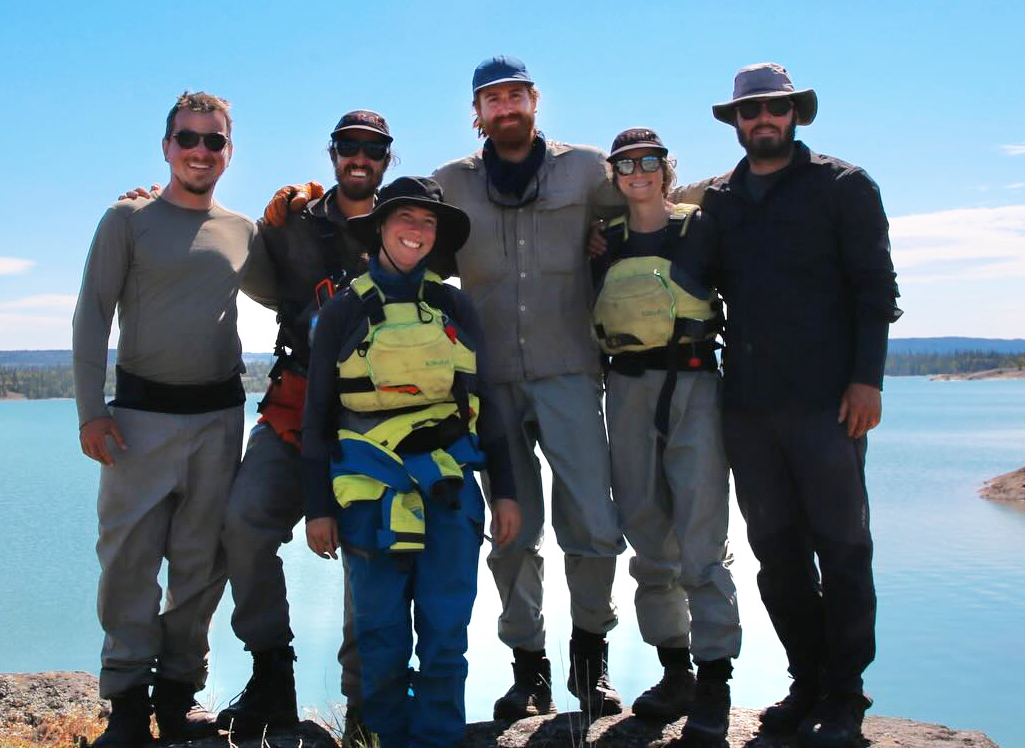
Soon after, Dominic Roulx and Laurence Garceau joined them on Great Slave Lake for the final canoe section to Baker Lake. The expanded team of six set off from the small community of Lutselk’e on June 25 and almost immediately faced a series of intense portages through a chain of lakes.
This was a theme for the 41-day journey, during which the team racked up 37 portages, moving from boreal forest to tundra and inching east.
Canoe to sailboat
On August 4, they arrived at Baker Lake with time to spare before the next stage of their journey. Here, they left their friends and their canoes behind and joined a sailboat crew.
The sailboat Anorak had just completed a long journey north from Quebec. After a change of crew, they set off again to ferry Roulx and Chagnon to Baffin Island. In theory, the next 2,600km should have been a relative breeze compared to their slog in Canada's wild interior. But it was not to be.
"The journey from Baker Lake was fierce. From early on, we had to sail in close to 45kmph headwinds right in the middle of Hudson Bay. It was at this moment that Nicolas [Roulx] learned the hard way that he gets seasick," they wrote in late August. "For us, this was 2,600km of waves, strong winds, staying up to sail 24/7, vomiting, turbulent horizons, dark waters, and soda biscuits to calm the stomach."
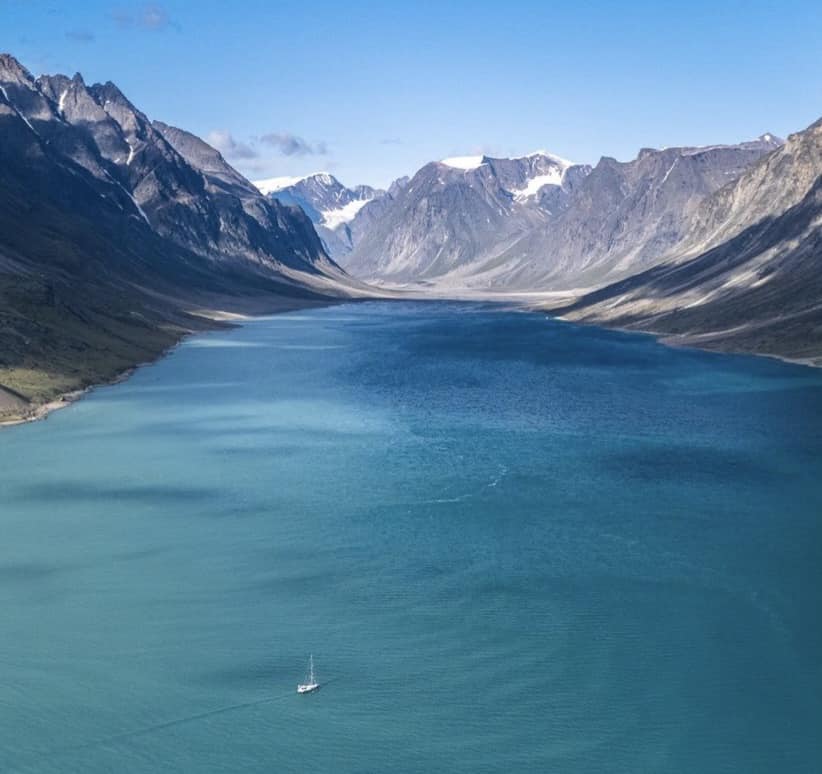
After 16 sometimes unpleasant days, the pair were likely relieved to return to dry land and start their final section: eight days hiking from Pangnirtung across the Cumberland Peninsula to the east coast of Baffin Island.
On the afternoon of September 7, they finished a quite remarkable journey.
"Without a welcoming committee, we arrived at the edge of a dizzy cliff-lined fiord just north of the Arctic Circle," they wrote yesterday. "To go further, we would have to cross the Davis Strait by boat, which would lead us to Greenland. All the lakes, rivers, waters, and mountains we've traversed through the Yukon, Northwest Territories, and Nunavut have been occupied by the First Peoples for millennia. The words that we think are the most relevant to utter right now are those of our gratitude."
Some of the best adventures are born over a beer, and British chef Mike Keen is a prime example. While chatting with a colleague in a bar in Nuuk, Greenland, Keen mused about the challenging Greenlandic language, especially the abundance of Q's. This casual conversation sparked an ambitious idea: to embark on a kayaking journey from Qaqortoq in the south all along the west coast to Qaanaaq in North West Greenland.
While spending six summers working in Greenland’s restaurants, Keen had dabbled in kayaking during his free time, but he was far from seasoned. He had never combined camping with kayaking. After a divorce and a grueling stint of 100-hour weeks in a British pub, Keen decided to channel his newfound freedom into something big. He poured his energy into raising funds and crafting a unique twist for his ambitious adventure.
Before the coronavirus pandemic, the British chef had been deep into writing a book about fermentation techniques in cooking. Inspired by this project, he decided to blend his kayaking adventure with a culinary experiment. He would eat like traditional Inuit did, solely on sea mammals and fish.

Barred by ice
Keen started on his adventure from Qaqortoq in April 2023 after a two-week delay due to stubborn sea ice. The spring was colder than usual, dropping at times to about -10°C. Despite his limited experience, the British chef made steady progress along the first third of the coastline. However, the waters around Nuuk presented a new challenge with strong tidal currents and sea ice that he hacked a way through with an ice axe taped to his paddle. He had also previously battled rough seas near Paamiut.
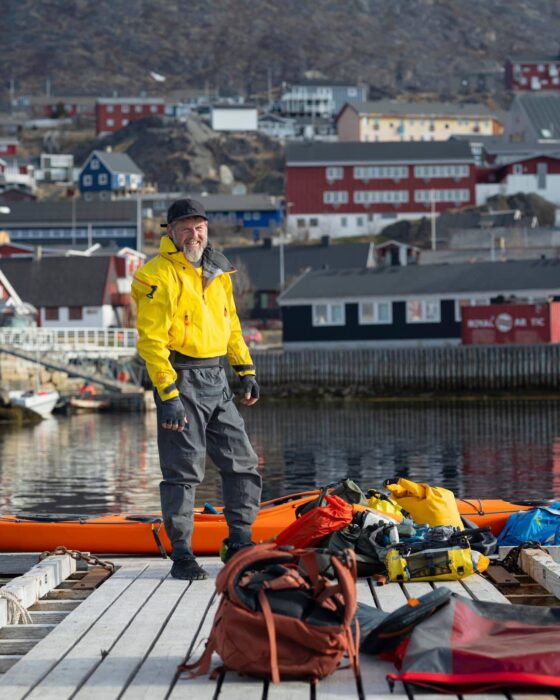
Adhering to his Inuit-inspired diet, the British adventurer carried just 5 to 10 days of food at a time, replenishing his supplies in coastal villages. Local hunters often generously donated food, especially big portions of seal meat. He cooked the seal in local kitchens, then packed it along with dried fish and whale meat for the next leg of his journey.
As Greenland TV began to cover his journey, Keen often found himself with a cozy bed for the night. He estimates that during the first leg, he camped just half the time and was graciously hosted by locals for the rest.
Unfortunately, this part of the journey concluded after covering roughly two-thirds of the distance — 95 days and 2,100km — at Upernavik. Locals informed Keen that he couldn’t proceed through the vast expanse of sea ice and iceberg-choked Melville Bay.
The crux: Melville Bay
Unable to bear the cost of waiting in Upernavik for the ice to clear, Keen headed back to the UK to regroup and plan to pick up the following year where he left off. The setback was particularly disheartening because he had collected letters from locals at the journey’s start, with the promise of delivering them further up the coast, a nod to traditional Inuit postal routes.

In July of this year, Keen returned to Upernavik with a renewed determination to reach Qaanaaq. This time, for safety, he arranged for a small support boat to follow him across the vast, open waters of Melville Bay. Fortunately, the sea ice was manageable enough to allow steady progress. For the first two days, Keen covered a strong 60km each day, staying close to the coastline until he was pushed out to sea toward Canada while trying to find a route through the maze of sea ice.
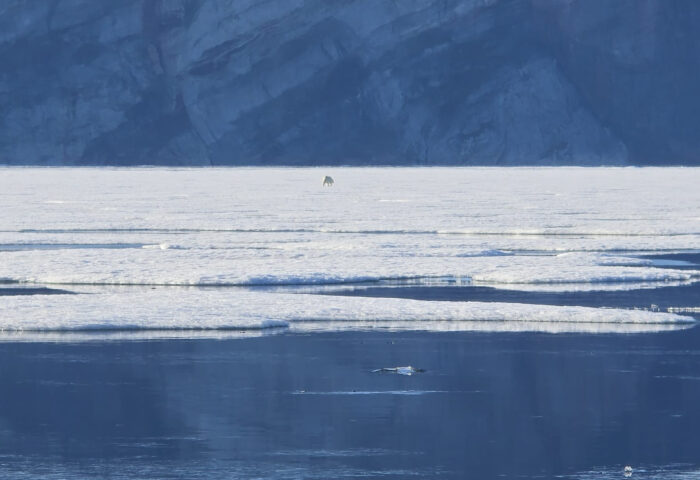
Support boat
Without hesitation, he called in the support boat to tow him back toward the shore for the night, where he slept on the boat. Keen operated on his own terms without the pressure of adhering to notions of support that would count against him if he made claims on the style of journey or sought records.
The next two days beyond Melville Bay were without hazard. Unlike the earlier part of his journey, there were no villages to stop at, forcing the British kayaker to camp wherever he could find somewhere to beach along the rugged coast.
To his surprise, Keen encountered just one polar bear during his journey, though he found himself more worried about potential walrus attacks. He carried a rifle for much of the trip and used a homemade alarm fence a few times but usually didn't bother.

The British chef-turned-kayaker parted ways with his support boat at Savissivik, ready to tackle the rest of the journey solo. Along the way, he often set up camp beside ancient Inuit stone circles, though he never stumbled upon other historical landmarks. One notable stop was at the American Pituffik Space Base, formerly known as Thule Air Base, where Keen treated himself to a night’s rest on an old military spring bed — an unexpected comfort in the midst of the more remote northwest coast. A hunter and his wife used their residents' permissions to allow the Briton to enter the restricted base.
Homecoming in Qaanaaq
After 19 days on this second leg and 114 days in total, Keen finally paddled into Qaanaaq, completing his 3,200km journey. In this remote town, the British adventurer received a hero’s welcome from locals who had been following his adventure in the media. Keen won the hearts of the community by embracing their food and immersing himself in their culture.
Now back in the UK, Keen is already planning his next adventure — a deep dive into the hunter-gatherer lifestyle with a tribe in Ecuador.
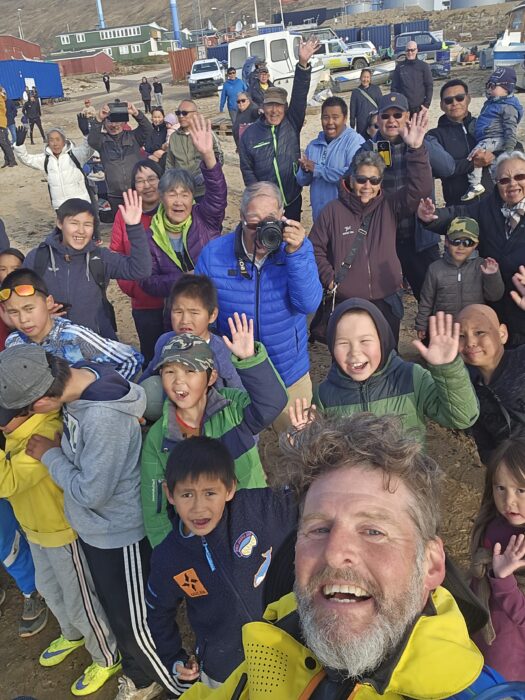
Justin Barbour has been home for about 40 days after his year-long journey canoeing, snowshoeing, hiking and biking 3,890km from northern Quebec through Labrador to the southern tip of Newfoundland. "My feet are just coming back to life now," he says.

The journey from Puvirnituq to the Cape Pine lighthouse is not an iconic route like skiing to the South Pole, but it's an original route, and he did it his way. That meant being flexible with his decisions. As a one-off project that no one will re-do in the near future, he didn't have to worry about fine points like "unsupported." He did what made sense, both from the travel conditions and from how he felt.

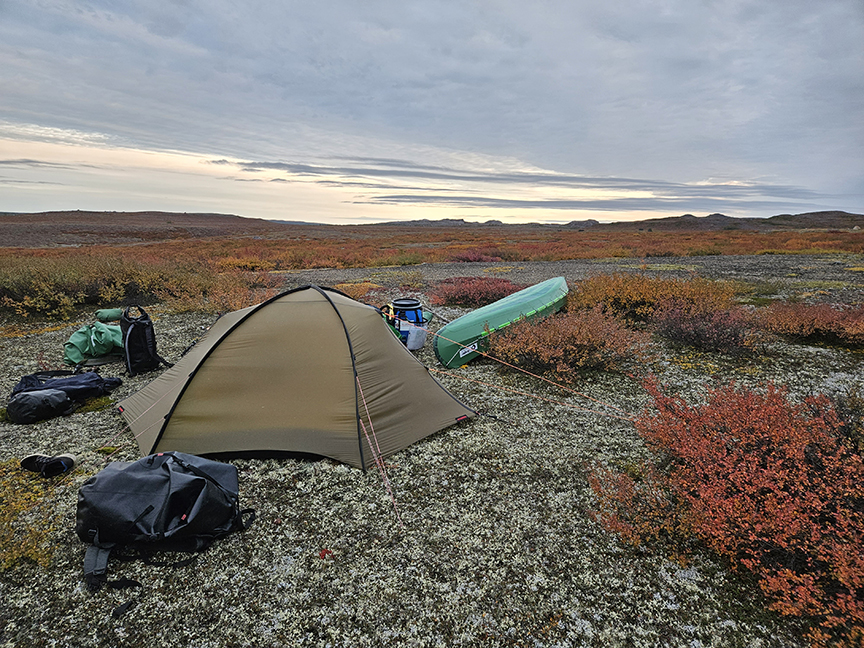
Thus, last fall, he didn't quite make it by canoe all the way to the village of Schefferville before winter set in. He was 210km short. So a helicopter pilot friend picked him up and flew him to Schefferville.
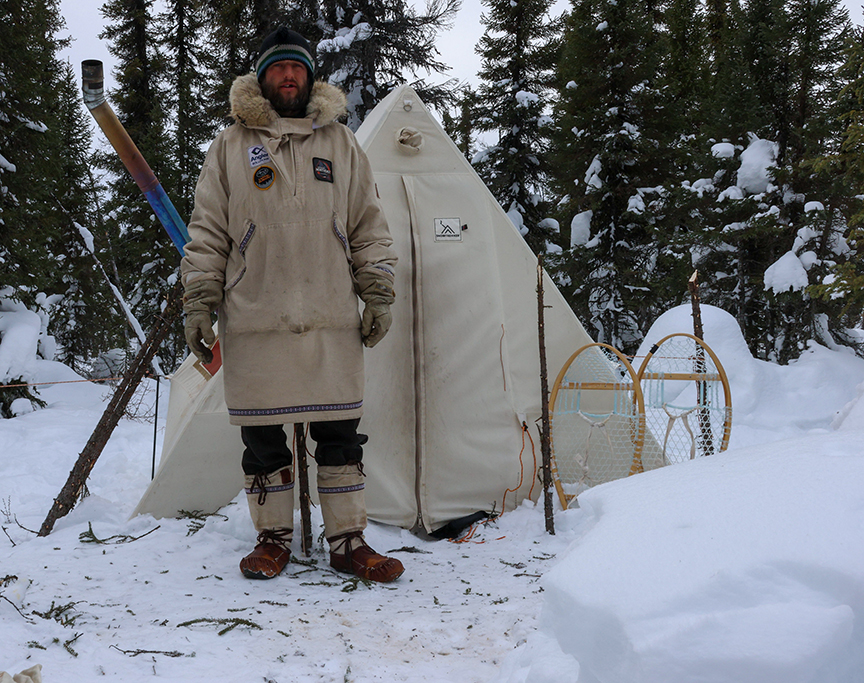
Waiting for winter
Here, he lived in his bush tent just outside town for several weeks until winter had firmly frozen all the lakes, creeks, and rivers that he used as highways. Then on January 1, his friend flew him back to where he had left off, and Barbour started the snowshoe leg of his journey.
Months later, as the subarctic spring was coming on, he had the opposite problem. He'd already traveled 267km from the Trans Labrador Highway through southern Labrador. But in early April, the rivers of southern Labrador were beginning to open up, and he could not drag his toboggan overland through the thicker forests. He needed those waterways.
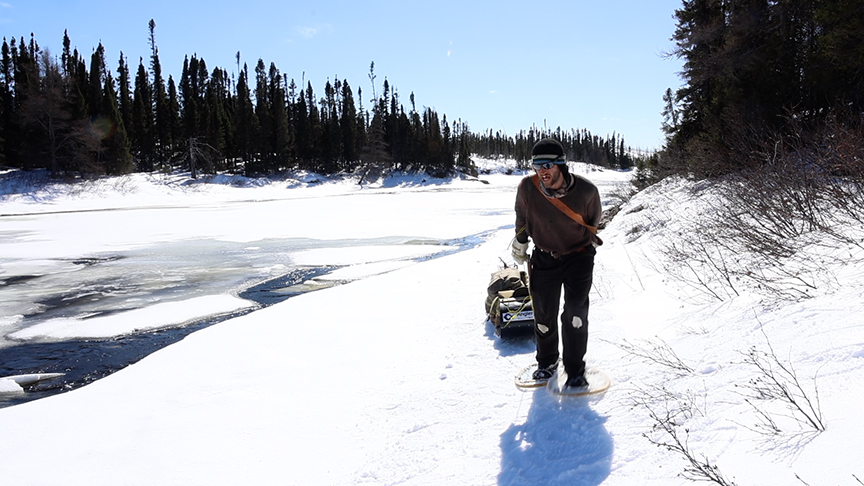
"I didn't want to wait four weeks [for the canoeing season]," he said. So his helicopter buddy again stepped in and conveyed him back to the Trans Labrador Highway, which he'd first snowshoed across weeks earlier. Here, he decided to mountain bike the length of southern Labrador instead of traveling cross-country. He camped along the wilderness roadside at the end of each day.

Last sections
Finally, he decided that he didn't want to kayak the 18km or so across the Strait of Belle Isle from Labrador to the island of Newfoundland. It had been raining for days, and "I was starting to wear thin," he admitted. There was also the additional logistics of getting a kayak over to him. So he took the ferry across, then began to hike across that big island to its southern tip.
When you're out for a few weeks on a trail that hundreds of people do, like Hercules Inlet to the South Pole, these mechanized shortcuts matter. When you're out for an entire year on a route all your own, they don't. They become sensible adaptations in what remains a mega-trek.
Barbour's final tally of self-propelled travel:
Canoe: 1,150km
Snowshoe: 700km
Bike: 1,500km
Hike: 550km
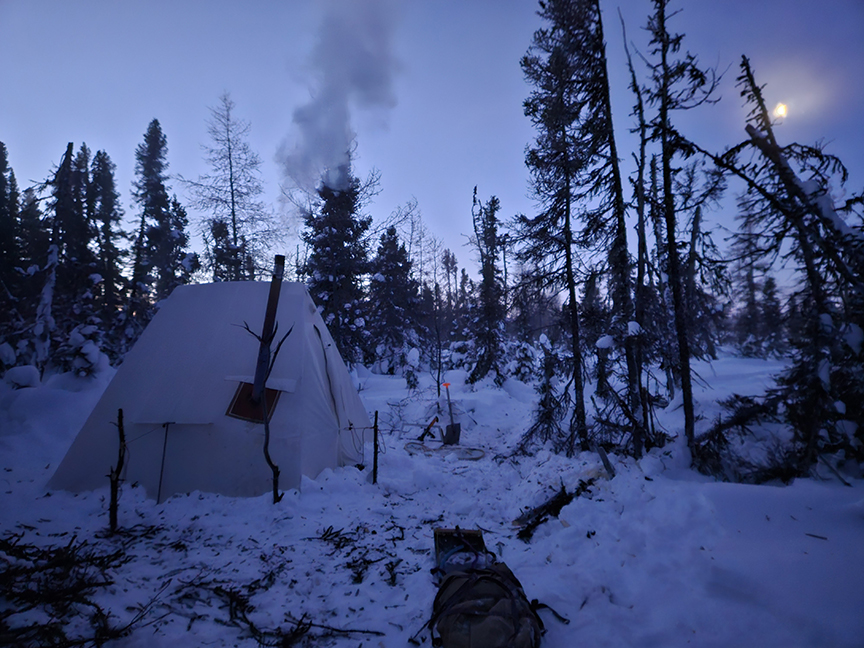
Old-fashioned travel
During his year-long journey, he largely traveled the traditional way, pulling a toboggan and using snowshoes like the region's Innu people or Labrador's Height of Land trappers. In winter, his wood-heated bush tent let him dry his clothes at night. While heavier than the modern mountain tent he used during the canoe section in northern Quebec, it also made heavy expedition parkas and sleeping bags unnecessary. "The more you know, the less you need," he said.
And while he resupplied at several spots, he also hunted ptarmigan and fished along the way.
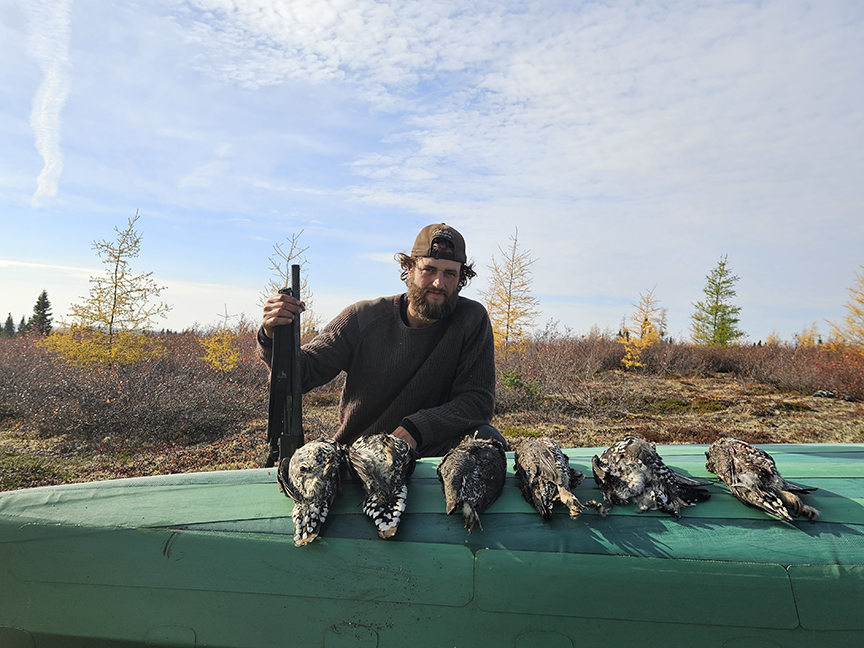
This was by far Barbour's longest trek, but it wasn't his first. In 2017, he trekked across Newfoundland. In 2018, he tried to canoe from east to west across Labrador and northern Quebec -- a shorter version of this trip -- but started too late in the summer and had to bail after 80 days and almost 1,000km when winter set in.
At the time, Barbour was a teacher in Newfoundland, covering grades K to 12. But by 2019, he'd discovered that the YouTube videos of his solo journeys were popular; some garnered millions of views. He also gave presentations and secured sponsorships. Now, this is what he does.
He has only "loose thoughts " about what's next. Maybe he'll cross Alaska, but that's a ways off. He plans to spend the next months editing the hundreds of hours of material into coherent stories. 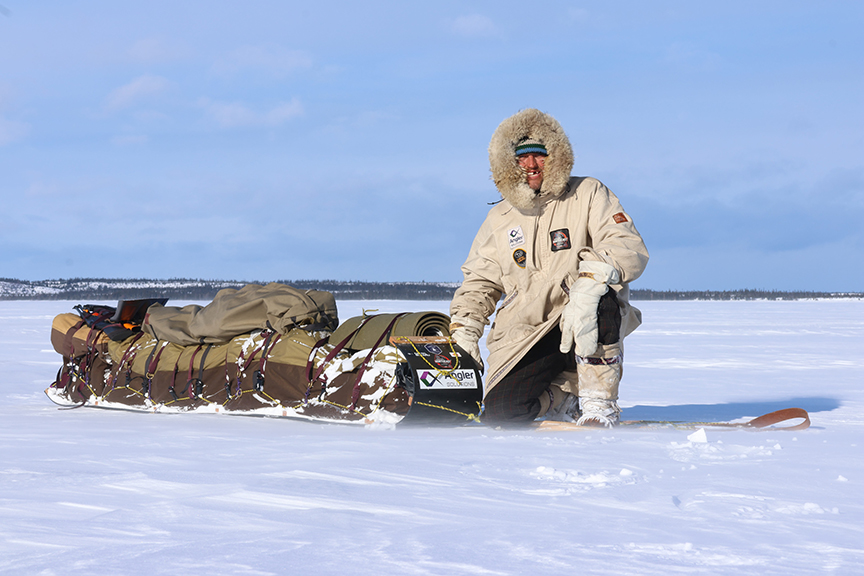
Canadian kayakers Simon Carrier and Maxime Geoffroy had a good run of it, but they've ended their attempt to paddle the Northwest Passage from west to east.
They are currently on the west side of King William Island and are now backtracking to finish in Gjoa Haven, the island's one community.
They decided to end their 3,000km expedition this week after a little more than halfway. Thick sea ice has blocked their progress around the northern tip of King William Island. Further ice awaits them in Peel Sound before they can transit Bellot Strait to the eastern High Arctic and clear waters.

Since beginning their journey in mid-July, the pair has typically averaged over 40km per day. But even if the ice clears in a week or so, the delay would force them to paddle deeper into the stormy fall. Their final 1,000km would include several big open-water crossings, including 80km from Somerset Island to Baffin Island. At this time of year, night has returned, and they would not be able to enjoy the advantage of constant daylight on these marathon crossings.
Still not easy
Climate change has made the Northwest Passage easier than it was in John Franklin's day, when sea ice often locked ships in place for years, with fatal results. But some summers, ice can still throw a wrench into mariners' plans. In 1846, Franklin's ships themselves became trapped in the ice at the northern tip of King William Island. All died.
The kayakers could have chosen to go around the south coast of King William Island -- the standard route through the Northwest Passage. But if ice conditions are good, the northern route saves many kilometers. Last year, the Arctic Cowboys took advantage of a good ice year to transit the entire Passage from east to west, including an ice-free route around northern King William Island.
Even if Carrier and Geoffroy had taken the southern route, the passage through Bellot Strait remains ice-choked for the moment. Several small yachts are currently anchored in eastern Bellot Strait, waiting for the ice to clear before they can continue west.

Dodging the polar bears that have been abundant in Greenland this summer, Matteo Della Bordella and his team have opened a new big wall route on the isolated east coast.
In a short text, the Italian climber said they were safely down from the wall (see feature images) and that their new route was 1,200m, 35 pitches, with difficulties up to 7b. The team included Silvan Schupbach and Alex Gammeter of Switzerland, and Symon Welfringer of France.
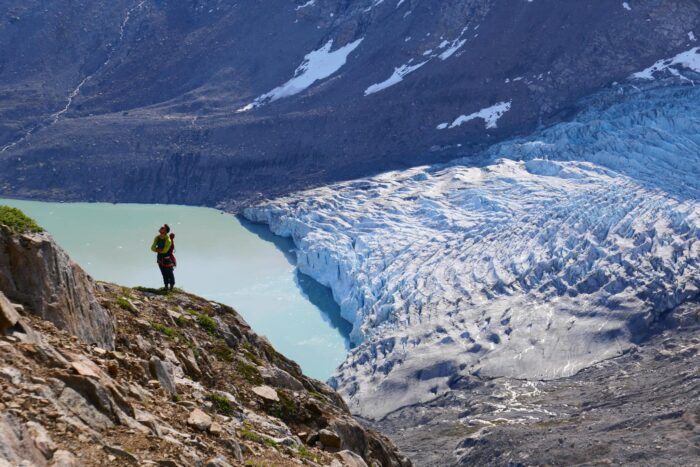
The team had had to retreat from a previous attempt last week because of 100kph winds. This week was their last chance, as they were running out of food and time. They still have at least two weeks of kayaking to make it back to civilization, and they want to keep the expedition self-sufficient by avoiding motorboat support.
Polar bears around
Their kayak route may not be straightforward, as polar bears remain abundant in southern Greenland. One bear even visited their camp a few days ago. "It ran away as soon as it saw us," Della Bordella wrote.
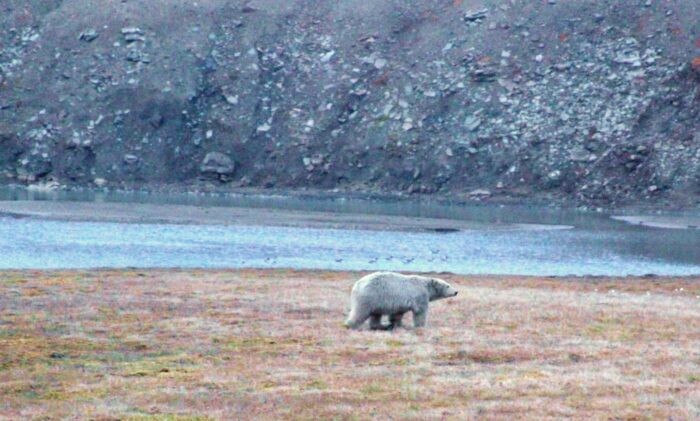
The Canada West-to-East team has shape-shifted as it has progressed across the country. Over 106 days, Nicolas Roulx and Catherine Chagnon are the only constants, while their means of travel and teammates change. The pair have just arrived in Baker Lake, Nunavut, having cycled and now canoed 4,200km north of the 60th parallel.
Baker Lake marks the end of the most difficult segment of their journey, a mammoth 2,800km canoe section. It included plenty of portaging and a route change when they arrived at the Little Nahanni River to find it was still frozen. By the end of the canoeing, their team had expanded to six, as Mathieu Beland, Guillaume Moreau, Dominic Roulx (Nicolas Roulx’s brother), and Laurence Garceau joined the party.
Plenty of legwork
The 41-day journey from Great Slave Lake to Baker Lake went relatively smoothly but required a meaty 37 portages.
They left the small community of Lutselk'e on June 25. They immediately faced a tough choice: cross a huge open-water bay but avoid a portage or do a series of eight portages through a chain of lakes that would halve the distance they had to travel. Tired of paddling on the lake, they selected the second option.
"It is a choice we would make differently in retrospect. It was hard on the body, with billions of black flies and a dense, steep forest. We had to put the canoes on ropes up slopes...It was very intense," Nicolas Roulx told ExplorersWeb.
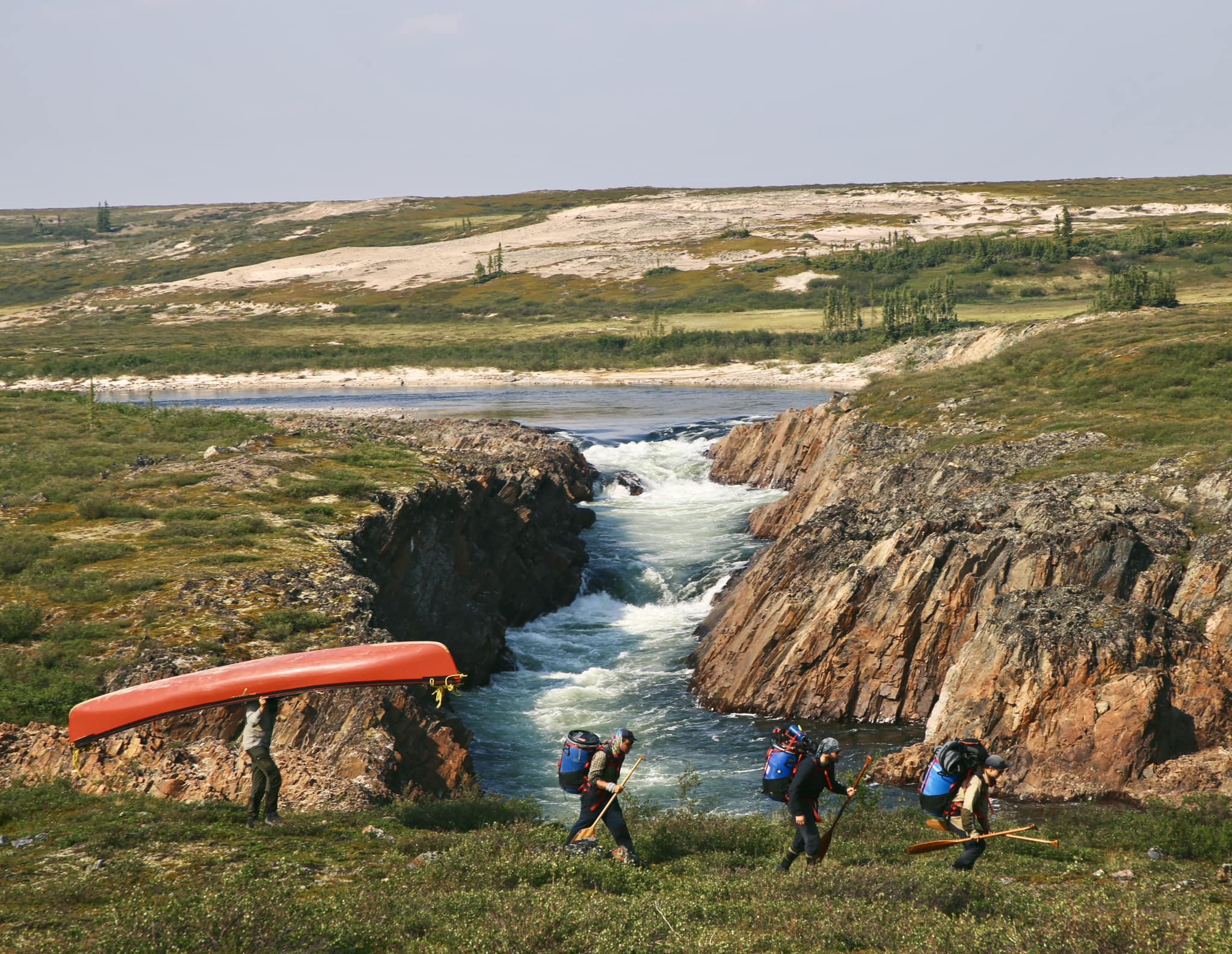
After the grind, there was no let-up. "We took the ancestral route of the illustrious and notorious Pike’s Portage, [which took us] from boreal forest to tundra," Roulx said.
As the name suggests, Pike's Portage required more legwork. It also brought more wildlife of the blood-sucking variety.
They then joined the Hanbury River, a small, narrow river with plenty of rapids that they could not run in their canoes. This required more portages.
"The portages went through the tundra, so no trees, a bit easier, but windier," Roulx explained. "The landscapes were astonishing. So many big rapids and big waterfalls. River life as we like it but with incessant portaging."
They then joined the Thelon River, a fast-moving but smooth-riding river. It eventually gave way to a series of lakes for the 200km run to Baker Lake. After a few frustrating windbound days, they arrived on August 4.
Canoe to sailboat
The next stage of their journey is very different. They'll leave their canoes behind to join a sailboat crew. The sailboat Anorak has just completed a long journey north from Quebec to meet them.
It's highly unusual for a sailboat to come inland to Baker Lake, and Roulx says that the locals are excited about its impending arrival.
"They are eager to see the boat. We've been so happy to meet with people here. It has been a great, warm welcome. People tell us that it might be the first sailboat coming to Baker Lake in 50 years."
Roulx and Chagnon will leave their canoe crew behind to join Louis Poliquin, Laurent Poliquin, Hubert Poliquin, and Jean-Michel Vezina sailing east.
The boat will ferry them across Hudson Bay to Pangnirtung on Baffin Island. This should take around 20 days, with a few stops in Inuit communities along the way. From Pangnirtung, Chagnon and Roulx will continue on foot, hiking for 10 days to Qikiqtarjuaq on the east coast of Baffin to finish off their enormous expedition.
Two paddling teams heading in opposite directions in the Northwest Passage will pass each other soon.
Kayakers Simon Carrier and Maxime Geoffroy have made a strong start after their roundabout road trip to the Northwest Territories. The pair set off on July 7, paddling west to east from near Tuktoyaktuk toward Pond Inlet. Over the first two weeks, they averaged over 40km a day before slowing slightly. They experienced their first windbound day on July 28.
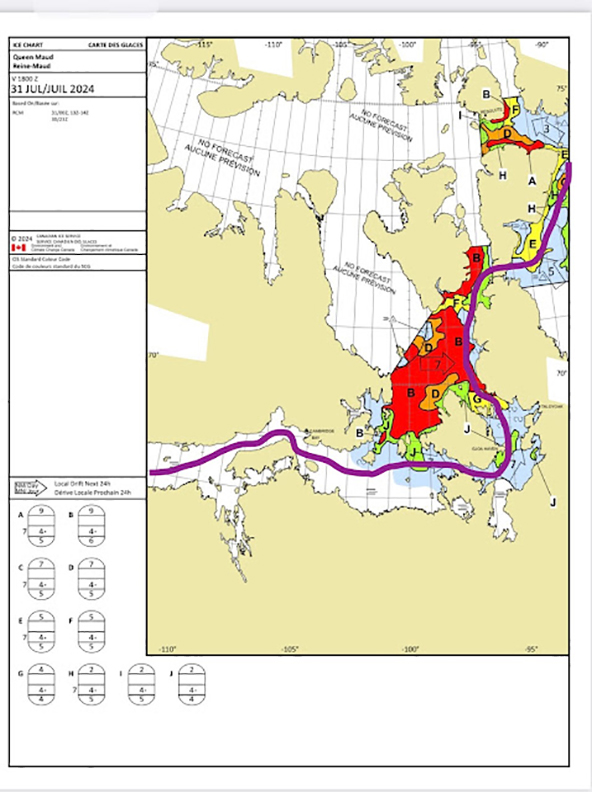
Judging by their GPS updates, they are still on track and have a great shot to complete the passage, if the ice cooperates. They are currently paddling toward Cambridge Bay, the halfway point of their journey. The sea ice is still blocking the passage from the western to the eastern part of the High Arctic, but it has plenty of time to clear before they reach that crucial area.

Rowing the other way
Meanwhile, on Aug. 2, an ocean rowing team led by Leven Brown set off from Cambridge Bay heading west. Brown led an attempt to row the passage in 2023, but the team aborted because of unstable fall weather. Mike Harding is the only returning crew member, while Stefan Hacker and Art Huseonica joined the 2024 team. The new team is not rowing the full passage. Instead, they continued where the last group called off their row.
They made a smooth start but anticipate rough weather soon.
"We expect to anchor in Wellington Bay for quite a few more days unless the weather forecasts should change dramatically," Stefan Hacker wrote on his blog today.
It's been a bumpy start, but Canadians Simon Carrier and Maxime Geoffroy have set off to kayak the Northwest Passage.
The pair planned a roughly 3,000km kayak journey from Tuktoyaktuk to Pond Inlet but needed to complete an equally long road trip from Edmonton before starting. The car journey went smoothly until on July 5, with a fair distance remaining, they found the Mackenzie River ferry out of order.
It was unclear when the boat might be repaired. This left them with three options. They could wait indefinitely for the ferry, begin their adventure by kayak from the ferry terminal (adding a disheartening 300km of kayaking to their already formidable distance), or kayak across the river to the ferry drop-off point and hope for another lift from there.
They eventually opted for the latter and were fortunate to find someone waiting to cross the other way by car. With the ferry non-operational, the driver had time to kill and gave them a lift to Eskimo Lake, nearer the mouth of the Mackenzie River and closer to their starting point at Tuktoyaktuk.

Finally on the water
After spending a night on the shores of Eskimo Lake, they finally began paddling on July 7. They are carrying 40 days of food and will pick up more supplies in Cambridge Bay (about halfway through their journey).
Some summers, sea ice still blocks the Northwest Passage. In 2018, for example, no vessel made it through. Even large ships had to turn back. In other years, the Passage has been wide open. Last year, West Hansen, Jeff Wueste, Eileen Visser, and Mark Agnew became the first to paddle the entire Passage in a single season.
Hansen's team paddled the opposite way, heading east to west. It will be interesting to see how Carrier and Geoffroy find conditions in the Passage.
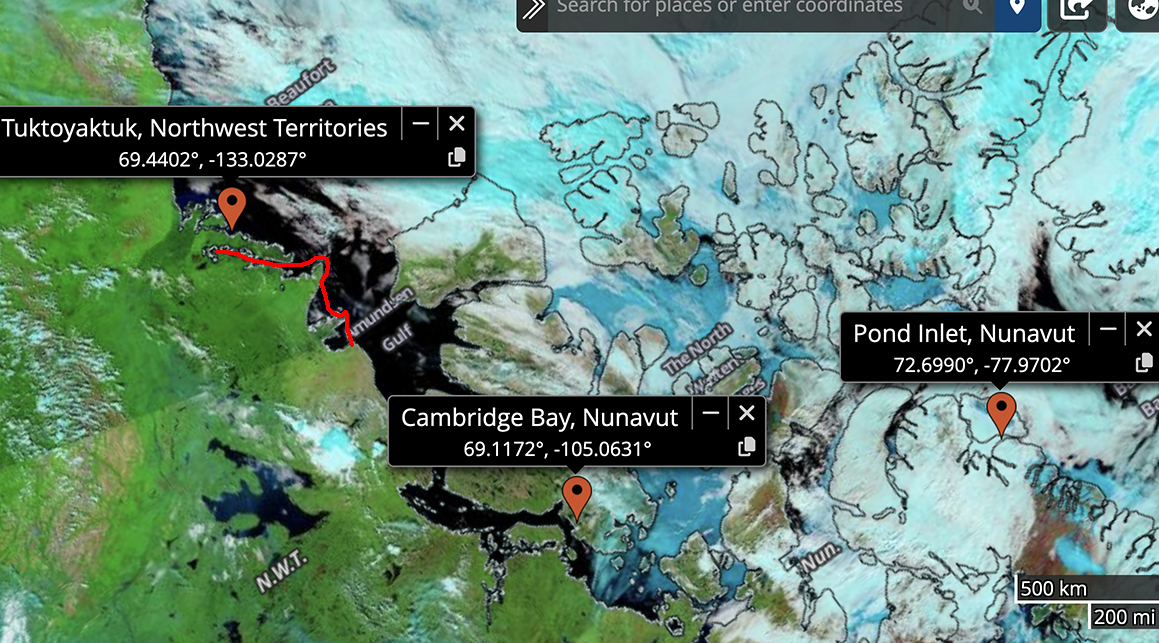
Speaking to Radio Canada, they reported no problems as they set off.
"Currently, the melting of the ice is going well, but sometimes with the winds and everything, [the ice] moves onto the edge of the coasts...but there are many tools that we can use to see how the ice moves, so we are well equipped [to handle that]," they said.
The duo anticipates the full journey will take 80 days. You can follow their GPS updates here.
Serial adventurer Frank Wolf has already knocked over two expeditions in 2024. In March, he paddled a sea kayak 500km around the Darien Gap between Panama and Colombia. In early June, he joined an all-Canadian team for a 325km sled trip to Baffin Island’s Clyde River region. Today, Wolf embarks on a significantly longer journey. He is paddling 1,400km from Yellowknife in Canada's Northwest Territories to Kugluktuk in the Northwest Passage.
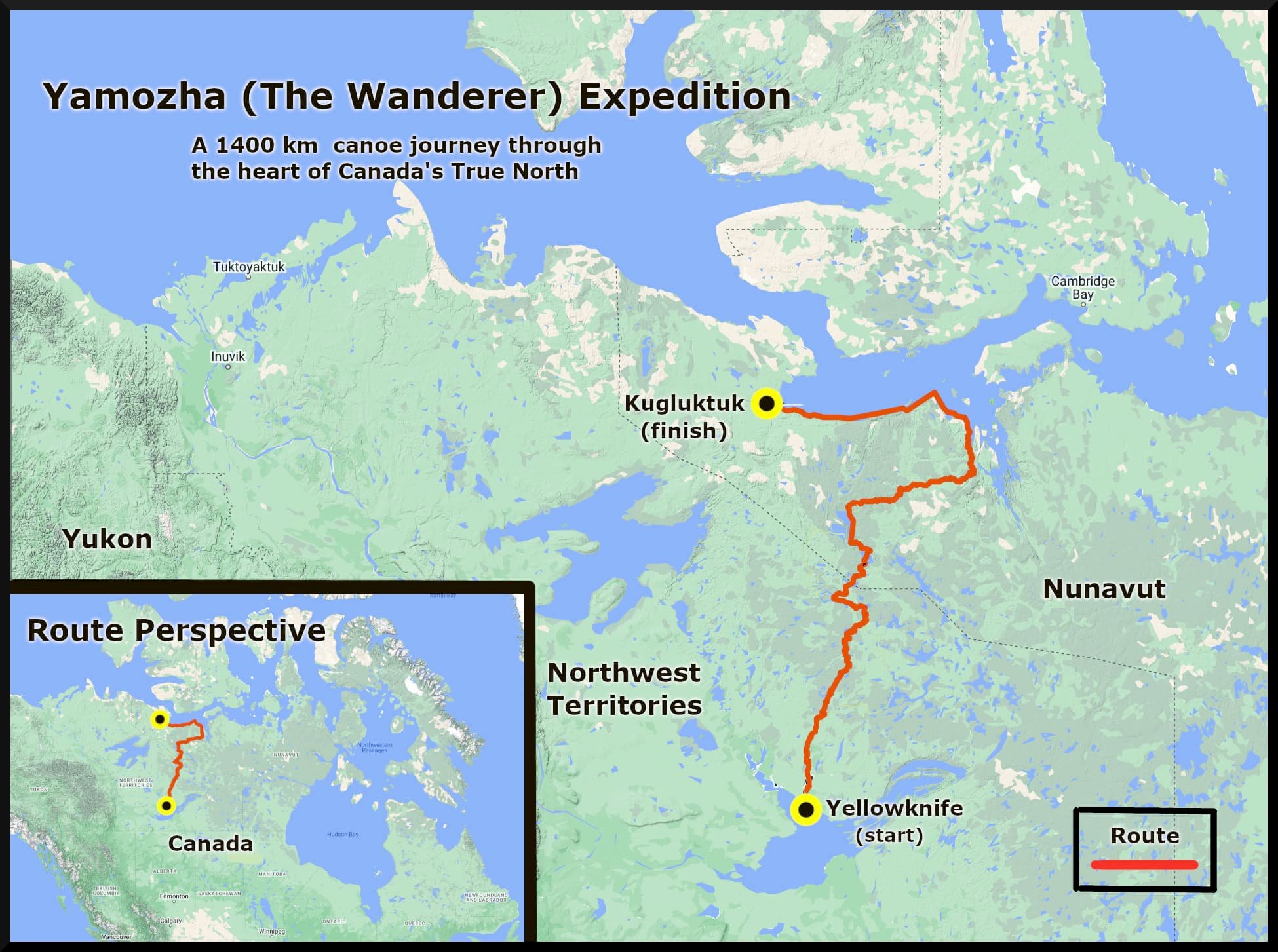
Filling in the wilderness
"Over the years, I've slowly been filling in the wilderness, drawing lines on the map of northern Canada," Wolf told ExplorersWeb, a couple of days before flying to Yellowknife. "This route is a fresh landscape for me. It's a rarely used route...but I realize that these routes have been traveled for thousands of years by the Dene people."
Inspired by those journeys, Wolf has christened the paddle the Yamozha Expedition. Yamozha means "traveler" or "wanderer" in the indigenous Dene language. Wolf won't be wandering alone. He is teaming up with Arturo Simondetti. It will be the pair's first expedition together.
At first glance, they seem an odd couple. Simondetti is just 23, while Wolf is in his mid-50s. But a chance meeting through their part-time work demolishing derelict boats was enough to convince Wolf that an expedition partnership would work.
"Grinding through these boats on 10-hour days showed me that he'd have the mentality to do this kind of journey," Wolf explained. "He's also a talented filmmaker...something of an old soul. We clicked straight away."
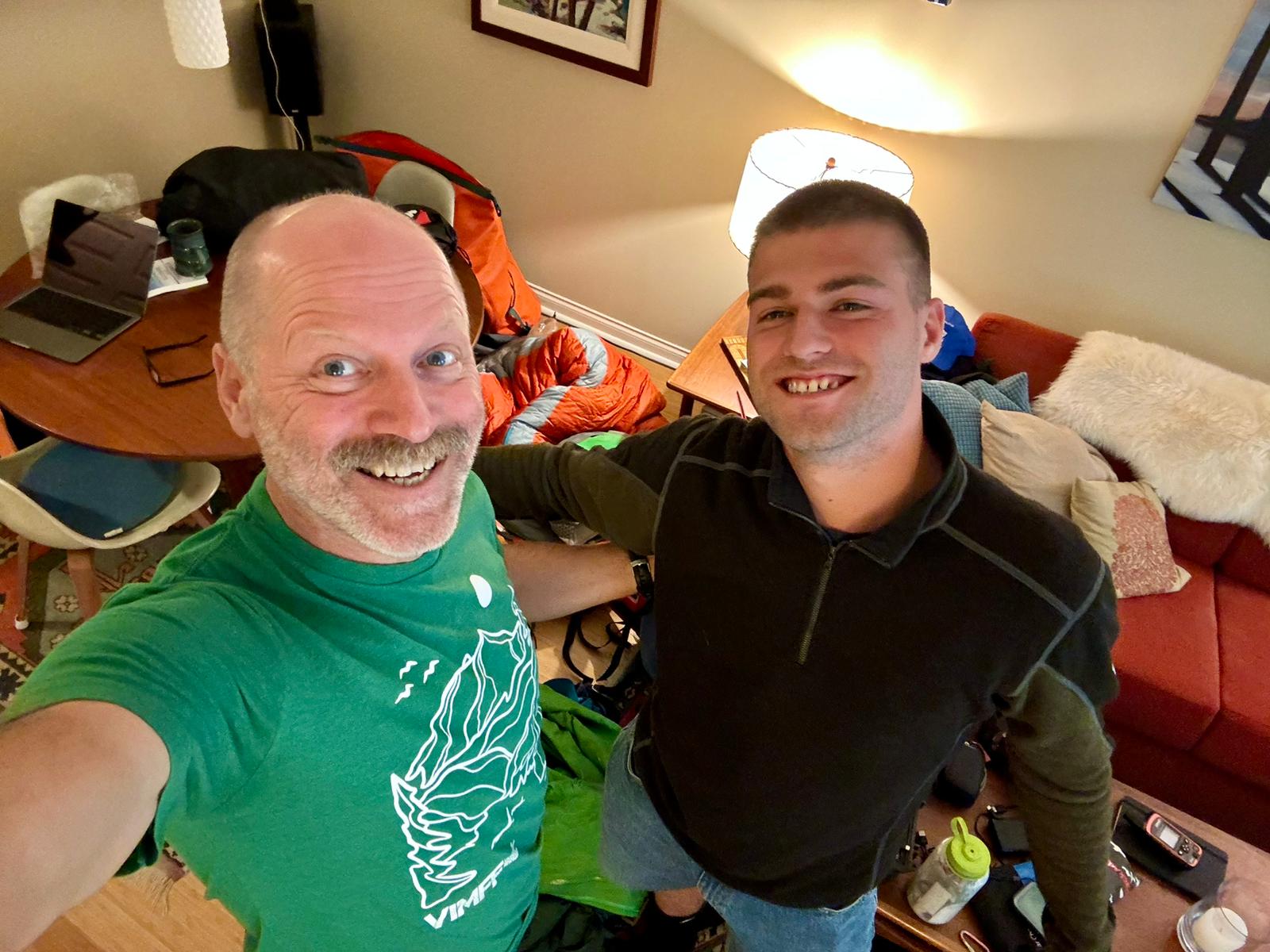
Paddling and portaging
Wolf thinks their route, which includes the Yellowknife River, Winter River, Coppermine River, and Hood River systems and ends with 325km of ocean paddling in the Arctic Ocean, should take around 33 days. They'll take 38 days of food, giving a slim buffer for windbound days.
The plan requires a 40km per day average, but Wolf thinks their daily totals will vary considerably.
"Early on, it'll be a physical challenge working upstream on the Yellowknife River. With all the food, we'll be carrying the most weight, and water levels are a bit lower this year. There will be some challenging portaging, dragging, grinding...Here, we might only average 20km each day," he said. "But once we're on the Hood and the Coppermine, we should move pretty good."
With roughly 10 hours on the move each day, Simondetti will shoot footage for a film as they go. Wolf believes that's for the best.
"Shoot when it's hard or there's no point," he says. "There's no point doing a film if it's just lunchtime in campsites. You've got to get the good stuff in between."
You can follow the Wolf and Simondetti's progress via their Garmin InReach here.
There are lots of ways to make a boat. You can carve one out of a solid log, wrap cedar strips around a mold, or use animal skin, plastic, fiberglass, or any number of space-age materials.
But growing one out of a mushroom? That's a new one for us.
But that's exactly what California-based sculptor and mushroom enthusiast Sam Shoemaker has done.
Shoemaker, who seems like a fun guy (sorry), posted photos and videos of his truly unique watercraft late last month. The 15-foot boat is roughly kayak-shaped. It lacks a cockpit and is a true sit-on-top. As for how he built it? Patience, a mold, some wild mushrooms, and a lot of fungal know-how.
"A hemp substrate was used to propagate this mycelium inside a two-part mold over the course of about four weeks," the artist wrote in his post. "After the gestation period, the mycelium was dried to render a strong, hydrophobic, and inert cork-like material. The boat was sealed with locally sourced beeswax. No rigid internal support fame or hardwood was used."
View this post on Instagram
Impractical, he admits
Mycelium is the root-like structure of fungus — the part that lives underground and can form into dense mats, as Shoemaker has so deftly shown. Shoemaker explained that he used an ocean fishing kayak as the mold. The craftsman admits that his boat — which weighs a hefty 61kg — is a kayak only in the roughest possible sense.
"You are welcome to call this floating object a kayak, a paddle board, a boat, or a baguette. For the people who have said that [61kg] is an impractical weight for a boat this size, I agree. Using a wild mushroom to build a boat is something worth doing, but highly impractical," he noted.
For all its weight, Shoemaker's boat seems to track fairly well (peep the above video.) The artist plans to make more boats and will eventually try to cross "the Catalina Channel on a mushroom."
An unusual, if worthy, goal!
Nicolas Roulx and Catherine Chagnon are now nine weeks into their latest mammoth trip through the Canadian North. After a forced route change and a grueling paddle against the current on the Mackenzie River, they are now making their way across Great Slave Lake.
Their current route is part of a 2,800km canoe journey that comprises the most difficult section of their 6,500km west-to-east epic through Canada.
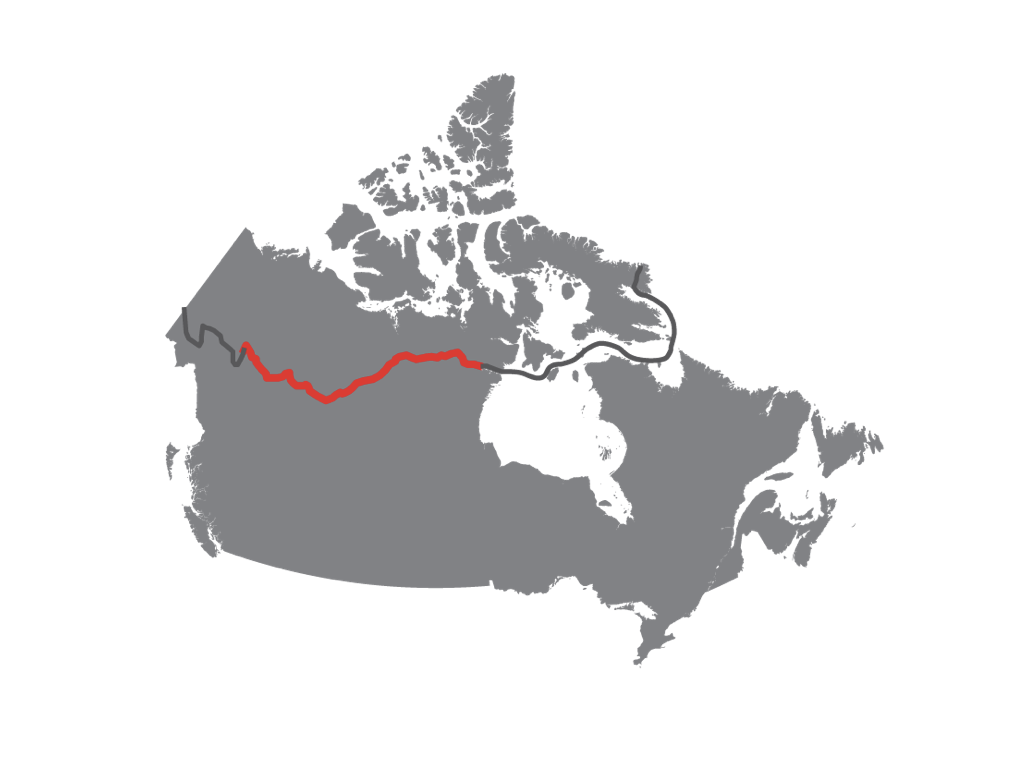
A tight schedule
In our last update, we reported on a change of route. At the start of their paddling section, they discovered that the Little Nahanni River was still frozen. Because the team has to keep to a tight schedule (with members joining and leaving at specific points on specific dates), they didn't have time to wait for it to thaw. Instead, they took to the Flat River with friends Mathieu Beland and Guillaume Moreau.
"We didn't do much research on the Flat River. We paddled it for about a week, and fortunately, it was a little shorter than the Little Nahanni. This gave us a natural time advantage of a few days. We also paddled very, very fast," Roulx told ExplorersWeb.
From the Flat River, they moved on to the Nahanni, then the Liard, which empties into the Mackenzie River. There, they struggled upstream for roughly 350km. Though a large river, they encountered shallow water and battled headwinds, making for a tough stretch.
"But we knew that the two other legs of our planned canoe route would be very hard too, so we were determined to get ahead of schedule, and it worked," Roulx said.
Their timing turned out to be perfect. As they approached Great Slave Lake at the end of the Mackenzie River, there were still big chunks of ice around. "We couldn't have arrived even a week earlier," Roulx explained.
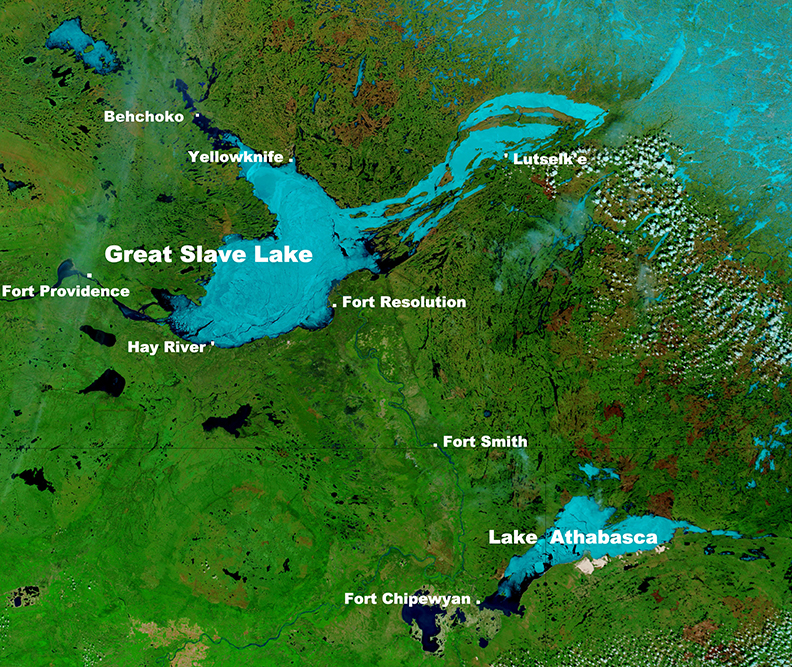
Great Slave Lake
Having successfully dodged the ice, the foursome arrived at the community of Hay River on the southern shore of Great Slave Lake on June 6. There, the team expanded to six with the addition of Dominic Roulx (Nicolas Roulx's brother) and Laurence Garceau (Nicolas Roulx's girlfriend).
In the two weeks since, they've been paddling across Great Slave Lake. After 400km, they arrived in the community of Lutselk’e early this week. They have averaged roughly 40km per day and only suffered four windbound days -- impressive for such a big lake. This allowed them to keep ahead of schedule for the third paddling leg, a 45-day stretch to Baker Lake that they began on June 25.
Big portages to come
Roulx suffered a nasty leg break shortly after the group's 2021 expedition and endured a long road to recovery. But so far, his leg hasn't caused any issues.
"For now, my leg is holding up very well," Roulx said. "Thus far, it has mostly been an upper body challenge, but the real challenge will be in the next six weeks. This section of the canoe trip will be hard on the lower body because we'll have so many portages. Lots of elevation, hilly...it'll be very rough."
More than two weeks after disappearing while kayaking Switzerland's Melezza River, the body of talented and groundbreaking whitewater kayaker Bren Orton has been found, Swiss authorities have announced.
According to multiple news outlets, Orton's body was found by sailors in Lake Maggiore, also called Verbano, a lake on the south side of the Alps.
Orton's body was discovered on May 30. He had previously vanished from view after "becoming trapped in a recirculating feature" on the Melezza, according to a social media post by his sponsor Pyranha Kayaks. Details are still scarce on what, exactly, led to the accident. Those close to Orton have asked that people refrain from speculating about it. The kayaker was 29.
Another of Orton's sponsors, Palm Equipment, posted confirmation of the body's discovery.
View this post on Instagram
"The outpouring of love and support from the paddling community since Bren went missing has been extraordinary. This support has been a profound source of strength for all of us, especially for his family and close friends," the post reads.
A short life, a lasting legacy
Canoe and kayak governing body Paddle UK's brief bio of Orton paints a picture of a young, talented athlete taken too soon by the sport he lived and breathed.
Orton's love affair with kayaking began at age nine, and by 16, he'd already paddled the White Nile in Uganda. He competed internationally and rose to worldwide fame in his sport after completing a 39m descent of Mexico's Big Banana Falls in 2018. It was the second-highest descent ever made by a kayaker.
Very much a product of his time, Orton ran a highly successful YouTube channel he dubbed Senders. The content is high-octane and light-hearted, further illustrating what a crushing blow Orton's friends, family, and fans have experienced. Some of the latest videos include "pre-season" content recorded in Italy weeks before the accident.
“A huge loss to the paddlesport community, Bren Orton’s trailblazing achievements in freestyle and paddling adventures across the world have made a huge impact," Paddle UK CEO Ashley Metcalfe said in a statement.
“Without question, he will be remembered as one of our sport's greatest-ever ambassadors," she continued.
Nicolas Roulx and Catherine Chagnon have completed the cycling section of their six-month, 6,500km west-to-east journey through Canada. The section went smoothly until they approached the entrance to the Little Nahanni River. Just under 100km short of their entry point, they found the road blocked by mud and snow. They also discovered the river was still frozen — not ideal for paddling.
Friends Mathieu Beland and Guillaume Moreau have joined them for the upcoming 2,800km canoe section. However, the frozen Little Nahanni necessitated a change of plan. They would take the "rarely frequented" Flat River to join the Nahanni.
"A rather rough start, the river getting rocky and crowded, quickly gave way to smoother days," they wrote in a recent update.
Ahead of schedule
Last week, they joined the Nahanni. It was a stressful transition; the river was flooded, with plenty of sediment and "muddy, ugly water." The team covered 200km on the Nahanni, passing through three massive canyons, before moving to the Liard River.
The team has strict time constraints because of the logistical complications involved with different team members joining for various sections of the trip. Keeping a few days ahead of schedule is vital so the team puts in long days, paddling 10-11 hours and covering around 60km.
When we’re not outdoors, we get our adventure fix by exploring social media and the web. Here are some of the best adventure links we’ve discovered this week.
Botswana’s Female Safari Guides: In Africa, working as a tour guide is often seen as a man's job. But women are increasingly challenging this stereotype.
In Botswana's Okavango Delta, there are now a handful of female "polers" or mokoro guides. They expertly steer canoes over the wetlands, sharing knowledge of their home with tourists. Most of these women have been steering these boats since they were children. The canoes have long been the main mode of transport for their communities.
Paddling in a Superfund Site: Brad Vogel moved to Brooklyn in his twenties. He was working at a law firm when he first heard of the Gowanus Dredgers Canoe Club. The group would canoe in a canal filled with pathogens, heavy metals, chemicals, and liquid tar. He still wanted to join the club.
A few years later, Vogel gave up his law career, moved to Gowanus to be close to the water, and became the captain of the Dredgers. He has written a book of poetry about the little stretch of canal, the changes in the community, and paddling on the polluted water.
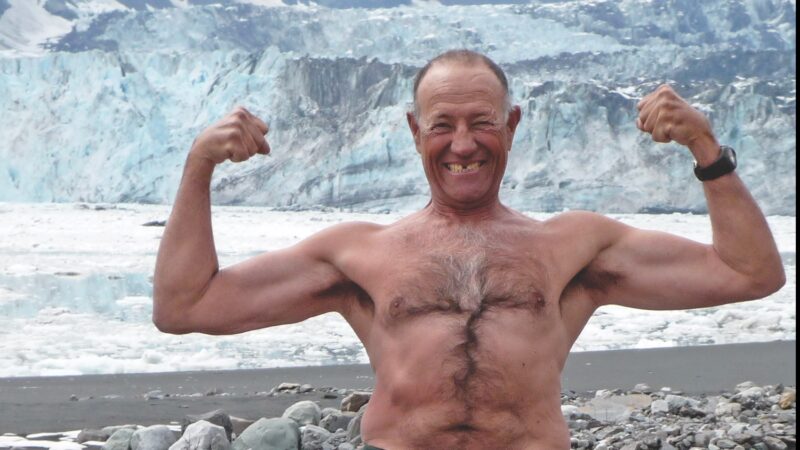
Saving fixed anchors
When You Clip a Bolt, You Can Thank This Guy: Armando Menocal was one of the founders of the Access Fund and its de facto leader from 1986 to 1993. Through the advocacy group and afterward, he fought for climbers' rights and was one of the loudest voices when the government tried to ban bolts in the United States.
Menocal always thought of himself as a trad climber but somehow ended up defending bolts and sport climbing. Now, as the National Park Service and U.S. Forest Service have suggested banning fixed anchors, Menocal's work is more important than ever.
The Long Defeat: The mountains do not always bring success. For all the stories of summits, there are many more failures.
Owen Clarke was trying to summit Tunguraha, a volcano in Ecuador. It was so cloudy he did not even get a clear view of the summit. Downpours left him and his kit soaked through. He trudged back down through the rain and wind. Frustratingly, this was his second attempt at the summit, and it ended the same way as his first. The first failure had irritated him for years. Now, his second bid was just as disheartening.
He thinks one of the reasons it is so tough is that you are acting out what you are doing. As you quit, you have to retreat and make your way back downhill physically. It is an emotionally draining experience. Yet it also makes the victories even sweeter.
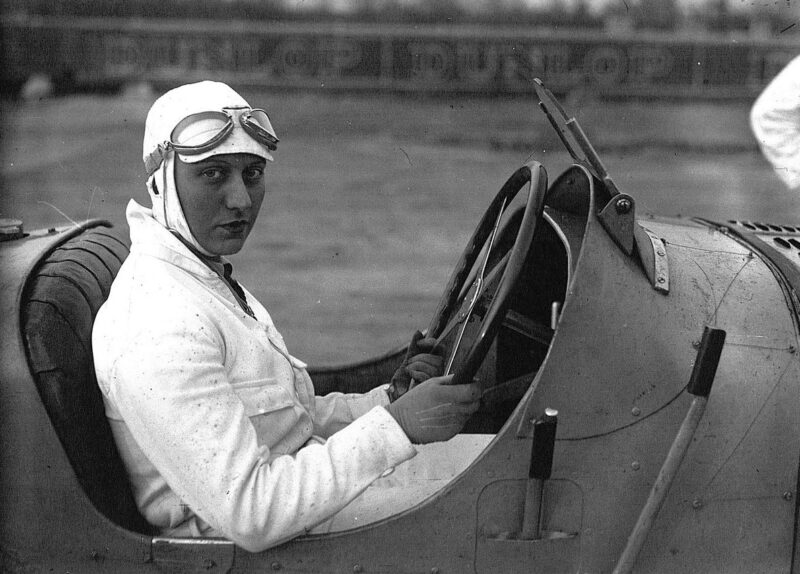
The very first road trip
How Women Used Cars To Fuel Empowerment: Bertha Benz took her husband's "Patent Motor Wagon" out for a spin in 1888. She wanted to visit her mother and was tired of her husband's obsession with inventing the automobile. Some view her journey as the first road trip.
The Many Lifetimes of an Old Red Bike: At six, Iain Treloar was given a little red bike that had been in the family for generations. Six-year-old Iain was not that happy with the bike. It was not shiny and new like the other kids' bikes. Decades later, the little bike was still at his grandma's house when he visited.
He felt a pang of guilt about how ungrateful he had been and asked his grandma about the bike. What unfolded was a story that went back to the late 1800s. It was his grandma's first bike in the 1940s, and nearly everyone in his family had learned to cycle on it.
Five canoes found at the bottom of an Italian lake date back 7,000 years. The ancient craft have lain there since the early Neolithic period.
They are the oldest canoes ever found in the Mediterranean region, where wreckage also includes the famous Bronze Age Uluburun.
Researchers recovered the boats from La Marmotta archaeological site near Rome. Pipe layers stumbled across it by accident in 1989 while working near the Arrone River, about 37km from the Mediterranean coast.
Despite excavations between 1992 to 2009, few researchers knew about the canoes. No in-depth study on them had occurred. A new team, fascinated by the canoes' place in seafaring history, decided to take a closer look.

Different woods for different boats
It turns out that the wooden boats were far more sophisticated than they had imagined. Creating them with the rudimentary tools of the era would have been a considerable feat. Their structure suggested that they served for both long and short trading journeys in the Mediterranean.
In 1998, an earlier team created a replica of one of the dugout canoes. They paddled 800km in it, averaging almost 50km a day in good conditions. Experienced seafarers of the Neolithic could have covered even larger distances with ease.
These ancient mariners built their craft from hollowed-out trees, specifically alder, poplar, oak, lime, and beech. The use of different woods for each boat at the same site is unusual. Each wood had different properties that made them useful for different tasks. Researchers are confident that the use of different woods was intentional.
“These people were working wood with the same knowledge as a carpenter today, just with different tools,” co-author Niccolo Mazzucco told New Scientist.
The canoes vary in size from 4 to 11 meters long. The smaller ones likely served for fishing. The biggest one, made from oak, is far larger than necessary to cross Lake Bacciano, where the site is located. This suggests that it was built for longer journeys around the Mediterranean.
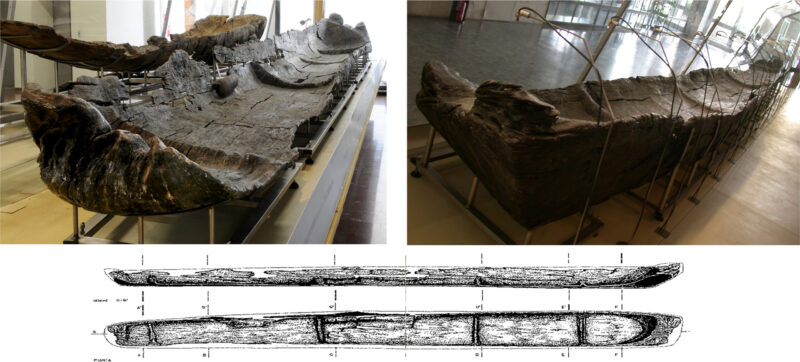
Sailing attachments?
The researchers were particularly excited about wooden T-shaped objects embedded into the walls of the canoe. They have two or four holes in them as attachments points for tow ropes or a sail.
Over the years, researchers have also uncovered pottery, paints, harvesting tools, and grains. La Marmotta was clearly a successful farming community, and must have been an important trade location.
Communities from this time used waterways for trade and communication, but how they did so has always been a mystery. Much of their equipment has disappeared. But the La Marmotta canoes show just how sophisticated seafaring was, even in the Neolithic era.
Their artisans knew how to choose the best trees, how to cut the trunk and hollow it by burning out its middle, and how to stabilize the dugout with transverse reinforcements or perhaps by using side poles or even parallel canoes to create a catamaran.
"Those strategies would have provided greater safety and stability, and greater capacity for the transport of people, animals and goods,” the researchers explained.
Cycling and pulling a sled during the worst of the northern Scandinavian winter were a piece of cake for 26-year-old Lorenzo Barone of Italy. But when it came to kayaking 1,000km from Finnsnes to Vardo in northern Norway, the ragged weather and long, frightening open water crossings proved too much.

One month after beginning the kayak portion of his winter adventure, he still had almost 500km left. Although spring was approaching, it didn't feel like that in northern Norway. He also broke his rudder near Tromso, and his emergency GPS device hasn't worked for two weeks.
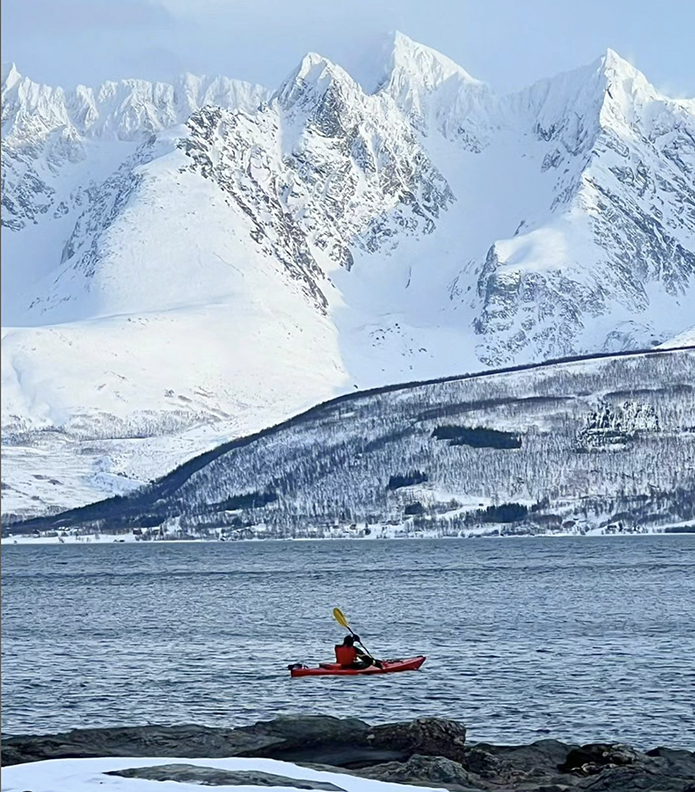
An inexperienced paddler, Barone had tried to avoid an open-water crossing earlier this week by dragging his kayak across a neck of land. Although the experience was better than being out on the water in that gale, it was hardly encouraging, as his Instagram video showed.
Today, he decided to end his journey not in Vardo, but at Norway's North Cape, the northernmost point of Europe. It's only 126km away from his current position. More importantly, it avoids all the big crossings immediately afterward.
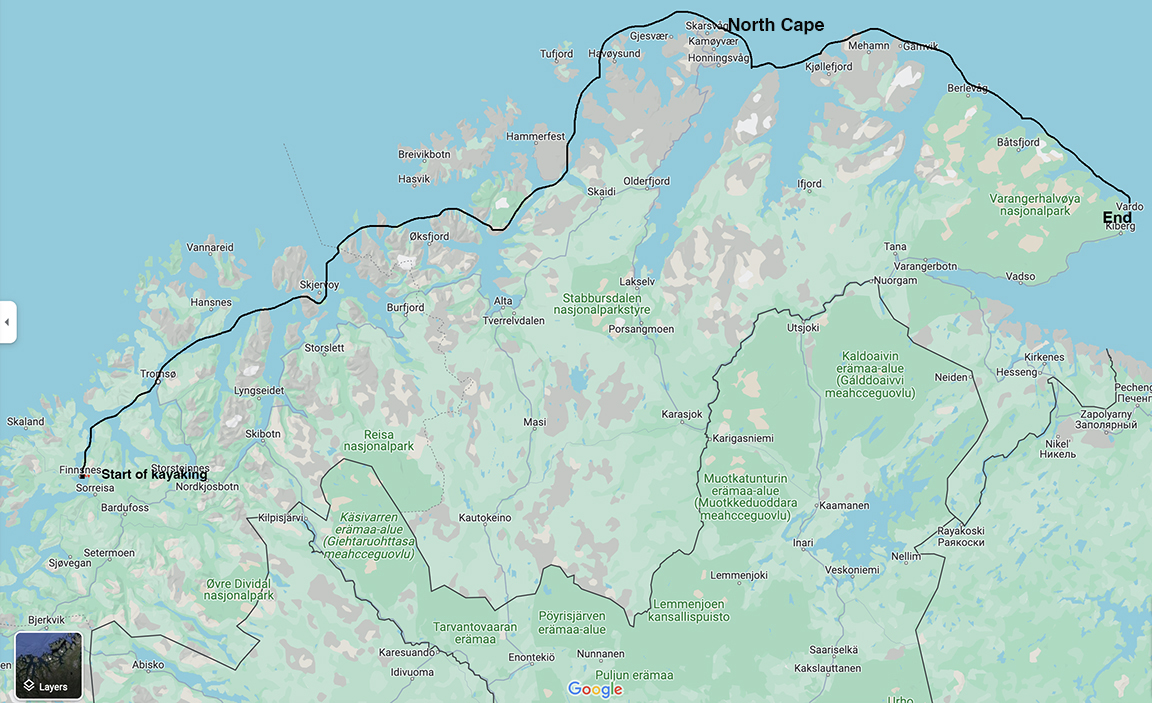
An experienced adventure cyclist, Barone had cycled 1,600km to Sweden earlier in the winter. He then hauled a sled over 600km to Finnsnes, where he began to kayak through the fiords and islands of the north coast.
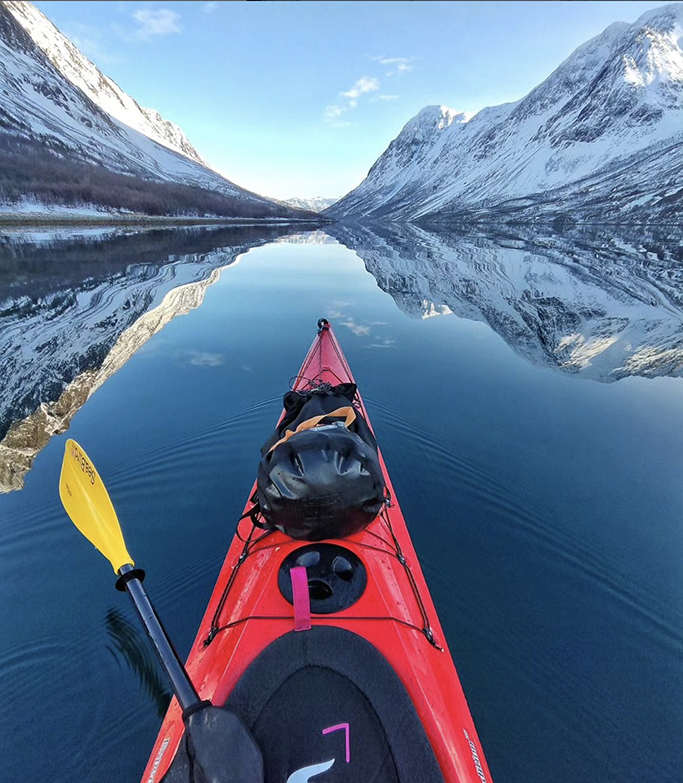
When we’re not outdoors, we get our adventure fix by exploring social media and the web. Here are some of the best adventure links we’ve discovered this week.
Kayak Photography: Most people want to capture their adventures on camera, but it is particularly hard for sea kayakers. The first challenge is that cameras don't like salt or water. The second challenge is finding a good perspective.
Seasoned sea kayaker Will Copestake shares his photography tips, including moisture management and how to take the classic bow shot.
Lorraine McCall Plans First Continuous Grahams Round: Lorraine McCall completed the Scottish Munros 19 years ago. Ten years ago, she linked the Corbetts. Now she wants to be the first person to complete a continuous Grahams round.
McCall plans to hike and cycle between the 231 Scottish hills, all between 600 and 762 meters, and use ferries to reach the various islands. She begins in mid-April on her 59th birthday.
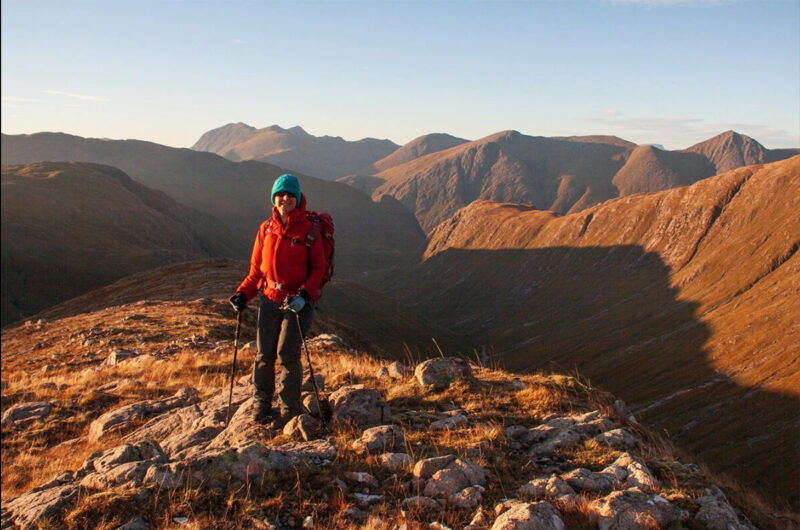
Strava for dogs? Really?
Strava for Dogs is a Real Thing: Many people believe their pooch is the best adventure dog out there. Now they can prove it. Strava has teamed up with Fi, a collar brand that uses a satellite position system like a smartwatch.
The collar will map the dog's route, count steps, and give activity statistics. Now you can link your dog's Fi account with your Strava account so your followers can see your joint adventures.
Historical Badass Natalia Molchanova: Natalia Molchanova is regarded by many as the greatest freediver ever. In 2013, she broke the women’s record for static apnea. She held her breath for nine minutes and two seconds in a pool.
Originally a competitive swimmer, Molchanova discovered free diving in her forties. Over the next decade, she set 41 freediving records. In 2015, she slipped into the water off the coast of Spain and disappeared.
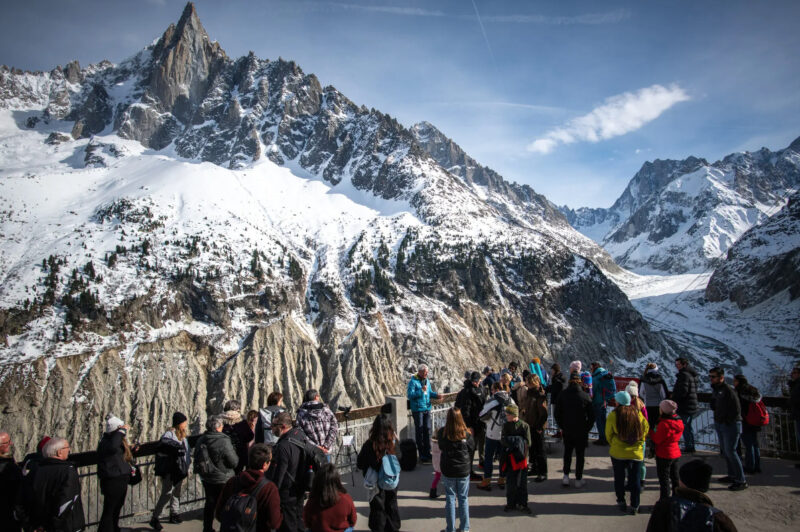
It Just Got Easier to Visit a Vanishing Glacier: In February a new gondola opened in Chamonix, France. The gondola takes people to the Mer de Glace glacier. The glacier is a stark reminder of the impact of climate change and some people are questioning if the new ride is a good idea. Is this an example of last-chance tourism?
Early marathon swimmer featured in new film
Vindication Swim: In 1927, Mercedes Gleitze was the first British woman to swim the English Channel. At the time, many people thought it impossible for a woman. A few years later, she became the first person to swim across the Gibraltar Strait. A new film celebrates her achievements.
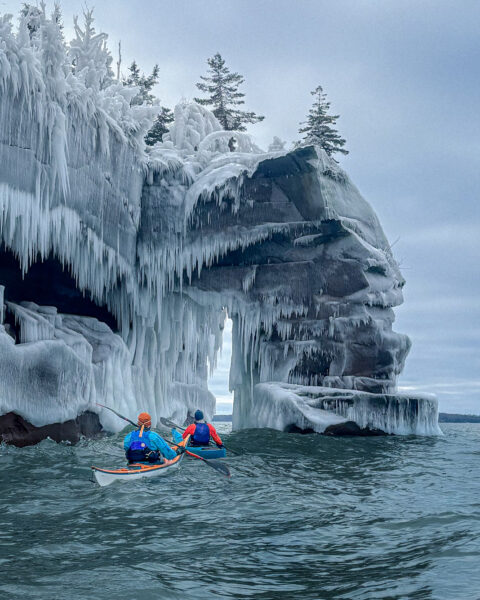
Outdoorsy Girls Are Mean Girls: Maddy Marquardt has been a sea kayaking guide for five years. She was told she would have to work extra hard to make it in a male-dominated field and to be respected by clients. It has been a few years since a man questioned her place in the outdoors. The ones making snide comments are now women.
Marquardt has fallen victim to it herself, laughing at comments like "she’s only doing it for the photo." Here she questions why the few women in the outdoor industry turn on each other.
A 386Km Hike Through Scotland: The Cape Wrath Trail is an unmarked 386km route that runs from Fort William to Cape Wrath in Scotland. It is one of the most challenging hikes in the United Kingdom.
The route takes you through every landscape Scotland has to offer, from boggy moorland to isolated glens, beaches, lochs, and mountains. Richard Gaston writes about the 17 days he spent on the trail.
At the darkest time of year, shortly after the winter solstice, 26-year-old Lorenzo Barone of Italy reached the Danish border from Bologna. He had 3,200km cold kilometers ahead of him.

Barone first cycled 1,600km -- "just the approach," he insisted -- to the small town of Hemavan, in Sweden. Here, he swapped his wheels for skis and a sled and manhauled north just over 600km to Finnsnes, on the Norwegian coast. It's been a cold winter in northern Scandinavia, and temperatures en route plummeted to -35˚C.

Today, he began the third leg of his adventure. He plans to kayak 1,000km from Finnsnes to Vardo in northern Norway. Although he paddled 26km today, rare sea ice from the bitter winter added a further obstacle. He will rest and sort out his gear for a few days before taking to the water again.

Barone is an experienced adventure cyclist and says he has cycled 100,000km through various parts of the world. But kayaking is new to him.
At least, the days are noticeably lengthening, he says.

When we’re not outdoors, we get our adventure fix by exploring social media and the web. Here are some of the best adventure links we’ve discovered this week.
Risking Their Lives to Ski While They Can: There have always been groups of winter sports enthusiasts who have pushed boundaries, but they tended to be highly experienced. Now a worrying trend has developed, beginners are following in their footsteps and are not equipped to deal with the dangers.
The NPS Wants to Ban Wilderness Climbing: The National Park Service and the U.S. Forest Service want to ban fixed anchors in Wilderness areas. Last week the period for public comments on the issue came to an end. Now people are waiting to hear the outcome.
Steven Potter outlines the major implications of the proposals.
From biking to climbing
Interview with Stefano Ghisolfi: Italian climber Stefano Ghisolfi started out competing in mountain biking but after going climbing with a friend, he fell in love. After a few years of indoor climbing, he moved to rock and progressed at a rapid pace. He talks to UK Climbing about his history with the sport and what he hopes to accomplish this year.
Kitesurfing in 50-Knot Winds: Amongst surfers, Maui is known for its high winds. If you want to tackle the waves you need to prepare to make the best of unfavorable conditions.
Kai Lenny recently went out to Ho’okipa in 10 to 50-knot winds with his kite. "It made kitesurfing challenging but really rewarding when I could actually link a turn," he said.
Below you can watch a video of him taking on the gusty conditions.
The Dark History Behind Madeira’s Famous Levadas: Madeira has several epic hikes. Many of these run alongside the island's man-made irrigation tunnels, called levadas. Though the island is just 55km long and 22km wide, the network of levadas stretches 3,100km. They are deeply entwined with the history and culture of the island. Soon they may become a UNESCO site.
Hiker Adam Turner walked sections of the PR 9 and reflected on the growing popularity of the routes and the darker side of their history.
Tiya Miles Uncovers the Hidden History of Women in the Outdoors: Tiya Miles is uncovering the lives of trailblazing women. Many of their stories are intrinsically linked to the outdoors, but this aspect of their lives has often been overlooked.
An American history professor, Miles vividly remembers the day she found out that a park ranger had called Harriet Tubman the "ultimate outdoorswoman." Tubman had used her vast knowledge of the outdoors to escape slave hunters and then to help others.
Miles has made it her mission to reexamine the role of the outdoors in the lives of 19th-century women.

Porcupine River
Ray Goodwin’s Porcupine River: Ray Goodwin and Pail Kirtley had planned to canoe the Missinaibi and Porcupine years ago. Covid, some osteoarthritis, and a heart problem later, they finally managed it.
They flew to Points North to start their 12-day trip on the Porcupine River in Saskatchewan. Goodwin writes about the 10-person, five-canoe group and their experiences.
Cathedrals of Wilderness: With all of the furor over the proposal to ban wilderness climbing, the American Alpine Club wanted to look into its history. After going back through almost 100 years of records and documentation, they provide details of three first ascents that "demonstrate the roots of wilderness climbing."
They demonstrate that historical wilderness climbing used fixed gear. It was always used reasonably and minimally to ensure safety and allow meaningful experiences.
When we’re not outdoors, we get our adventure fix by exploring social media and the web. Here are some of the best adventure links we’ve discovered this week
Antarctic Tourism: Should We Just Say No?: This tourist season (October 2023 to March 2024) the number of visitors to Antarctica will hit 100,000 for the first time. As numbers increase, tourists want to do more than see the penguins, seals, and whales. They want kayaking, submersibles, and helicopters.
Tourists increase biosecurity risk and the ships and planes bringing them are releasing carbon dioxide into the region like never before. Has tourism on the frozen continent now become unethical? Should tourism be allowed at all?
Four-Year-Old Hikes to Everest Base Camp: Zara Sifra is now the youngest person to hike to Everest Base Camp. The four-year-old made the journey with her father and seven-year-old brother. Her dad commented that she had no problem with the long walk or acclimatization and outpaced hundreds of other trekkers.

A blisteringly fast Pennine Way run
Jack Scott Wins 2024 Montane Spine Race: Jack Scott has won the 2024 Montane Spine Race and beaten the speed record. The 431km ultra-marathon is a non-stop race along the Pennine Way in the middle of winter.
This year, nine previous winners competed. But it was Scott who came out on top. He broke the speed record by over 10 hours and crossed the finish line in 72 hours, 55 minutes, and five seconds.
Nick Offerman Paddles Badass Canoe Down L.A. River: Nick Offerman is known for many things: he's an actor, comedian, writer, and producer. He is also a woodworker and Huckleberry is his handmade cedar-strip canoe.
Offerman writes about paddling his canoe down the concrete-clad L.A. river. After canoeing down a "fun expanse of weird urban river" his only wish is that he had waited until after the trip to apply three new coats of varnish.

Hikers Cited After Trespassing in Hawaii Volcanoes National Park: Authorities have cited two hikers for attempting to climb Mauna Loa without a permit. Permits were suspended in the national park and rangers had closed the summit, yet the pair decided to try and climb the mountain anyway.
Severely underestimating the climb, the pair ran into trouble when the temperature dropped. They were running out of food and water, and their phones were about to die. They eventually rang 911. A search and rescue team found them on the mountain.
First-Hand Account of Palisades Tahoe Avalanche: On Jan. 10, an avalanche struck Palisades Tahoe when the mountainside below the KT22 chairlift started to fall away. Jeremy Jones was on the mountain with his son. In a second, it turned from a joyful father-son day out into a nightmare.

Using UV light to transform diving
I'm Colour Blind, Night Diving Was Nothing Like I Imagined: James Draven is color blind and cannot see reds and greens. So why go on a dive to look at the colors of a coral reef? The solution was a night dive using an ultraviolet torch. The UV lights transform the reef into "a fluorescent fun house."
Second Ascent of Black Spout Wall: Greg Boswell and Jeff Mercier have made a second winter ascent of the Black Spout Wall (IX 9) in Lochnagar, Scotland.
The pair originally planned to climb in Norway but canceled the trip because of poor conditions. Instead, they went to Scotland with Black Spout Wall as their main target. Though graded at IX 9, Boswell thinks it is more akin to an IX 10.
Four kayakers who set a landmark record in a remote corner of Canada have been charged with illegally visiting the area, which is protected as a migratory bird sanctuary.
West Hansen, Jeff Wueste, Eileen Visser, and Mark Agnew completed the first-ever single-season kayak journey through the Northwest Passage this autumn. We ranked it our #2 expedition of 2023.
ExplorersWeb first discovered the potential permit problem during an in-person conversation with a park warden on Baffin Island last summer. It turns out that the group never resolved this issue and so did not have permission to camp on Bylot Island. Each member has since been charged with 45 violations of the Canadian National Parks Act and the Migratory Birds Convention Act. Sirmilk National Park encompasses all of Bylot Island and some of western Baffin Island. Bylot is also a migratory bird sanctuary.
The quartet embarked on their journey in early July, and were immediately blocked by sea ice along Bylot Island's south coast. They waited in a small hunting cabin on the southeast corner of the island for two weeks for the ice to break up. Then they paddled along the north coast for several days.
By allegedly camping on Bylot Island without permission, the Arctic Cowboys ran afoul of several regulations designed to protect migratory birds. Camping on the island without a permit is a key violation, prompting investigations by Parks Canada and Environment and Climate Change Canada.
The sanctuary protects nesting sites of thick-billed murres, black-legged kittiwakes, and greater snow geese. The Canadian Government website states: "For all non-Nunavut Inuit, a permit may be required to access or conduct activities in the MBS, particularly if firearms will be carried and/or migratory birds may be disturbed."

A map of the Bylot Island Migratory Bird Sanctuary. The Arctic Cowboys were holed up for two weeks on the southeast corner of the Island, then paddled along the north coast for several days. The part of Baffin Island immediately west of Bylot Island is also part of Sirmilik National Park. Image: Canada.Ca
Numerous charges
Although not public knowledge at the time, the Arctic Cowboys' journey took an unexpected turn when, over a month into their expedition, they were arrested and interviewed for these contraventions in Cambridge Bay on Aug. 25, 2023. Parks Canada Law Enforcement, assisted by the Royal Canadian Mounted Police, carried out the arrest. The kayakers were subsequently released, allowing them to resume their journey.
The alleged offenses are being examined under the Migratory Birds Convention Act and the Canada National Parks Act, specifically within the Bylot Island Migratory Bird Sanctuary and Sirmilik National Park in Nunavut. The charges against the team include a range of offenses, such as using public lands in a park against the Canada National Parks Act, possessing a firearm in a park contrary to National Parks Wildlife Regulations, and disturbing wildlife in a park, among others.
Legal action against West Hansen and Jeff Wueste of Texas, Eileen Visser of New York, and Mark Agnew of the UK is now underway in Nunavut courts. The outcome of these proceedings remains uncertain, although the National Parks Acts website lists hefty fines for contraventions.
The Arctic Cowboys' journey was one of the most impressive kayak expeditions in recent years. However, the disregard for local laws has overshadowed their success. ExplorersWeb can't condone this any more than we could laud a difficult climb done on a forbidden mountain in Bhutan. The natural world, even in the remote Arctic, isn't just a stage for adventurers to pursue their goals. Though regulations and permits may seem bureaucratic, they play a crucial role in safeguarding the land and wildlife of the Arctic.
We have reached out to leader West Hansen for comment, but have not received a response.
The hearing will take place in early March.
After aborting their first attempt at the Northwest Passage in 2022 after just 300km, veteran Texas kayak racers West Hansen, 61, and Jeff Wueste, 63, made some changes: double kayaks instead of singles and two new members -- endurance paddler Eileen Visser of New York and ultramarathoner Mark Agnew of the UK.
The foursome also showed up a month earlier, in early July. A snowmobile from Pond Inlet conveyed them to their starting point at the eastern end of Bylot Island, just north of Baffin Island.

The first two weeks of this 2,500km expedition did not look promising.
That early in the season, the sea ice was still solid along Bylot's south coast, the route they had paddled the previous year. They were kayakers, not arctic travelers, and had little desire to drag their kayaks over the ice to open water. They had not brought either crampons or ski poles to facilitate this sort of travel.
So the Arctic Cowboys, as they styled themselves, sat for nearly two weeks in a little hunting cabin on Bylot Island. If they could only reach the north end of the island, they could begin. There, the strong currents of Lancaster Sound had already cleared away the ice. Once, they made an abortive stab at it, but the swiftly moving floes stymied them. Retreating with difficulty back to the cabin, they waited some more.

Bureaucratic hurdle
Finally, the ice had cleared enough for them to escape. Meanwhile, they and their home team wrestled with local bureaucracy. Part of Bylot Island along that northern route is a migratory bird sanctuary. You can't land there without a permit, which they did not have.
When they finally began to paddle, they took their satellite tracker briefly offline. Perhaps they wanted to avoid leaving evidence that they were landing to camp, contrary to regulations.
"We were not impressed," a Parks Canada warden in Pond Inlet told me when I visited that small arctic town in mid-August.
But after a few surprisingly fast days, the paddlers had moved beyond the forbidden area, and their tracker was back online again.
Thus ended the very messy beginning. For the next two-and-a-half months, Hansen, Wueste, Mark Agnew, and Eileen Visser did almost everything right.
The warden from Pond Inlet did not think they would succeed. I was less sure. It's true that they did not seem prepared to deal with sea ice, apart from waiting it out. But the more that climate change turned the Northwest Passage into a colder version of the Gulf of Mexico, Hansen and Wueste's backyard, the better the chance they had.

Some years still impassible
Some summers, sea ice still blocks the Northwest Passage. In 2018, for example, no vessel made it through. Even large ships had to turn back. Other years, the Passage is wide open.
This was one of those summers. I did the Northwest Passage in late August the easy way, as a resource person on a cruise ship. I've done the Passage in that capacity half a dozen times. This year for the first time, we saw no sea ice whatsoever.
Once the kayakers had escaped the ice of eastern Bylot, they showed how they differed from other parties who had tried the Passage before them. They were very strong paddlers and routinely covered 60 kilometers or more in a day. On their first four days on the water, they did 64km, 56km, 77km, and 71km. During a more modest stretch about two-thirds through the journey, they made 65km, 67km, 38km, 57km, and 48km. The few slightly slower days signified headwinds.
I asked veteran expedition paddler Jon Turk, now 78, about such impressive mileage.
"Modern techniques and fitness are way above what we brought to the sport," reflected Turk. "Also, our boats didn't have the hull speed. Not long ago, I paddled the Arctic in a modern boat. I used to paddle at 2.5 knots. Now I was going 3.5 knots, and I was out of shape. I wondered if my GPS was wrong."
Turk has often dragged his kayak over sea ice, most notably in 2011, when he and Erik Boomer hauled and paddled their boats completely around Ellesmere Island. Turk always used near-indestructible rotomolded kayaks. High-performance boats today are lighter and faster but don't take abrasion well, he explained.
Still, they could have dragged their boats on small custom-made sleds, as I have done with my own fragile kayak on occasion. When not in use, it fits nicely over the aft deck.
Did Turk consider his amphibious arctic journeys, two-thirds hauling a kayak, one-third paddling, an actual kayak expedition?
Turk laughed. "People can call it whatever they want," he said. "I don't give a shit."

Satellite weather reports
Regular satellite weather reports from the Arctic Cowboys' home team allowed them to rest when conditions were likely to turn gnarly. They didn't seem to mind regular two or three-day layovers as the all-too-brief arctic summer yielded to fall. Whenever they were out on the water, their consistent big days allowed them to make up time.
Their biggest day came when they had to cross Prince Regent Inlet from Baffin Island to Somerset Island. Ninety kilometers and some 15 or 16 or 17 hours later, the tired crew beached safely on Somerset. They had other long crossings ahead, but nothing like this one.
A few days later, they transited through narrow Bellot Strait, between the Canadian mainland and Somerset Island. This two-kilometer-wide, 25km-long waterway has such swift currents that you can only paddle it at slack tide or with the tide in your favor. It also marked their passage from the eastern to the western Arctic.

An open polar sea
No sea ice lay ahead of them. In fact, they even chose to paddle down the western side of King William Island. Back in 1846, Sir John Franklin made that same choice, rather than take the safer eastern side. Franklin's ships almost immediately became stuck in the ice. He and all 125 remaining men ultimately perished.
But the kayakers had no problems around King William Island. Maintaining their swift pace, they soon reached the town of Cambridge Bay on neighboring Victoria Island. Here, they rested for a week, picked up fresh supplies, and waited for new drysuits to arrive.
Just one big question remained. As the fall equinox approached and the weather became much colder and more unstable, how would these southern kayakers, inexperienced in the Arctic, handle it? They would have to paddle into October when nights were long, the temperatures remained below freezing, and the snow started to accumulate.

Other parties
This foursome was not the only self-propelled party attempting the Northwest Passage this year. A pair of kayakers in single rowing hulls had started from the west. One became injured and had to drop out, but Matty Clarke persisted alone until eventually, equipment problems forced him to call it quits on King William Island. He ended his attempt at the island's lone town of Gjoa Haven -- named for the Gjoa, the ship Amundsen used for the first transit of the Northwest Passage. It took Amundsen three years.
Another party to attempt the Passage in 2023 was a group of British rowers. Like the Cowboys, they too started at Pond Inlet, but much later in the season. They rowed in shifts, some at the oars, some sleeping in the boat's cabin. They too were making good time. Just west of Cambridge Bay, they were not far behind the kayakers when the cold and storms sapped their motivation. They called it off, seemingly for no particular reason except that they were now uncomfortable with the conditions.

Meanwhile, the kayakers, in much smaller and more delicate craft, continued their intelligent advance. They relied heavily on weather reports from their home team, sat out bad weather, and paddled hard when conditions allowed. The arithmetic made sense: If you can average 60 kilometers a day, you only need to be on the water for 42 days to cover the 2,500km of the Northwest Passage.
Winter closes in
Nevertheless, the last section, from Cambridge Bay to the end of the Northwest Passage, tried their patience. They were tired, and their daily paddling window shrank as the nights lengthened. Early in the trip, you could wait for calm water and launch at 1 am under the midnight sun. Not now.
Their number of tentbound days increased. Once they had to wait five days to paddle three days. Snow began to pile up around their tent. On another occasion, they had to seal launch into five-meter waves. Even at this late stage, not all of them were sure they would make it.
Finally, on October 8, they rounded Cape Bathurst, which marks the end of the Northwest Passage. From here, Amundsen Gulf yawns widely into the Beaufort Sea. No further islands loom to the north of them, and only the Canadian mainland to the south.
They originally planned to finish at Tuktoyaktuk, the nearest town from which their support team could drive them home. Instead, harried now by constant storms, they decided to charter a Twin Otter aircraft to fly them out.

Past attempts
These days, lots of cruise ships and even private sailboats do the Northwest Passage. In spring 2011, Sarah and Eric McNair-Landry kite-skied from Tuktoyaktuk to Pond Inlet, making good use of the prevailing westerlies. A couple of dogsledders, including the great Naomi Uemura, dogsledded the distance. (Uemura actually went from Greenland to Alaska over two seasons.)
In 2013-15, French rower Charles Hedrich rowed from Alaska to Pond Inlet over three summers. But this year marked the first time a party had paddled the entire Passage in a single season. Discounting the McNair-Landrys' wind-assisted journey, it was the first time anyone had done it under their own steam in one year.
Not everyone agrees, of course, that this was the entire Northwest Passage. One reader of our coverage of this expedition, for example, pointed out that by some definitions, the Northwest Passage runs from Davis Strait, off southern Baffin Island, to the Bering Strait.
That seems a little harsh unless you have a sailboat, because no one is going to ski, kite, row, dogsled, or paddle that much greater distance in a single season. The Arctic Cowboys did the obvious Northwest Passage, the familiar Northwest Passage, and it was a singular, hard journey. Faced with alternative definitions of the legendary waterway, the wisest thing for them is probably just to shrug and say, "I don't give a shit."
Editor's note: This story assumed that they resolved their issue with permits for Bylot Island, mentioned above. In the end, they did not, and have been charged with multiple violations. More details in this followup story.
In the world of ocean adventure, kayaking is not the norm, especially for long-distance crossings. With only a handful of long-distance kayakers, advice and expertise are hard to come by. Richard Kohler, 53, did not see this as an issue when he embarked on what would become one of the longest ocean crossings by kayak.

The second-longest solo ocean kayak journey
Kohler paddled 6,403km solo and unsupported from Cape Town, South Africa across the Southern Atlantic Ocean to Salvador, Brazil. It is the second-longest recorded solo ocean kayak journey. The late Aleksander Doba completed the longest journey when he paddled 6,558km from Portugal to Florida in 2014.
Kohler may also be the first person to cover this particular route in a kayak. Amyr Klink rowed a similar route in 1982; Klink also crossed the Southern Atlantic Ocean to Brazil but started his journey in Namibia rather than South Africa.
Kohler has decades of experience as a sailor and has completed 11 ocean crossings as a professional yachtsman. But he had always dreamed of completing a solo crossing. After kayaking the South African coastline alone in 2013, he came up with the idea of solo ocean crossing by kayak.

Success on his second attempt
He first attempted the crossing in December 2021 but abandoned his attempt after 16 days. The wiring to his main solar panels corroded, and his spare set of panels didn't work. Unable to use his communication devices, AIS system, or desalinator, he had to make landfall in Namibia.
In a twist of fate, the unfortunate ending of his journey allowed him to do something he would otherwise have missed. He was able to make it back to South Africa to say goodbye to his father, who had fallen ill.
Over the next year, Kohler made adjustments to his boat and equipment. His kayak is very unusual. In fact, it barely resembles one at all. Named Osiyeza, it was built for this crossing. It is eight meters long, one meter wide, and includes an enclosed sleeping area.
Paddling purists might question whether this should be classed as a kayak at all. They might point to Ed Gillet's crossing of the Pacific as a true ocean kayaking expedition, but Kohler is not phased by the debate. In a radio interview before setting out he explained his view: "The term kayak is because I am using a double-bladed paddle to propel myself."

Gale-force winds and seasickness
Regardless of how high-tech his kayak is, you can't question the skill needed to make the crossing.
The 63-day, seven-hour journey was extremely challenging. For the first 48 hours, Kohler’s seasickness was so bad that he couldn't eat. Over the next three weeks, he endured gale-force winds and storms that forced him onto his sea anchor several times. Eventually, he was able to escape the horrific conditions and position himself with the trade winds behind him.

He faced storms with 40-knot winds and five-meter swells. He had no choice but to sit these out, listening to the waves smashing into his boat.
"The problem with being on a kayak is you are so slow you cannot escape the weather. So you are sitting there for a week just watching this thing approach, and that can do some funny things to your mind," he said.
His daily routine
Over two months at sea, Kohler settled into a routine. He would paddle for two to three hours before dawn and then stop for a coffee, some breakfast, and a chat with his shore team. Then he would paddle three hours on, one hour off for the rest of the day.
At midday, he usually stopped for two hours to get out of the sun, rest, send a message to his wife, update his blog, and eat a bit more food. He tried to paddle for 10 to 15 hours each day.
For Kohler, the mental battle proved harder than the physical. Two months is a long time to spend alone. It hit particularly hard over Christmas. His wife had packed four small presents for him to open, and he spoke to her and his mother. But once the calls were over, he began to feel a little low.
Kohler had packed some letters from friends, sealed for him to open when he needed a little encouragement. He picked out two to open. The first was from his father, written before he died for Kohl’s first attempt.
"Let me just say that today goes down in my personal history book as my lowest emotional state. I can’t even begin to describe how emotionally mixed up I am right now," Kohler wrote on his blog.

Swam ashore
Landing his kayak in Salvador proved particularly hard. The bay where the yacht club is located has strong tidal currents, so he had a very small window to land.
"The current here was an absolute beast," he wrote. "Osiyeza was flying towards Salvador. Then the wind died, and as a parting gift, it started to blow offshore. I just chuckled to myself."
Kohler paddled hard to make the bay. As he turned a corner, he was met by a flotilla of kayakers, SUPs, yachts, and the Navy. They had come out to paddle alongside him during the last kilometer of his journey.
One final problem presented itself. There was nowhere for him to dock at the yacht club. For the expedition to count as solo and unsupported, he had to touch land without help. Kohler tied Osiyeza to a mooring buoy, jumped into the water, and swam to shore.

"Paddling a kayak across the ocean has been a ten-year dream, with the last five years of planning and execution," Kohler said after landing in Brazil. "I am very relieved that I had what it takes for an adventure like this, but also very grateful that it has come to an end. The experience is one that I will cherish for the rest of my days."
Dave Alley doesn't consider himself a kayaker. Yet the 47-year-old Australian has just set an impressive new fastest known time (FKT) on Australia's longest waterway, the Murray River.
Alley paddled the 2,287km from Bringenbrong Bridge in New South Wales to Wellington in South Australia in 15 days, 11 hours, and 33 minutes (including a 12-hour time penalty), breaking a record that's stood since 1993.
Alley is an endurance athlete and coach with an impressive list of accomplishments. But notably missing from that list is much — if any — experience in a kayak.
18 months of prep
"It was an 18-month turnaround from [the] initial concept to hitting the water on day one," Alley told ExplorersWeb.
"I was like a sponge, soaking up as much learning as I could in the time I had available. But I was essentially self-taught, with no background in the sport."
Kayaking the Murray end-to-end gives a flavor reminiscent of America's Mississippi River — sometimes wild, sometimes industrialized, with locks to navigate, submerged obstacles to avoid, and slowing currents as the waterway reaches the coast. And like Old Man River, the Mighty Murray has suffered from low water flows in recent years.

Alley said that as he approaches his fifties, he's increasingly aware that he can't wait around for perfect adventuring conditions. The clock is always ticking. And because the Murray's headwaters are a three-day drive from his house, he also couldn't wait for ideal weather.
"The weather gods were against me from day one. On arrival, we quickly established that the river flow was down by a staggering 300% at times from the previous record holder back in 1993. I also had headwinds from day 1, battled storms, and temperature ranges from -3˚C to 41˚C."
Sleep deprivation, capsizing, and more
Alley racked up his impressive time through a combination of top physical conditioning, mental fortitude, and sleep deprivation — a familiar recipe to followers of endurance endeavors. He paddled up to 23 hours a day and slept on the riverbank. Occasionally, he grabbed a nap in the back of a support vehicle.
"I was hallucinating," the athlete said. "I also fell asleep while paddling!"
He had half a dozen capsizes throughout the trip caused by falling asleep or hitting submerged logs.
In addition to the unfortunate weather and low water, Alley suffered a mental blow when he lost his phone during a capsize on day one, We Are Explorers reported. With none of the podcasts and audiobooks he'd downloaded available to keep him sharp, he was faced with the daunting prospect of endless hours of silent paddling.
A light and fast boat
A crew of seven followed behind while Alley paddled his 6m Fusion LR6 TK1 kayak, a boat that had been customized with bulkheads fore and aft before setting out. Alley happily accepted the extra weight of the bulkheads for the additional strength they lent his boat. Even with the customizations, the whole thing came out to only 12kg. The support boat carried his food, fuel, and other supplies.
According to Alley, "Kayaking the Murray River is done by several adventurers each year. Most do it for the challenge and experience of stopping off along the way and soaking up the scenery and wildlife. However, there are always those [who] like to push the boundaries of what’s possible."
Ultimately, the paddler broke a 30-year-old record by 19 hours and 25 minutes despite considerably more challenging river conditions, a fact he says gives him both "satisfaction and pride."
Not bad for someone who was a kayaking novice a mere year and a half ago.
According to the U.S. Geological Survey, Africa's Nile River is 6,650 kilometers long and South America's Amazon is 6,400 kilometers. However, the question of a river's length is not straightforward. Cartography, geography, and personal opinion all muddy the waters.
Conventional knowledge holds that the Nile, which starts in central and eastern Africa and ends on Egypt's Mediterranean coast, is the world's longest river. But some dispute this, because there is no scientific consensus about where the rivers start.
Broadly speaking, the Amazon starts in the Peruvian Andes and ends on Brazil's Atlantic coast. The conventional source of the Amazon is the Apurimac River in southern Peru. Satellite images from 2008 allegedly confirmed the claims of a Royal Geographic Society expedition in 1996 that extended the Amazon's length by adding the length of a feeder stream called Apacheta Creek to the Apurimac. This lengthened the Amazon by an extra 593km and made it 6,993km long -- longer than the Nile.

Yuri Sanada, a Brazilian filmmaker, wants to settle the Amazon vs. Nile debate once and for all. In April 2024, he will mount an expedition from Apacheta Creek to the mouth of the river, highlighting the Amazon's superior length to the Nile. Though many have traversed the Amazon River before, his expedition will be the first to do so in solar-powered boats.

An imperfect science
The source of the Amazon remains contentious. James Contos, a kayaker and explorer, published an article in 2014 claiming an alternative source on the Mantaro River. Some 640km north of Apacheta Creek, this adds about 80km to the Amazon's length instead of the 593km if the Apacheta Creek source is used as the starting point. The Contos source would make the Amazon shorter than the Nile.
This raises the question as to whether it is the perennial or the ephemeral source that counts. A perennial source provides a continuous flow of water from a river's mouth, while an ephemeral source does not flow year-round. Crucially, researchers have pointed out that the Contos source is ephemeral, whereas the Apacheta Creek source provides continuous flow. 
Sanada will use both proposed sources of the Amazon as starting points. Applying each of these to the Amazon makes a difference of 6,510km (Contos' ephemeral Mantaro source) to 6,993km (the perennial Apacheta Creek source). The unsettled debate revolves around whether a perennial or ephemeral source counts as the true source.
West Hansen, an American kayaker who has paddled the length of the Amazon, argues that a universal set of criteria is needed for defining rivers, but these are not available. He further points out that requiring a perennial source would change the lengths of almost every major river in the world. In other cases, dams interfere with flow. Does that affect the length of these rivers?
The source of the Nile faces similar controversy. The river's main two branches are the White and Blue Niles. The Blue Nile originates in Ethiopia's Lake Tana and is a perennial source that provides 80% of the Nile's water.
The White Nile, also perennial, is longer but doesn't contribute such a large proportion of the river's volume. In that case, should it count as the true source by which one measures an entire river's length?
Any comparison of rivers needs to be consistent over what starting point it uses. Otherwise, it's impossible to compare expedition accomplishments, just as it's impossible to compare various crossings of Antarctica, where some include the ice shelves and some don't. Therefore, whether the Amazon is longer than the Nile is not simply about distance, but requires claimants to be specific about the criteria they are using to make comparisons.
The creek of the matter
Either way, the burden of proof is on those who identify the Apacheta Creek as the source. This would mean the start of the Amazon is a small glacial creek high in the Andes. If it is a justifiable claim, then it seems likely the Amazon is indeed longer than the Nile.
The science behind Sanada's claim is based on the Royal Geographic Society expedition from 1996, satellite imagery from 2008, and a study published in 2011 in the Hydrological Sciences Journal, supporting the earlier study from 1996. However, the conclusions of this research have met with considerable skepticism in the scientific and geographic communities, as reported by The Washington Post.
A persistent problem in all of these claims is the difficulty of obtaining specific, accurate, and consistent measurements of length. In the Amazon, extreme weather in the Andes and the Amazon rainforest erodes river banks, bends, and shorelines. Consequently, there are large variances in key measurement features. Over thousands of kilometers, that can make consistent measurements almost impossible. So the true length of the Amazon, regardless of its source, shifts all the time.

Nevertheless...
Next spring, Sanada's team will spend seven months mapping and measuring the river from both the Apacheta Creek and Contos’ source. The point, says Sanada, is that the waters from the Andes are the same that flow into the Atlantic. His journey aims to highlight that and point to the evidence that it is longer than the Nile.
Such a journey implies significant danger. Apart from the sometimes hostile natural environment, the Amazon is a significant smuggling route for drug traffickers, and river pirates lurk in parts of the river. British canoeist Emma Kelty was killed during a solo journey down the Amazon in 2018. The team will need to work with local authorities to secure armed local escorts through such dangerous areas.
The expedition will involve hiking, donkeys, rafts, and hybrid electric boats. Sanada says that scientists will join the expedition at different stages.

The final word
“More than 1,500 people have rowed or paddled across an ocean," Sanada told The Washington Post. "But to kayak down the entire Amazon? That has been done fewer than 10 times, and all of them were for adventure’s sake. To document the entire river, its geography, and biodiversity, this has never been done.”
It may not be a "historic feat," as Red Bull tries to sell it, but it's definitely cool to watch extreme kayaker Aniol Serrasolses run a glacial flume, then catapult over a 20m ice wall into the ocean. The action took place last summer on Svalbard, the High Arctic archipelago north of Norway.

The Catalan kayaker and his team trekked 11 kilometers across the Austfonna ice cap to access the meltwater stream. After launching, Serrasolses briefly went through an ice tunnel before it disgorged the kayaker off a 20m waterfall and into the frigid ocean.
Check out the video here.

The Second World War had begun, and P.G. Downes was none the wiser. He was too enraptured by the task at hand -- exploring Canada’s North. This American schoolteacher and writer left it all behind to delve into the Great Barren Lands and its indigenous people.
As a name, Prentice G. Downes sounds a bit stuffy and old-fashioned, but the man was anything but. His portraits make him look like a cross between a rakish character and a matinee actor. Known as Spike to his friends, he was born in Connecticut in the early 1900s. From an early age, he showed high intelligence and an incredible awareness about how the world and people worked.
He studied psychology at Harvard but accepted a teaching position at a high school afterward. He taught languages (English, French, and Latin) but was adept at many subjects, including history and geography. His own hobbies included studying rocks, learning about new cultures, drawing maps, and naturally, exploring the outdoors.
He had a curious personality, was a tad dramatic, and carefree. Sometimes, delays during his wilderness trips made him late for his teaching commitments. However, his enthusiasm for imparting knowledge delighted his colleagues, who noted that he had "an absence of egotism."

Lakes, rocks, rivers, and tundra
In the end, however, the classroom could not contain his restless body and curious mind. He decided to turn his love of languages and hobbies into an actual life’s work. He yearned to explore more of Canada’s northern regions, especially the Barren Grounds, an arctic region west of Hudson Bay. It features an abundance of lakes, many long, technical rivers, a quadrillion rocks, and tundra as far as the eye can see.
Downes compiled his observations into four diaries, which included notes, illustrations, sketches, and maps. He wrote about anything he saw, from his mental state to vivid details of grueling portages. He even pressed dead mosquitoes into his journal.
His expeditions corrected mistakes made by earlier mapmakers and incorrect assumptions about cultures made by anthropologists. He had an affinity for studying local traditions, folklore, and supernatural legends of indigenous groups like the Cree and the Dene. He greatly admired them and tried to put himself in their shoes in order to travel their land successfully.

The man who talks about dreams
Downes was so fascinated by their views on dreams that they nicknamed him, “the man who talks about dreams.” He wrote extensively on Cree dream interpretation, but these writings were not published. He also attempted to create a Cree dictionary. However, his greatest achievement was a compelling narrative called Sleeping Island, published in 1943 and today considered a minor classic.
He was inspired by the writings of Napoleon-Alexandre Comeau, a 19th-century Canadian naturalist who focused on the wonders of this region. Another important influence was explorer George Douglas, who likewise canoed much of the Barren Lands area and was one of the first to do so.
He started traveling north in 1935. Though he loved the Barren Grounds, he even went east to the Quebec North Shore to learn about the Montagnais and Naskapi, today collectively called the Innu. Then in 1936, he traveled from Montreal to Churchill and eventually canoed to Reindeer Lake with a native guide.
In 1937, Downes received sponsorship for an expedition even further north, to the Boothia Peninsula, the northernmost land on the Canadian mainland. In 1938, he canoed from the end of the railway in northern Alberta to Great Slave Lake. His expertise and growing reputation opened opportunities to work in an official capacity. For example, the U.S. government hired him to create maps of Alaska.
The great expedition
In 1939, he embarked on a great expedition to Nueltin Lake, also called Sleeping Island Lake, which inspired the title of his best-known work. Reaching Nueltin Lake required much skill and care due to its challenging whitewater, its bogs, and its mosquitoes -- the most abundant in the North, according to naturalist Ernest Thompson Seton. Seton devised an informal "mosquito gauge," removing his glove for five seconds and counting the mosquitoes that settled on his hand in that time. In that part of the Barren Grounds, he counted 175, a number that dwarfed everywhere else.
Downes returned home to discover that the world was now at war. Wistfully, he wondered if he would ever see these untouched, unspoiled regions again. He was grateful to have seen it "just as the old north was vanishing; the north of no time, of game, of Indians, Eskimos, of unlimited space, and freedom...”
Downes died in 1959, at age 50.
Early in the 20th century, Labrador was a nearly uncharted wilderness in northeastern Canada. Few dared to confront it. Larger than Germany, it was one of the last wildernesses in North America. But Mina Hubbard defied the odds, traveled it safely and competently, and proved everyone wrong.
Mina Hubbard (then Benson) grew up on a farm in Ontario. Some described her as a "small, frail woman" and quite "demure" -- although her later combative personality showed she was neither frail nor demure. Her rural upbringing connected her to the land and gave her an appreciation for the natural world.
However, she became a schoolteacher, and then a nurse. This is how she met the love of her life, explorer Leonidas Hubbard. The two complemented each other well and shared a passion for adventure.
Background
Labrador had been partially mapped by A.P. Low, a pioneering Canadian geographer. The Geological Survey of Canada would not be what it is today if not for his work. Despite his many great achievements, his surveys of the Labrador interior held some inaccuracies.
In 1903, Leonidas Hubbard, then a writer with Outing magazine, set out to make a name for himself by exploring the mysterious interior of Labrador. He and two partners planned a canoe expedition up the Naskaupi River, near what is now Goose Bay, to Michikamau Lake to the George River in Quebec. The George River, it was known even then, flowed north into Ungava Bay.

This exploration turned tragic for Hubbard and his team. After a grueling three months, full of poor decisions and ill-preparedness, Hubbard died of starvation. The other two, friend Dillon Wallace and half-Cree guide George Elson, barely survived.

A major reason for Hubbard's failure was the inaccuracy of Low's map. Right from the outset, he made a deadly wrong turn. Instead of the broad Naskaupi, they found themselves on a small, miserable stream called Susan Brook.
When Mina received word that her husband had perished, it devastated her. She eventually blamed Dillon Wallace and came to abhor her late husband's friend. He wrote a bestselling book called The Lure of the Labrador Wild about the ordeal. Mina felt that it tarnished Leonidas's reputation by making him sound like an impractical dreamer.
Meanwhile, Wallace had fallen in love with wilderness travel himself, despite his harsh introduction. He resolved to properly re-do what Hubbard had attempted. Mina would have none of that. The heartbroken widow decided to take matters into her own hands to save her husband's legacy. She enlisted the third member of the original team, George Elson, and secretly began planning to do the route herself, to complete what her husband had begun.
The press caught wind of the story and made it a race between the two. Earlier, news of Hubbard's death had made the front page of The New York Times, and this unusual competition between the widow and the former partner stoked further interest.
Mina's journey
Mina learned all she could about what her husband did wrong and came up with better plans. Despite her inexperience as an explorer, she learned ahead of time how to navigate and draw maps, and proved herself a capable leader. Besides her and George Elson, they bought three other Labrador locals to do the physical work. Initially, her companions worried about letting a woman lead, but she quickly earned their respect.

The party left in two canoes from the town of Northwest River and successfully traveled up the Naskaupi River to Lake Michikamau to the George River. They finished at the Hudson Bay Company post at Ungava Bay, after 900 remarkably efficient and non-melodramatic kilometers.
Mina even managed to connect with the main indigenous group in the area, the elusive Innu of interior Labrador. She thoroughly documented the region's lakes, rivers, tributaries, wildlife, and plants. She took photographs, drew maps in her notebook, and made keen observations. The expedition was a resounding success. Meanwhile, Wallace took a less efficient route and reached Ungava Bay several weeks after Mina. In the eyes of the public, she "won" the race.
Legacy
Thanks to Mina's high-quality photography, accurate descriptions, and excellent maps, explorers who came after her had a clearer picture of the type of landscape with which they were dealing. Her maps, in particular, were used for many years, before modern charts drawn from air photos supplanted them.
After the expedition, Mina went on the lecture circuit, published papers, and wrote a book called A Woman's Way Through Unknown Labrador.
She never did another expedition. Ultimately, hers was a memorial gesture to her fallen lover. Researcher Wendy Roy describes Mina’s expedition as “that of a 20th century Penelope whose Odysseus did not return from his voyage.”
She found love again and married a businessman, with whom she had three children. Her life ended abruptly in 1956 after a train ran her over at the age of 86.
When we’re not outdoors, we get our adventure fix by exploring social media and the web. Here are some of the best adventure links we’ve discovered this week.
Keep Your ‘Love Locks’ Out of the Grand Canyon: Grand Canyon officials have asked visitors to stop putting "love locks" on bridges and structures in the park. "Love is strong, but it is not as strong as our bolt cutters," they commented.
The padlocks are a risk to the California condor. Shiny things draw the scavenging birds and they often try to eat the metal locks. The species is endangered, and the park wants to protect them.
The Motorcycle Queen of Miami: In the 1930s, it certainly wasn't common to bike across the United States. Bessie Stringfield, a black woman, decided to attempt the journey. With local laws prohibiting women from riding motorcycles and very few motels allowing black people to stay, it was a dangerous undertaking. Stringfield crossed the country eight times.

Exhuming bodies to shift the energy
Digging up Graves to Lift Curses: Jiang Bole is a Feng Shui master who regularly visits graves and exhumes corpses. When there is nothing wrong with the fengshui in a house, but the feeling is still not right, there must be something amiss with the family's ancestors. In Taiwanese culture, if the deceased are not buried correctly, it can bring misfortune for the living. Bole claims he can rectify it.
How I Sent 5.14 and Finished Second in a 100-Mile Run: Lucie Hanes has two passions: climbing and running. For years, she has combined her two hobbies.
It started as a way to manage her anxiety. Running gave her time to think about everything and when climbing she was so focused she thought about nothing but the climb. Together, they gave her clarity. Here, she shares her tips for both sports.

1,500km in a borrowed canoe
France by Canoe: In May 2023, Martin Trehan and Boris Leclercq canoed across France, from the Swiss border in Geneva to the Atlantic Ocean. Over 40 days, they covered 1,500km.
This, despite the disaster that struck them on their first day. A sudden rush of water swept their canoe and gear away. The pair forgot that they were between hydroelectric dams and that the water could rise rapidly. Luckily, a nearby club let them borrow a canoe and the pair were able to restart their summer adventure.
The 2023 Summit of Excellence: The Banff Centre Mountain Film and Book Festival has awarded Andy Genereux the 2023 Summit of Excellence Award.
Genereux is a Canadian climbing legend. Through the 1980s, he opened many routes in Western Canada. His first route was at the Ghost River in 1983. In total, he has put up over 600 sport routes, 2,000 pitches, and hundreds of mixed-protection traditional routes.

There's no bad time to start climbing
New in Town: Jonny Ainslie grew up in London. Climbing was not part of his childhood, he did not grow up with climbing idols or scrambling up boulders. For Ainslie, it all started at 22 when he watched Free Solo.
For someone who had never been that interested in sport, Ainslie was amazed that the film had such an effect on him. He felt like he had found the right hobby for him. Fast forward a few years and he is living, working, and climbing in the Peak District.
Rural Mongolian Nomadic Life: South Korean photographer Taemin Ha spent months living with nomadic families in Mongolia. Over three separate trips, he photographed the four families and with no language in common, they bonded over the images.
Though the families still closely adhere to traditional nomadic life, the blending of old and new ways intrigued Ha.
After rounding Cape Bathurst on October 8 to complete their single-season paddle of the Northwest Passage, West Hansen, Jeff Wueste, Mark Agnew, and Eileen Visser still needed to reach an extraction point.
To get out, the four kayakers first needed to paddle another 75km to the shore of Nicholson Island. From there, they considered a few options.
"It was deemed too unsafe for a boat to come to pick them up," their home team explained in a recent post. "The route to Tuktoyaktuk was open...but waves and winds were picking up and the team could not determine how many extra days it would take them to get there. The team was very tired after their massive effort and just needed to get off the water."

The solution was Aklak Air and an off-strip landing on a beach. The Twin Otter plane picked up the team, their gear, and both kayaks on the afternoon of Oct. 11.
The team flew to Inuvik, where they will take a few days off before flying home.
Sixty-one-year-old Dermot Higgins got the idea to canoe 3,150 kilometers along one of North America’s remotest rivers from a drinking buddy.
The rest — Higgins’ “seriously overweight and quite unfit” condition, nude paddling, a bear attack, and his fraught personal history — is history.
The Irishman became maybe the least likely paddler on record to traverse the Yukon River from its headwaters near Whitehorse, Canada to the Bering Sea. The journey took him 56 days, and he finished on Aug. 25.
Higgins chose a late start date for the adventure, tempting the ingress of the Yukon’s punishing fall.
But that reflected his preparatory attitude toward the endeavor in general.
Not your average long-distance paddler
“I’m not the least bit mentally or physically prepared for what lies ahead,” he wrote on Facebook at the time he embarked. “To be really honest, I’m quite scared.”
Higgins was in as diminished physical condition as he said he was. According to The Globe and Mail, he really did agree to the trip in a bar. Celebrating this past St. Patrick’s Day in his hometown of Skerries, Ireland, he drew inspiration and courage from a visiting Canadian.
Several potential partners rallied around Higgins — but all dropped out before July 1, his launch date.
Understandably. Completing the Yukon River is challenging, even for hardened paddlers. The territory bristles with unpredictable weather and sheer remoteness. The Yukon fluctuates in its course, and getting lost on the water is a legitimate hazard.
Higgins would go alone, with supplies including $6,000 (minus airfare and a GPS tracker), a 17-foot aluminum Grumman canoe and scant supplies he would have lacked except thanks to a benefactor. He also almost totally lacked paddling experience, and he would be alone on the river with his thoughts.
These could be significant or even intrusive. Higgins had brought his long marriage to an end at 55, following a bipolar diagnosis. He once attempted suicide, The Globe and Mail reported, and has fought to maintain his mental health ever since. But the retired schoolteacher found nature soothed him, so he paddled out.
And almost instantly ran into trouble.
Bears, baggage, beers
Eight days into the trip, Higgins cleaned up food scraps at an abandoned campsite. He then made himself at home at the site, pitched his tent, and called it a night. He awoke with the tent material grazing his face from heavy scratching on the outside.
In a calamity, both he and the black bear outside reacted strongly. Higgins fired a blast of bear spray through the tent wall — which deflected back into his face.
He lost consciousness and woke up shortly afterward covered in vomit.
Higgins almost threw in the towel then and there. But more strong drink encouraged him, and this time he found keener comrades to join him. A group of German paddlers recruited the down-but-not-out paddler to join them, and the group traveled together all the way to the Arctic Circle.
Around 700km into his journey, it appeared Higgins was starting to settle in.
“I’m quite surprised at how quickly my paddling stroke and strength have improved in only a few weeks and I’m now able to put in really long paddling days without feeling completely fatigued afterward,” he wrote on July 22.
Higgins also consistently expressed interest in meeting First Nations peoples and learning the history of the areas he passed. Higgins cut his course between communities by some force of intuition and crude mapping. He had only brought a basic map of Alaska along with him. It’s miraculous considering the Yukon’s sometimes maze-like course.
But what can a humble paddler do? He followed the sun, and when the weather was fair, he went shirtless. When it was even fairer, he stripped down even more.
It was a good thing he enjoyed it. Once, a few hundred kilometers from the Yukon River’s mouth at Emmonak, Alaska, it looked like his luck might run out. The channel is wide there, and winds can be fierce. Higgins once took a chance to dart across a channel and almost paid for it.
Calm conditions gave way to a sudden squall, which caught him midway across. The waves swamped his canoe, and he plunged into the frigid water.
“I didn’t panic, and I knew, of course, that there was no chance of rescue. So I assessed the situation as calmly as I could and acted swiftly,” he wrote on Facebook.
Reportedly reciting his father’s favorite prayer, he hauled his swamped canoe several hundred meters to the shore.
He didn’t linger there.
“After rearranging things in the boat a little, I continued on paddling for another few hours. I felt lucky to be alive! I was so relieved that I’d decided to pull on the life jacket,” he wrote. “Naturally, I was totally exhausted, both emotionally and physically.”
'Committed'
After two more weeks of colorful adventure, Higgins pulled into Emmonak, safe and sound. Finding favorable treatment from the locals, he devoured a “mouthwatering” burger and fries with a few beers, then tucked into a “beautiful, cozy room” at a local guesthouse.
You can read more about Higgins’ adventure in his extensive Facebook posts. And that’s not all — the paddler announced he has “committed” to publishing a book that will consolidate the main episodes and many others that now remain known only to him.
The four Northwest Passage kayakers who style themselves The Arctic Cowboys have successfully finished their attempt to paddle the entire arctic throughway in a single season.
Yesterday, West Hansen, Jeff Wueste, Mark Agnew, and Eileen Visser rounded Cape Bathurst, which marks the western end of the fabled passage. From here, the channel opens up into the wide Beaufort Sea.
That last 26km was not easy. Their home team reported:
The team experienced the roughest waves of the entire expedition...They seal-launched from Whale Cliffs in 15-foot waves, some going over West’s head with 20-foot breakers at the turn. Once past Cape Bathurst, they paddled into the mud flats. West and Mark had to get out of the kayaks and pull them through ankle-deep freezing water and mud 200 yards back into Snowgoose Channel. Jeff and Eileen got out when they hit mud, to help. Jeff’s boot got sucked off and he ended up in the muck. It wasn’t for the faint of heart.
Winter has already set in, and temperatures now remain below or around freezing, even during the day.
The journey is not quite over. They still have to either paddle to Tuktoyaktuk (some 225km further) or arrange a pickup en route. But with the primary mission accomplished, the thoughts of real food again should help warm them in the remaining days ahead. Leader West Hansen has lost 14kg during the three-month journey.

Two other parties attempted the Northwest Passage this season. A party of British rowers, also rowing from east to west, quit near Cambridge Bay. And a solitary kayaker, going west to east, had to stop near Gjoa Haven, a little less than halfway, overwhelmed by repair issues.
After almost three months and 2,400km, the four kayakers are currently halfway across their last big crossing. It will be a 54km day, to the peninsula that ends in Cape Bathurst, the terminus of the Northwest Passage.
From here, they may paddle a little further to Tuktoyaktuk, their original endpoint, or stop early, if they can catch a ride. Either way, they will have successfully kayaked the Northwest Passage in a single season for the first time.
Their finish is none too soon. Snow is on the ground, and daytime temperatures for their crossing have remained below zero. It's currently -3˚C. Early winter has arrived. It's been particularly unseasonal for the two Texans in the group, West Hansen and Jeff Wueste.
Of the other two, Mark Agnew is from the UK, while Eileen Visser lives in New York State.
The foursome had to wait several days at their last campsite for the winds and waves to die down enough to attempt this last big haul.
Update: At about 9 pm ET on Friday, they finished the crossing.

Okay, maybe it's an exaggeration to call 500km the home stretch, but after 2,050km, it must feel that way for kayakers West Hansen, Jeff Wueste, Mark Agnew, and Eileen Visser.
Today, they passed a major milestone, crossing from Canada's Nunavut territory -- where they've been the entire time -- into the Northwest Territories. They're skirting along the mainland. No major crossings between islands left.
True, winter is closing in fast. Temperatures in the ever-shrinking daylight rarely top 5˚C; nights dip to 0˚ or a little colder. They've had to contend with increasing winds and big swells in the unstable September weather.
They've been good at when to wait for better weather and when to push. On those days when they can move, they continue to put in mega-distances. Sixty-five kilometers is typical. At that rate, they will eat up the remaining distance to their endpoint at Tuktoyaktuk well before winter begins in earnest.
To all appearances, the 800km expedition on a segment of the Churchill River in Saskatchewan was merely an adventure. Six men in three canoes launched from Ile-à-la-Crosse, paddling down the Churchill and then the Sturgeon Weir Rivers to Samuel Hearne’s Cumberland House. They were retracing one of many fur trading routes dating back to the 1600s. The 1955 trip, along with other expeditions into northern Canada, was led by conservation advocate and activist, Sigurd Olson.
Born in 1899, Olson had been a canoeist, wilderness guide, and outdoorsman since his teens. He first became involved in environmental activism in his 20s. His was a powerful voice in the preservation of the Quetico-Superior wilderness and Minnesota’s Boundary Waters Canoe Wilderness Area. In addition to working with the Izaac Walton League of America, the Wilderness Society, and the National Parks Association, Olson was an advisor to the National Park Service and to the Secretary of the Interior from 1959 to 1970. He also worked to establish the Arctic Wildlife Refuge, Point Reyes National Seashore, and Voyageurs National Park in Minnesota.

Bourgeois
His companions on the 1955 Churchill expedition included the Dutch ambassador to Canada, a Canadian Army Major General, the chairman of the Defense Research Board of Canada, the president of the Canadian Bank Note Company, and the executive director of an organization called the Associated Clubs of Canada. Despite their institutional career, all were experienced outdoorsmen and had canoed together previously. Every expedition needs someone in charge, and the fur traders of old designated their leader “Bourgeois.” Olson was voted commander of this trip and accordingly was dubbed Bourgeois.
Reading Olson’s account of the trip, The Lonely Land, one is immediately struck by the fact that the journey was as much about friendship and male bonding as it was about adventure. It is obvious that the success of the expedition, and other trips they took together, depended heavily on their skills and personalities and their seamless sharing of camp responsibilities, as well as their compatibility and camaraderie.
The Lonely Land describes encounters with tribal peoples, placid lakes, foul weather, insurmountable rapids, abundant fishing, spectacular scenery, and the odd prospector or backwoods priest.
Lake of the Dead
No trip into the wilderness is without danger. Some three hundred kilometers into their journey, the small band of voyageurs stood at Trout Lake Falls and looked downstream. Seven sets of rapids lay between them and the Lake of the Dead. The second set threw great surges of waves and backwash so strong the canoes were nearly engulfed.
Once on Lake of the Dead, a gale rose up with high rollers threatening safe passage across the 10km run to the eastern shore. A few islands held the promise of brief respite, but even there lay the risk of being dashed on the rocks. With a little luck and a good deal more skill, they made the crossing, covered two more sets of rapids, and settled in for the night at Otter Portage.

Ultimately, and unlike many prior travelers, the group fed no canoes to the rapids. They passed through wind and waves without capsizing. Aside from one member’s short battle with the flu or food poisoning, they avoided disease and injury.
Stolen by the dream people
The most unanticipated challenge they met was when a canoe was “stolen” by the wind or perhaps it was one of the Cree’s “dream people.” The Mamaygwessey have an apparently well-earned reputation as six-fingered, six-toed imps known for stealing canoes. Who or whatever the culprit, the canoe was recovered and the small band of voyageurs continued on their way.
The “Lonely” in the book’s title refers to the vast, sparsely populated nature of the north. Indigenous peoples have long known those lands for their beauty, dangers, and bountiful resources. But to the vast majority of immigrant adventurers, explorers, and other brave-hearted men and women driven to see what lay beyond the next ridge, the Lonely Land was a place to explore, to exploit, and ultimately, to exit.

Exploitation, as opposed to conservation, had been a thorn in Olson’s side since he was a young man, and his activism and environmental leadership was a consequence of that concern. The great value Olson placed on wilderness was entwined with his reverence for the outdoors.
The son of a Baptist minister, Olson became an evangelist for nature. The outdoors, he might well have preached, grants us spiritual gifts, if we but listen. Wilderness is “a spiritual necessity,” he wrote, “an antidote to the high pressure of modern life, a means of regaining serenity and equilibrium.”

The pursuit of stillness
Or, as he reflected in The Singing Wilderness, “the sun was trembling now on the edge of the ridge. It was alive, almost fluid and pulsating. As I watched it sink, I could feel the earth turning from it, actually feel its rotation. Over all was the silence of the wilderness, that sense of oneness that comes only when there are no distracting sights or sounds, when we listen with inward ears and see with inward eyes, when we feel and are aware with our entire beings rather than our senses. I thought as I sat there, ‘Be still and know I am God,’ and knew that without stillness there can be not knowing, we cannot know what spirit means.”
Olson pursued that stillness all his life. After living in several towns in Wisconsin and northern Minnesota, Olson and his wife Elizabeth moved to Ely, Minnesota in 1923 when he got a job teaching biology at the local high school. From there he taught, wrote, consulted, advocated, and canoed. By 1956, he found the demands of writing and conservation activism unrelenting. A man who knew the importance of and valued his solitude, Olson needed a retreat. He began construction on what was to become a modest cabin on a (then) relatively undeveloped point in Burntside Lake, just west of Ely.

Minimal footprint
Olson knew it was impossible to build a cabin in the wilderness without having an impact on the site: foundation materials and timber needed to be brought in, a latrine would need to be built, pathways carved through the brush. The decision to build was not one lightly made.
Rather than cut local timber, Olson purchased an abandoned chicken coop from a local farm, had it dismantled, and then, with a few modifications, re-assembled it as his one-room cabin. A small sauna was built first so that after a hard day’s labor, Olson and other workmen could relax and clean up. The latrine was tucked away in the woods, well away from the water’s edge.

The cabin today
Today, his cabin contains several chairs, two single beds, and a fireplace, among other things. Overhead hangs a canoe and a few other mementos from Olson’s adventures: snowshoes, canoe paddles, a fishing pole. There is a blackened coffee can with a hard wire bail. (On one of their long trips Olson and friends had a canoe overturn in some rapids. The canoe and some gear were salvaged, but the cookware was gone. The coffee can served as their only pot and as a reminder that even the most experienced of us can fall prey to accidents.)
There is a small cooking area: a sink (water must be brought in from the lake or town), space for a small, camp-style stove, a cutting-board-sized counter for food prep, and a small table for dining. Outside, a small table for cleaning fish stands near the cabin. Disuse has summoned the elements to return the table to nature. In the meantime, it nourishes lichen, insects, and other forest beings.
Listening to the Earth
The highlight of the site for most visitors is the solitude. Individual visits aren’t permitted, but even in small, guided groups of eight or ten people, conversation is subdued and the clamor of daily life fades quickly. You can sit and contemplate the lake through a cabin window, hear the wind rustling the trees overhead, and sense the calm coming over you. Standing on the rocky shore, you can listen as the waves speak nature’s secrets. Listening to the Earth, after all, is what Olson was all about.
In 1958, he wrote:
I named this place Listening Point because only when one comes to
listen, only when one is aware and still, can things be seen and heard.
Everyone has a listening point somewhere. It does not have to be in the
north or close to the wilderness, but someplace of quiet where the
universe can be contemplated with awe.
Like Olson, I cherish those times when I can dip my paddle into the quiet waters of a northern river. Like him, my spirit sings of the “magic [to be found] in the feel of a paddle and the movement of a canoe, a magic compounded of distance, adventure, solitude, and peace. The way of a canoe is the way of the wilderness, and of a freedom almost forgotten.”
For weeks, Matty Clarke wrestled adversity in his attempt to row the Northwest Passage. First, his partner Adam Riley injured himself and had to withdraw. His daggerboard broke twice. Recently, as high waves slapped his boat repeatedly on the water, a seam on his boat cracked, letting in water.
Now his electrical system has given up the ghost, and that has prompted him to call it quits. He is currently about a little more than halfway to Pond Inlet, the eastern terminus of the Passage. He has just rounded the northern tip of King William Island, where Sir John Franklin's two ships came to grief in 1846. His plan is to work his way 200km down to the Inuit town of Gjoa Haven. There, he will end.
Without an electricital system, his bilge pumps won't work and he can't recharge his communication devices. Although he has a backup solar panel, the low autumn sun isn't strong enough to charge adequately, according to Riley, who is now helping with logistics.

Last week, a four-person UK team trying to row the Northwest Passage from east to west chose not to continue in the rough fall weather.
This leaves only the four kayakers in the Northwest Passage. They have waited out the recent windy weather and have now reached the mainland west of Victoria Island.